Proxmox VE Cloud VPS For WHMCS
(→About Proxmox Cloud VPS For WHMCS) |
|||
| Line 1: | Line 1: | ||
<meta name="keywords" content="proxmox cloud vps for whmcs, proxmox cloud vps configuration, whmcs proxmox cloud vps management, whmcs proxmox cloud vps installation, whmcs proxmox cloud vps common problems, about whmcs proxmox cloud, whmcs proxmox cloud vps documentation, whmcs proxmox cloud vps faq, whmcs proxmox cloud vps help, whmcs proxmox cloud vps guide, whmcs proxmox cloud vps wiki, whmcs proxmox cloud vps tutorial, whmcs proxmox cloud vps tips, whmcs proxmox cloud vps wiki"></meta> | <meta name="keywords" content="proxmox cloud vps for whmcs, proxmox cloud vps configuration, whmcs proxmox cloud vps management, whmcs proxmox cloud vps installation, whmcs proxmox cloud vps common problems, about whmcs proxmox cloud, whmcs proxmox cloud vps documentation, whmcs proxmox cloud vps faq, whmcs proxmox cloud vps help, whmcs proxmox cloud vps guide, whmcs proxmox cloud vps wiki, whmcs proxmox cloud vps tutorial, whmcs proxmox cloud vps tips, whmcs proxmox cloud vps wiki"></meta> | ||
<meta name="description" content="ModulesGarden Wiki Contains All The Information You Need About The Proxmox Cloud VPS For WHMCS Module."></meta> | <meta name="description" content="ModulesGarden Wiki Contains All The Information You Need About The Proxmox Cloud VPS For WHMCS Module."></meta> | ||
| − | |||
| − | |||
| − | |||
=About [https://www.modulesgarden.com/products/whmcs/proxmox-cloud-vps Proxmox Cloud VPS For WHMCS]= | =About [https://www.modulesgarden.com/products/whmcs/proxmox-cloud-vps Proxmox Cloud VPS For WHMCS]= | ||
Revision as of 13:28, 15 July 2021
About Proxmox Cloud VPS For WHMCS
| Proxmox Cloud VPS For WHMCS offers your clients the flexibility to create, remove and freely resize their own virtual servers within resource limits defined by you.
Your customers will be able to create as many servers as they need, manage such essential aspects like backups or firewall, and access noVNC, SPICE, or Xterm.js console. |
- Admin Area Features:
| ✔ Create/Suspend/Unsuspend/Terminate User Account |
| ✔ Change Package |
| ✔ Change User Role |
| ✔ Reset Bandwidth |
| ✔ Migrate/Import/Delete Server |
| ✔ View Available Resources (Memory, vCPUs, Disks, Networks) |
| ✔ Display Disk And Bandwidth Usage Of Each Product |
| ✔ View Servers Status And Details |
| ✔ View Available IP Addresses |
| ✔ View User Details |
| ✔ Set Up KVM And LXC Product Configuration: |
| ✔ Main Configuration Limits |
| ✔ Server Limits |
| ✔ Mount Point (LXC) |
| ✔ Backup |
| ✔ Network |
| ✔ Hard Disk (KVM) |
| ✔ Additional Disks (KVM) |
| ✔ Boot |
| ✔ Firewall |
| ✔ Firewall Options (KVM) |
| ✔ Cloud-Init (KVM) |
| ✔ Guest Agent (KVM) |
| ✔ User |
| ✔ Miscellaneous |
| ✔ Load Balancer |
| ✔ KVM And LXC Configuration |
| ✔ Additional KVM And LXC Configuration |
| ✔ High Availability Cluster |
| ✔ Console |
| ✔ Client Area Features |
| ✔ Configurable Option Units |
| ✔ CPU Priority |
| ✔ Generate Configurable Options |
| ✔ Additional Configuration Features: |
| ✔ Define Resource Limits: |
| ✔ Static |
| ✔ Dynamic |
| ✔ Define Server Minimum And Maximum Resource Values |
| ✔ Import IP Address To Hosting IP Addresses Table |
| ✔ Return IP Address To IP Addresses Subnet |
| ✔ Add Additional IP Address To VM |
| ✔ Enable Backups Routing |
| ✔ Enable Auto VM Backups Before Reinstallation |
| ✔ Enable Reset Usage First Day Of Month |
| ✔ Define Node Selection: |
| ✔ Server-Node |
| ✔ Auto-Node |
| ✔ Custom Chosen Node |
- Proxmox Addon Features:
| ✔ Display Servers: |
| ✔ List Per VPS And Cloud |
| ✔ Clusters List |
| ✔ VMs List |
| ✔ KVM Templates |
| ✔ Recovery VM Configurations List With Export To Backup File |
| ✔ Tasks History |
| ✔ Statuses, Resources Usage, IP Assignments, And Details |
| ✔ Manage Public And Private IP Addresses Per Server/VLAN/Tag/Node |
| ✔ VM Cleaner - Manage VM Not Existing In Your WHMCS |
| ✔ Convert KVM VPS To KVM Template |
| ✔ Define VM IDs Ranges Per Server |
| ✔ Set Minimum VM ID For Product Without ID Ranges Defined |
| ✔ Provide Server Credentials For Cloud-Init Scripts |
| ✔ Configure Resources Weights For Load Balancer Prioritization |
| ✔ Create And Manage Custom Cloud-Init Scripts |
| ✔ Synchronize Users Permissions |
- Client Area Features:
| ✔ Create/Edit/Delete Servers |
| ✔ Create/Edit/Delete Virtual Networks |
| ✔ View Available Resources And Usage (Memory, vCPUs, Disks, Networks) |
| ✔ Set Up Virtual Machines |
| ✔ Define Machine Settings: |
| ✔ Name |
| ✔ Type |
| ✔ Description |
| ✔ Define Machine Parameters: |
| ✔ Location |
| ✔ Sockets (KVM) |
| ✔ Cores (LXC) |
| ✔ vCPU (KVM) |
| ✔ CPU Priority |
| ✔ VM RAM |
| ✔ SWAP (LXC) |
| ✔ Disk Size |
| ✔ Default User (KVM) |
| ✔ Password |
| ✔ SSH Key |
| ✔ Search Domain (KVM) |
| ✔ Name Servers (KVM) |
| ✔ Add Virtual Networks |
| ✔ Add Additional Disks |
| ✔ Star/Reboot/Stop/Shut Down/Delete Server |
| ✔ Access noVNC, SPICE, And Xterm.js Console |
| ✔ View And Manage Machine Details |
| ✔ View And Manage Disks |
| ✔ View And Manage Virtual Networks And Interfaces |
| ✔ Take, Manage And Restore Snapshots |
| ✔ Create, Manage And Restore Backups |
| ✔ Schedule Automatic Backups In Defined Periods |
| ✔ Edit Firewall Options And Manage Its Rules |
| ✔ View Tasks History |
| ✔ View CPU/Disk/Memory/Network Graphs Usage |
| ✔ Reinstall Server Using: |
| ✔ OS Templates (KVM) |
| ✔ ISO Images |
| ✔ Choose Server Resources While Ordering And Upgrade/Downgrade Them Freely |
- Configurable Options:
| ✔ KVM Limits: |
| ✔ CPU Sockets |
| ✔ CPU Cores |
| ✔ CPU |
| ✔ CPU Weight |
| ✔ Memory |
| ✔ Storage |
| ✔ IPv4 Addresses |
| ✔ IPv6 Addresses |
| ✔ Backups Size |
| ✔ Backups Files |
| ✔ Snapshots |
| ✔ Bandwidth |
| ✔ Network Rate |
| ✔ VCPUs |
| ✔ Virtual Networks |
| ✔ LXC Limits: |
| ✔ CPU |
| ✔ CPU Weight |
| ✔ Memory |
| ✔ SWAP |
| ✔ Storage |
| ✔ IPv4 Addresses |
| ✔ IPv6 Addresses |
| ✔ Backups Size |
| ✔ Backups Files |
| ✔ Snapshots |
| ✔ Bandwidth |
| ✔ Network Rate |
| ✔ Virtual Networks |
- General Info:
| ✔ Supports Cloud-Init (KVM) |
| ✔ Supports PVE And PAM Authentication |
| ✔ Supports KVM and LXC Virtualization |
| ✔ Integrated With Advanced Billing For WHMCS - Actual Server Resource Usage Billing (read more) |
| ✔ Integrated With Proxmox Cloud Autoscaling For WHMCS - Automated Servers Resizing (read more) |
| ✔ Integrated With Proxmox VPS For WHMCS - Remote Provisioning And Management Of Virtual Servers (read more) |
| ✔ Integrated With IP Manager For WHMCS - Complete Control And Easy Assignment Of IP Subnets (read more) |
| ✔ Multi-Language Support |
| ✔ Supports Proxmox VE 6.X, 7.X And Later |
| ✔ Supports IPv4 and IPv6 |
| ✔ Supports PHP 7.2 Up To PHP 7.4 |
| ✔ Supports WHMCS Themes "Six" And "Twenty-One" |
| ✔ Supports WHMCS 7.10 And Later |
| ✔ Easy Module Upgrade To Open Source Version |
Installation and Configuration
| This tutorial will show you how to successfully install and configure Proxmox Cloud VPS For WHMCS. We will guide you step by step through the whole installation and configuration process. |
Installation
| 1. Log in to our client area and download the module. |
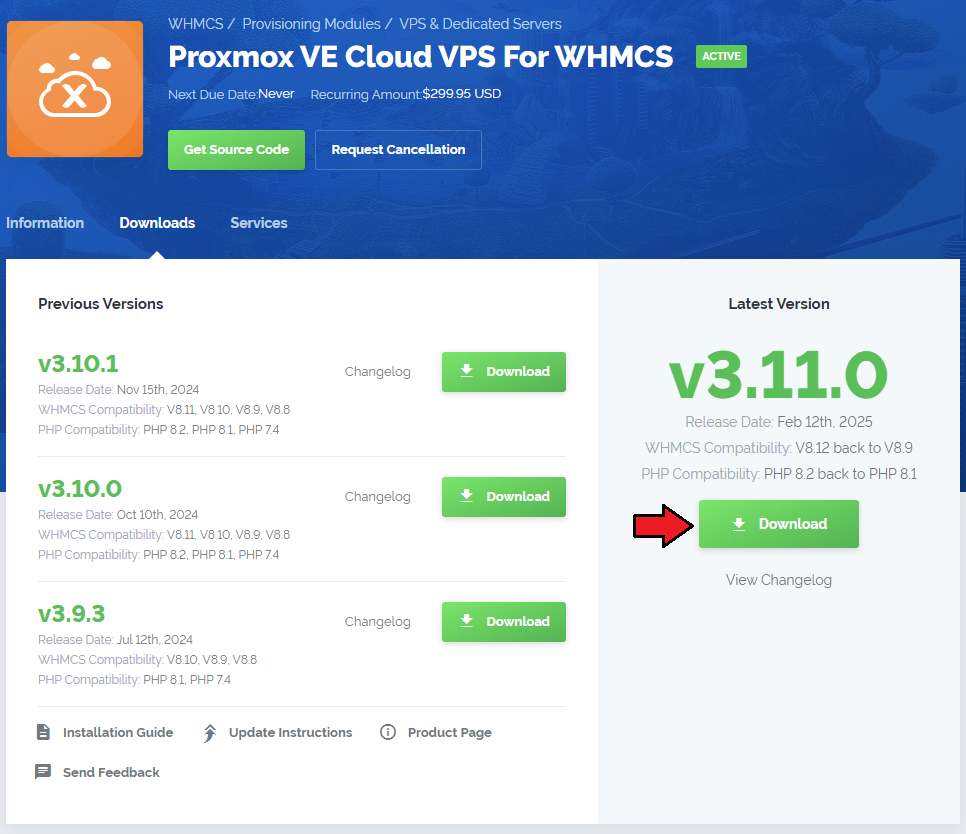
|
| 2. In the downloaded file you might find one or two packages that support different PHP versions. In the most recent versions of the module, you will find only one package that supports PHP 7.2 and later. |
| Previous updates of the module may contain two packages dedicated to various PHP versions. The first one that supports PHP 5.6 up to PHP 7.1, and the second one addressed to PHP 7.2 up to PHP 7.4. |

|
| Note: You can check the current PHP version in your WHMCS. To do so, proceed to 'Utilities' → 'System' → 'PHP Info'. |
| 3. Extract the package and upload its content into the main WHMCS directory.
The content of the package to upload should look like this. |

|
| 4. Open 'UploadOnProxmoxServer' and upload content of the proper version on all Proxmox servers into the '/' path. You should upload these files not only during the first installation of the module, but also each time you update it. Note: If you wish to allow noVNC consoles, you need to configure a product using the PVE realm and set user permissions to 'PVEVMUser.' |
| 5. When you install Proxmox Cloud VPS For WHMCS for the first time, you have to rename the 'license_RENAME.php' file. This file is located in 'modules/servers/proxmoxCloudVps/license_RENAME.php'. Rename it from 'license_RENAME.php' to 'license.php'. |
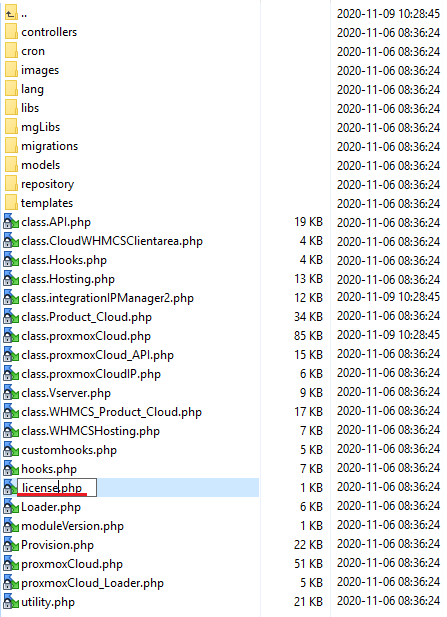
|
| 6. In order to configure your license key, you have to edit a previously renamed 'license.php' file. Enter your license key between quotation marks as presented on the following screen. |

|
| 7. In the next step, set up the 'storage' folder as recursively writable. This folder is available at: your_whmcs/modules/addons/proxmoxAddon/ |
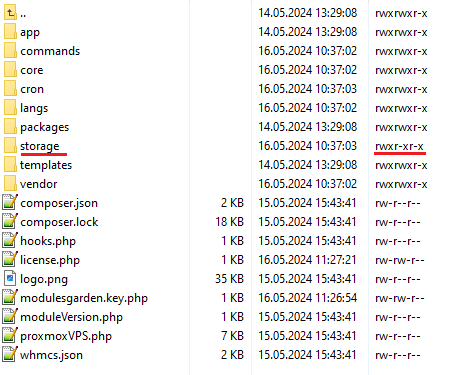
|
Activation of Proxmox Addon
| 8. Firstly, you should activate Proxmox Addon. To do so, log in into your WHMCS and press 'Setup' → 'Addon Modules'. Find 'Proxmox Addon' and press 'Activate'. Note: The Proxmox addon version might not match the current version of the provisioning module itself. This is completely normal due to the specific structure of the product. |
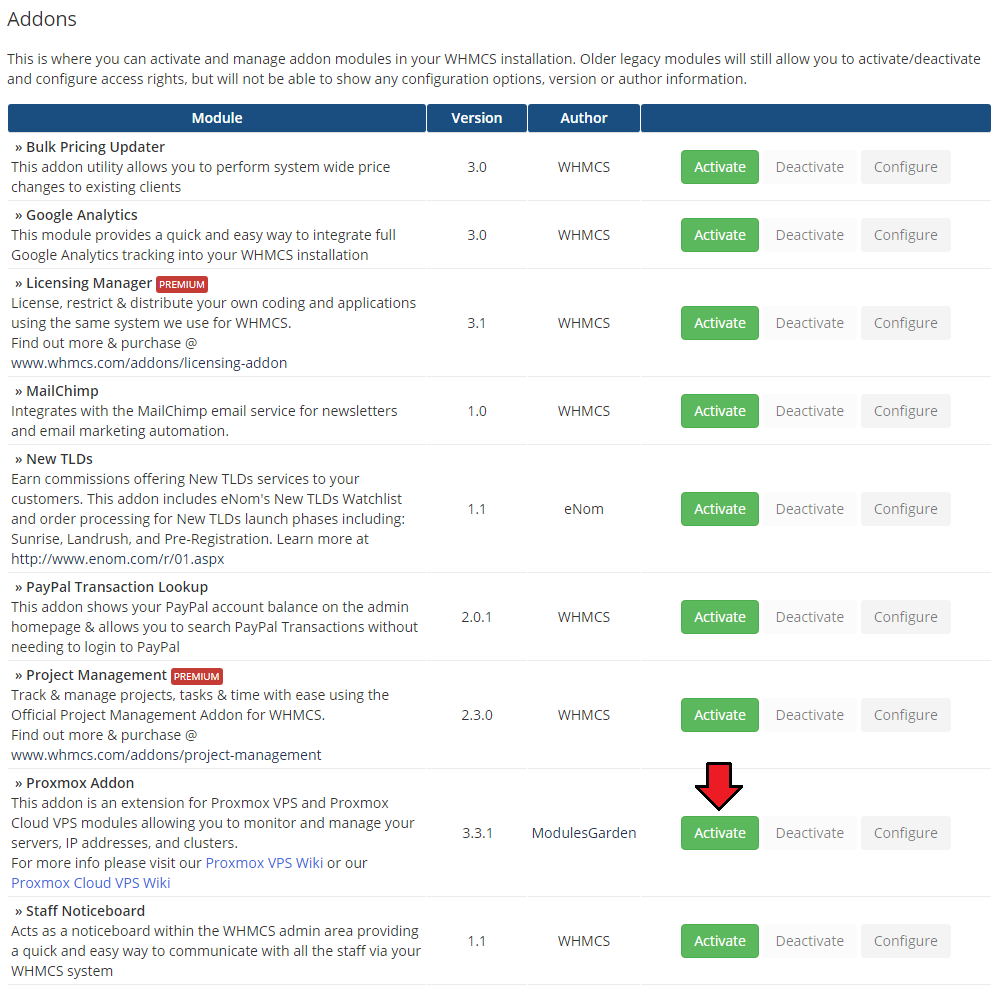
|
| 9. In the next step, you need to permit access to this module. To do so, click on the 'Configure' button. Tick 'Full Administrator' and press 'Save Changes'. |
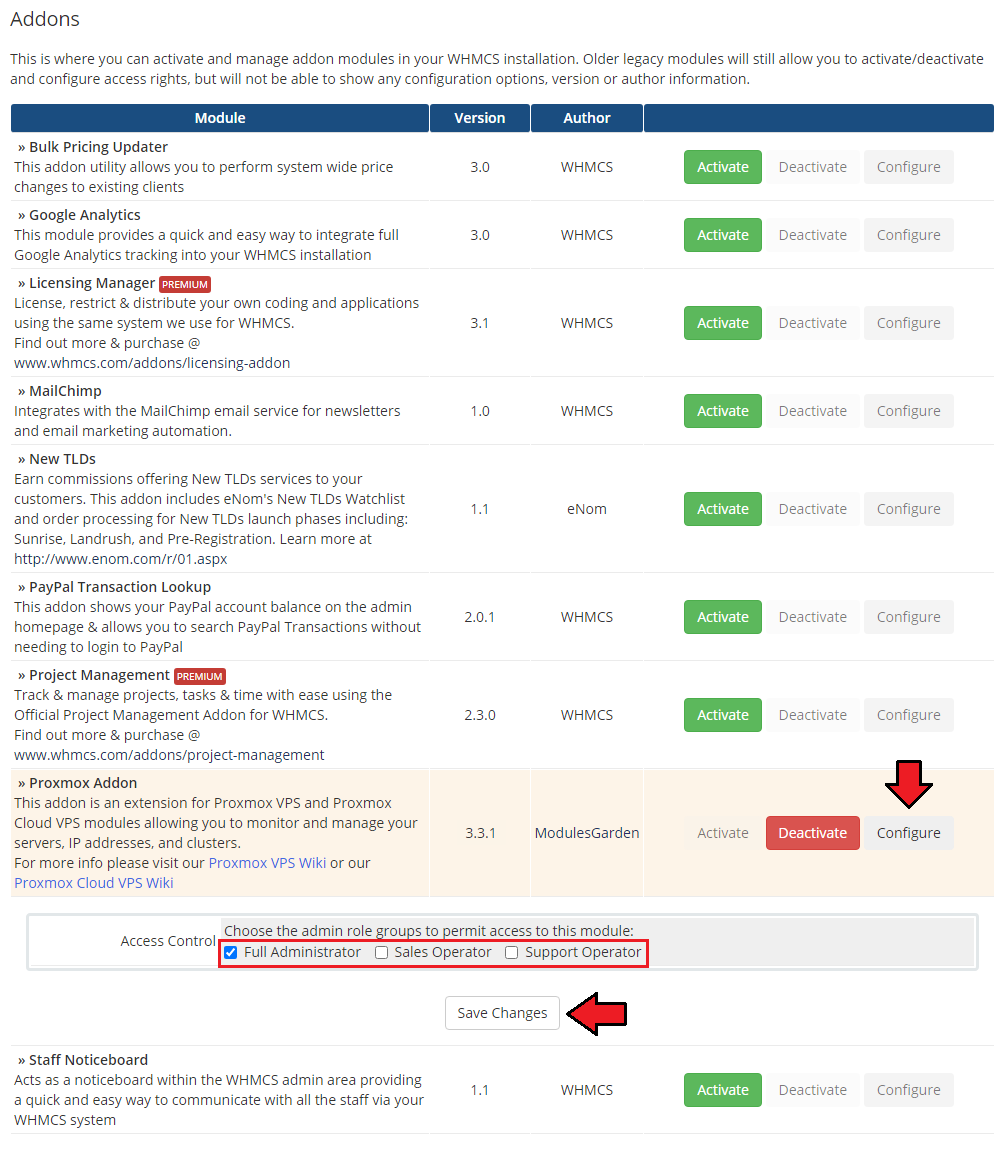
|
Configuration of Server
| 10. Now, we will show you how to configure a new product. Go to 'Setup' → 'Products/Services' → 'Servers' and press 'Add New Server'. |
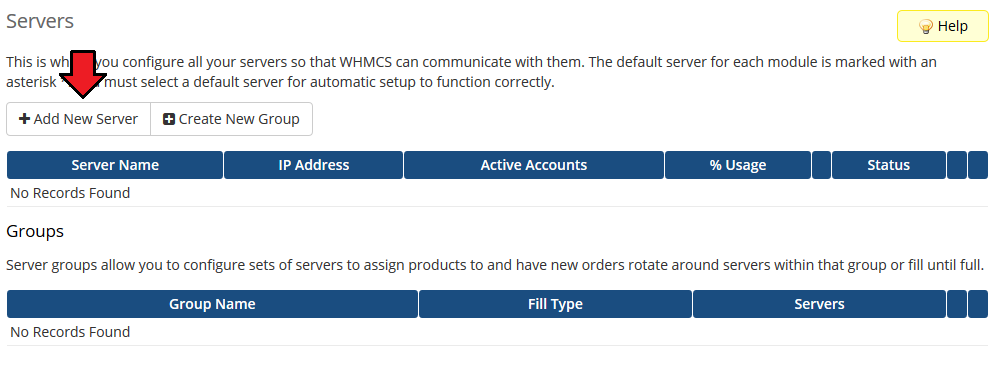
|
| 11. Next, enter your server name, IP address, username and password. Choose 'Proxmox Cloud VPS' from a dropdown menu and press 'Save Changes'. |
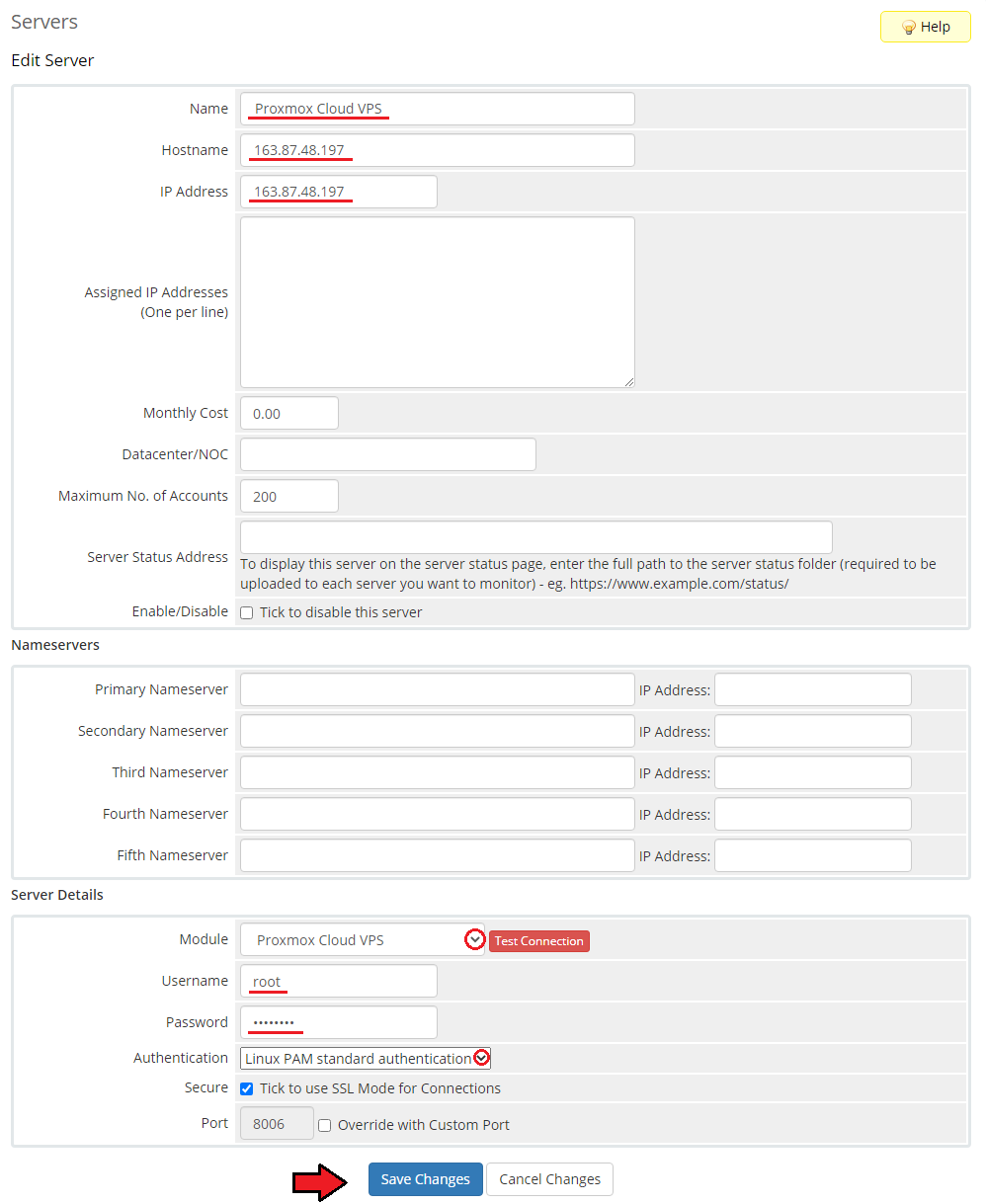
|
| 12. After you have configured your server correctly, you will see the following screen. You can check connection with the Proxmox server. To do so, simply press 'Test Connection' as shown on the screen below. |
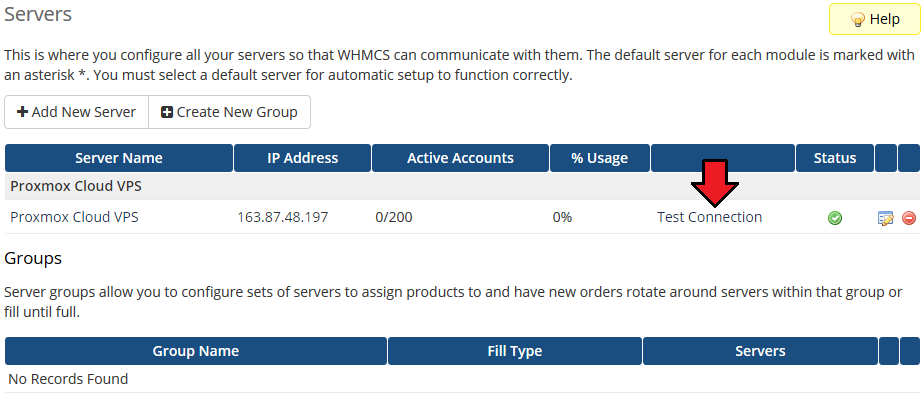
|
| 13. It is time to create a server group. To do so, click on 'Create New Group'. |
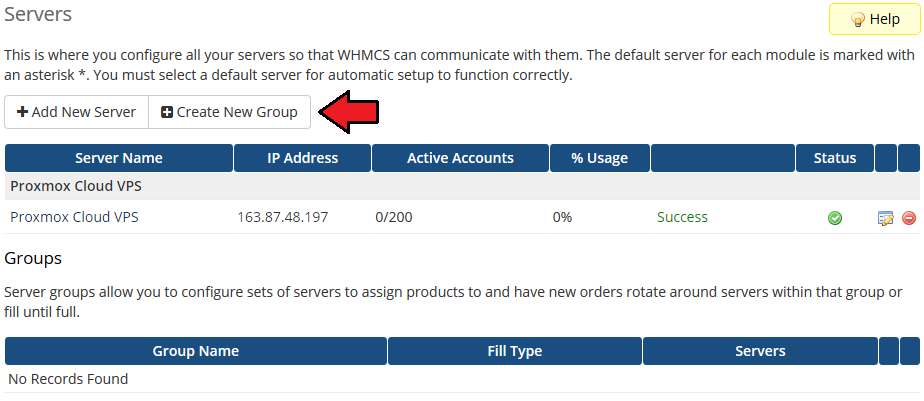
|
| 14. Enter name, click on your previously created server, press 'Add' and afterwards 'Save Changes'. |
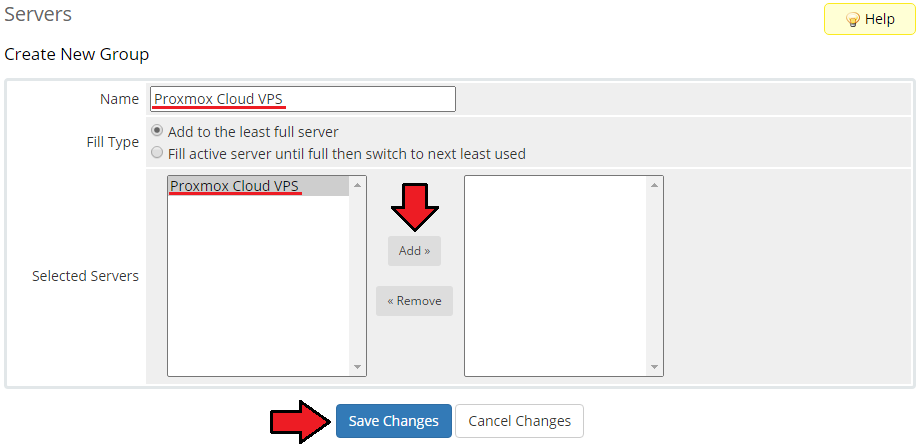
|
Configuration of Product
| 15. In order to create and configure a product, go to 'Setup' → 'Products/Services' → 'Products/Services'. Click on 'Create a New Group'. |

|
| 16. Enter the product group name and press 'Save Changes'. |
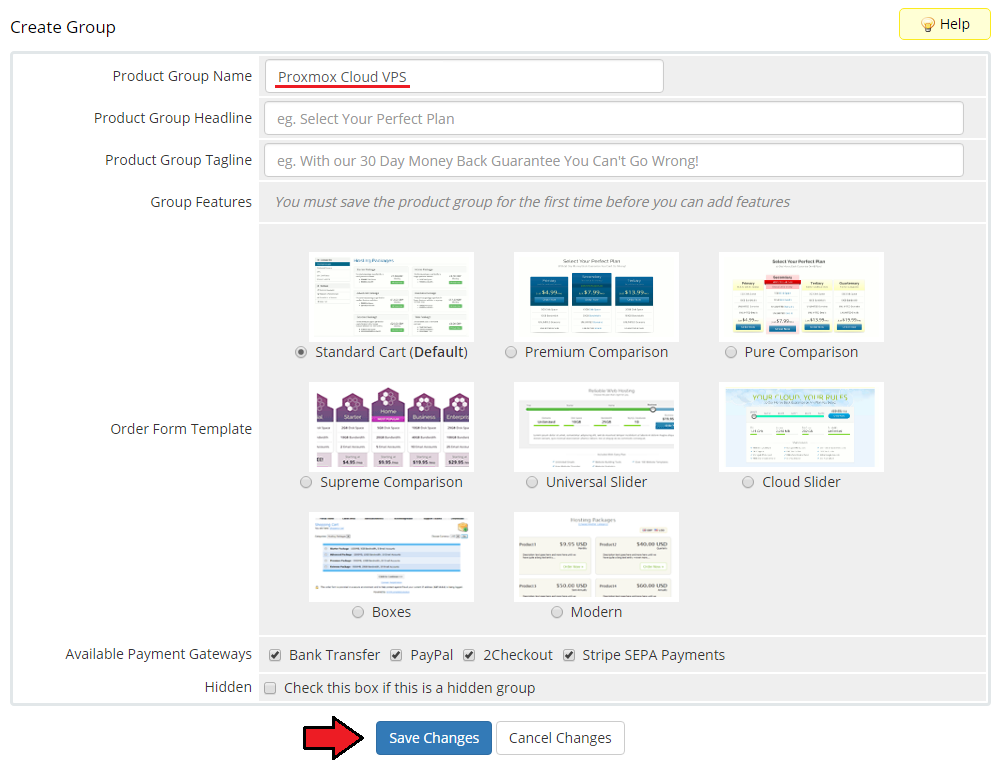
|
| 17. When you have a product group, you are able to create your product. To create a product, click on 'Create a New Product'. |

|
| 18. Afterward, choose your product group from dropdown menus and point its type, enter your product name and choose 'Proxmox Cloud VPS' as a module name. Press 'Continue'. 'Product Type' can be set to 'Server/VPS' but nameservers will need to be added later. |
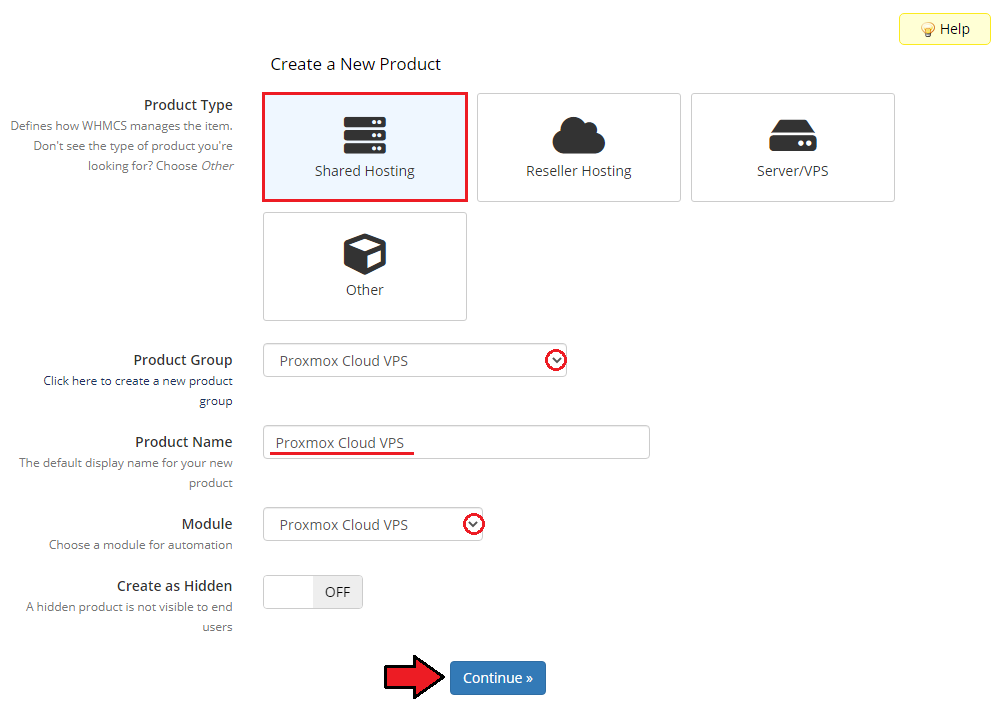
|
| 19. Now, go to the 'Module Settings' section and choose your previously created server group from the dropdown menu. Next, click on 'Save Changes'. |
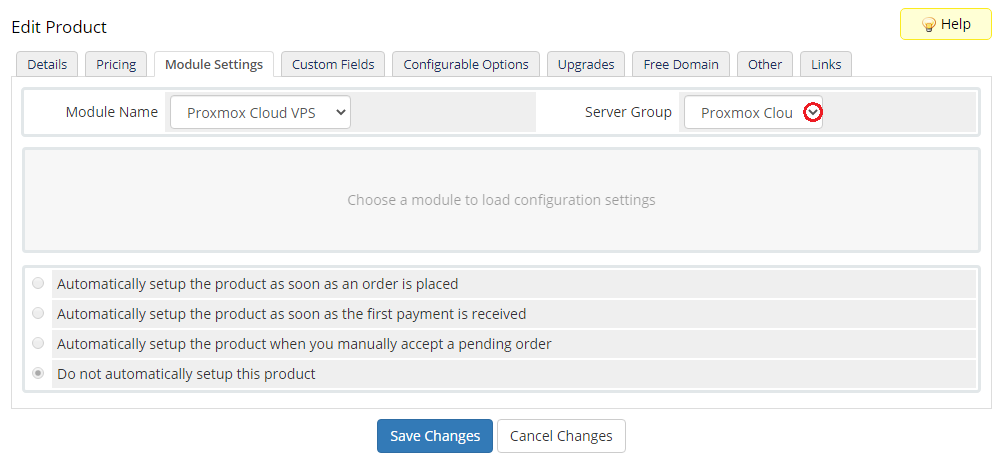
|
| 20. Firstly, choose 'Virtualization Type' from the dropdown menu. Then, proceed to the next section which is 'Main Configuration' and set proper values here. Available virtualization types:
You can also choose how often the bandwidth usage should be calculated. |
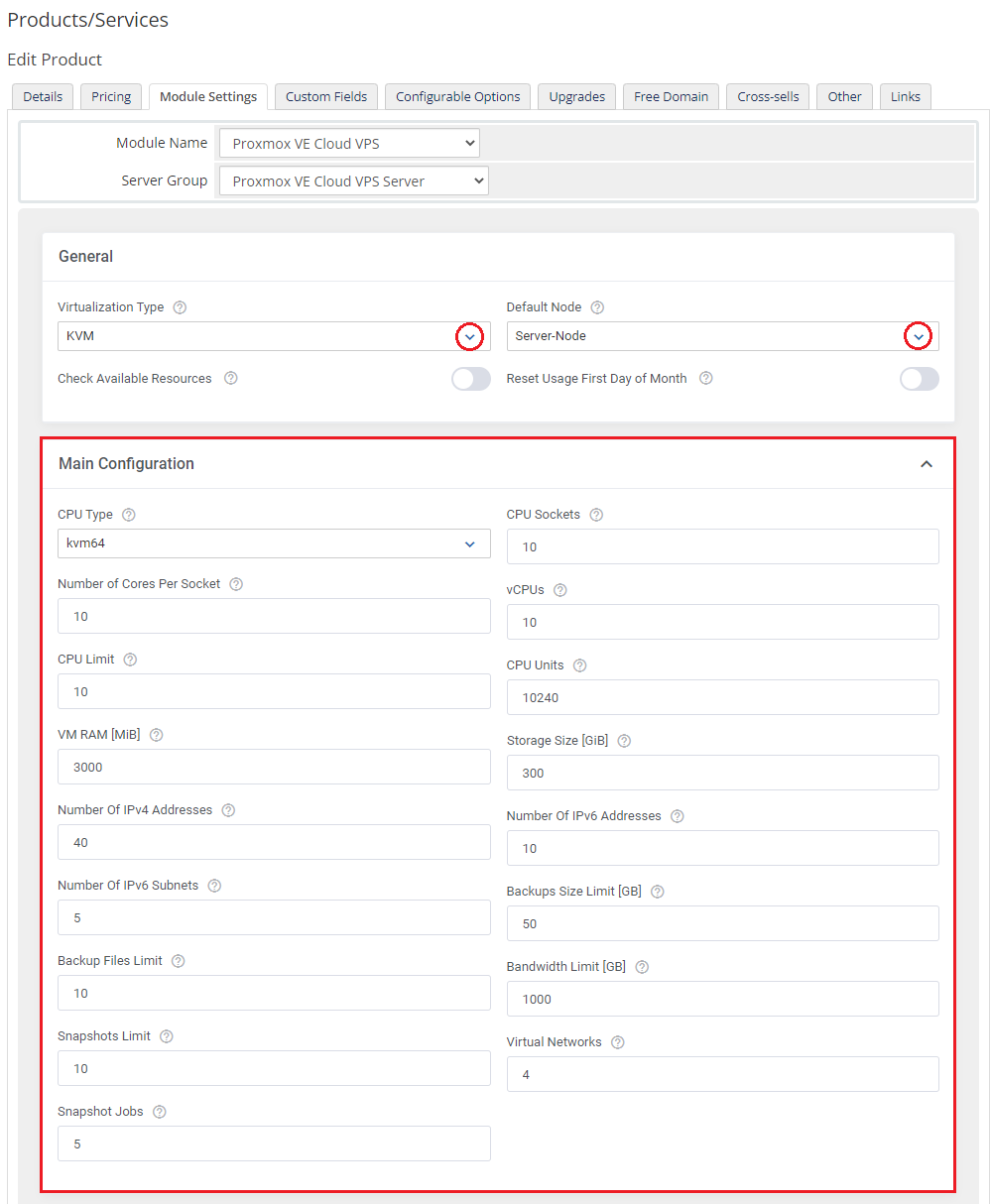
|
KVM Virtualization Type
| 21. The setting of the KVM virtualization type (skip this step if you have chosen the LXC virtualization type). There are a few sections underlined that need your attention. Please, complete carefully the 'KVM Configuration' , 'Additional Disks' , 'Client Area Features' sections. |

|
LXC Virtualization Type
| 22. Setting of the LXC virtualization type (skip this step if you have chosen the KVM virtualization type). Firstly, complete the 'General' configuration and then proceed to the 'Main Configuration' , 'LXC Configuration' , 'Network' , and 'Client Area Features' sections. |

|
Finalizing The Configuration
23. Private Network Management - in order to allow clients to manage their private networks, set up the 'Network' section properly.
Note: Configure these three options for the KVM and LXC virtualization. |
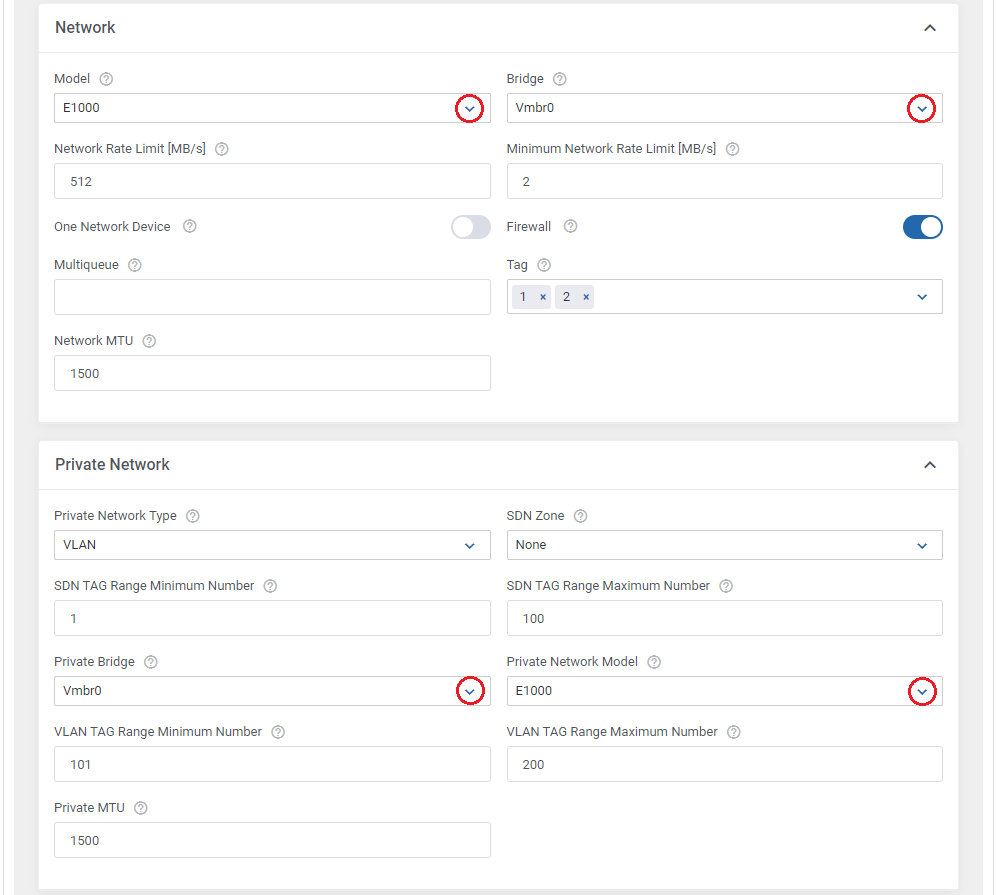
|
| 24. The next step is setting up the configuration of backups. Define backup settings in the 'Backup' section through defining 'Storage' and enabling 'Backups Routing' . |
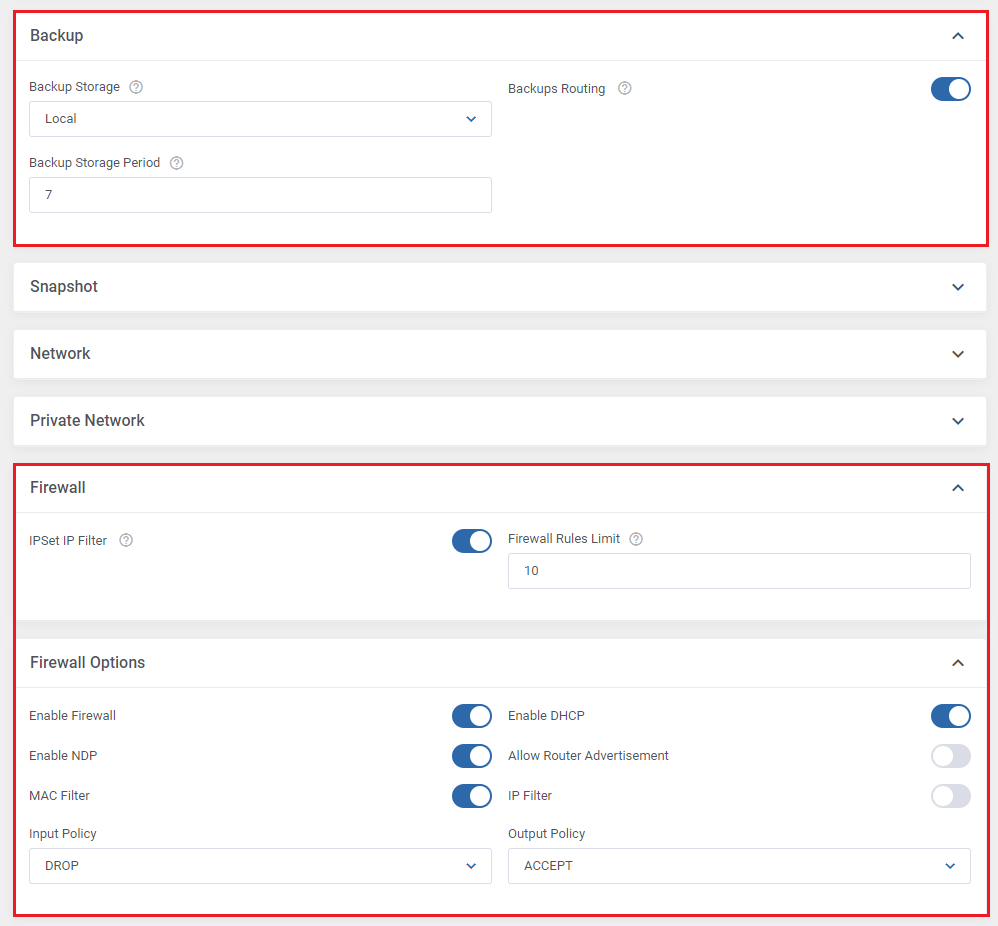
|
| 25. Set up server limits to control the size of created servers. |
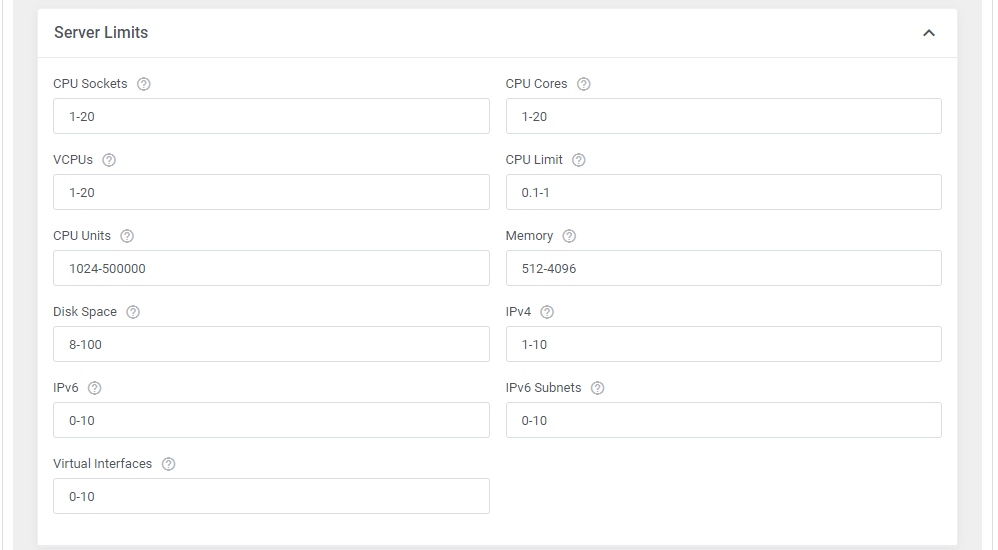
|
| 26. The final step is generating 'Configurable Options' . Click on the 'Create Configurable Options' button. |
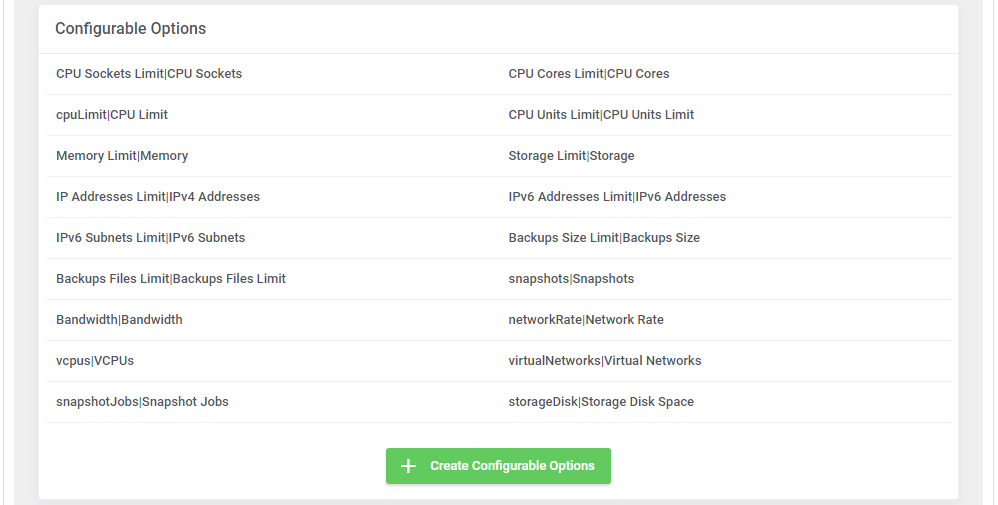
|
| Now, you may decide which options should be generated for your product. Adjust configurable options to your needs and press 'Confirm' . |
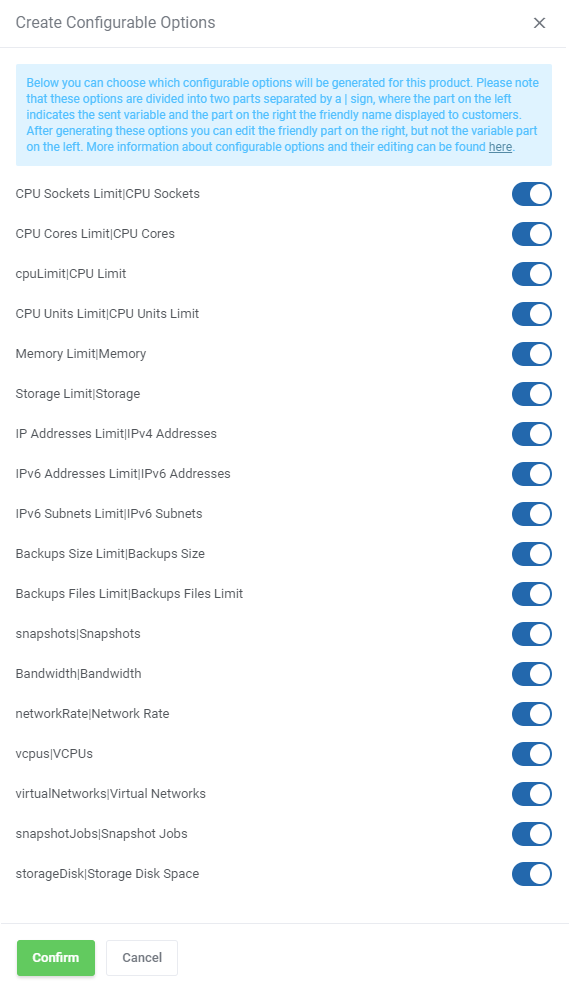
|
27. In the end of the product configuration, you have to add a cron job that is shown below (5 minutes interval suggested).
php -q /your_whmcs/modules/servers/proxmoxCloudVps/cron/cron.php Do not forget to replace 'your_whmcs' with your WHMCS root location. |
| Congratulations! You have just finished the installation and configuration of the module. |
Configuration of Addon
| 28. Proceed to 'Addons' → 'Proxmox Addon' → 'Settings' → 'General Settings' and set up cron jobs listed under the 'Cron' section. Please note that there are separate cron jobs dedicated to Proxmox VPS and Proxmox Cloud VPS modules - these jobs are the most important to assure fluent work of the modules, suggested frequency is 5 minutes.
|
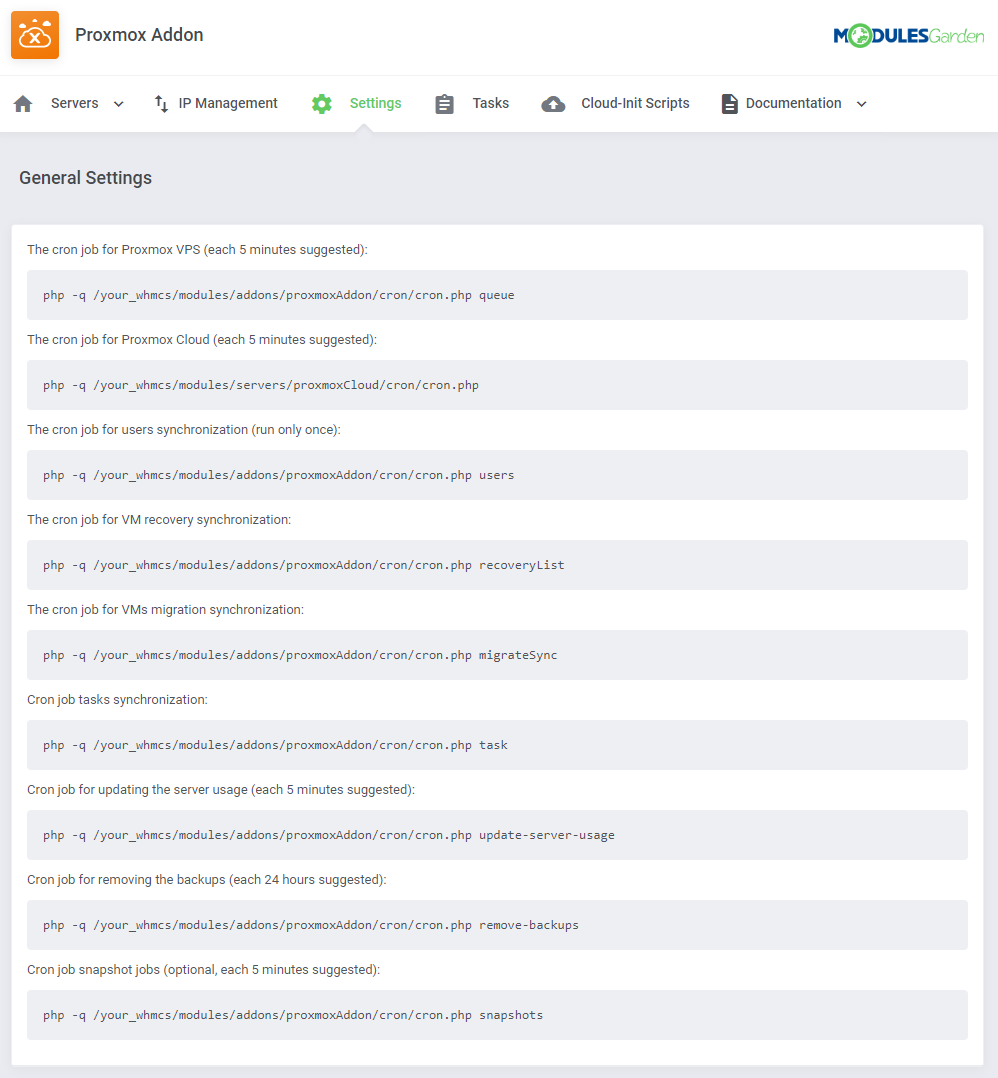
|
| 29. Next, under the Cron settings, find the 'Minimum VMID' field. Fill it in with a number that will be used as an ID of the first VM, the second VM will be asigned the next ID number. Here it is also possible to turn on 'Debug Mode' if you need to register module logs. |

|
| 30. Adding a new IP address (if you are not using IP Manager For WHMCS). In order to create a new product, you have to add 'Dedicated IP ' to the 'IP Addresses' list in 'Proxmox' addon module. |
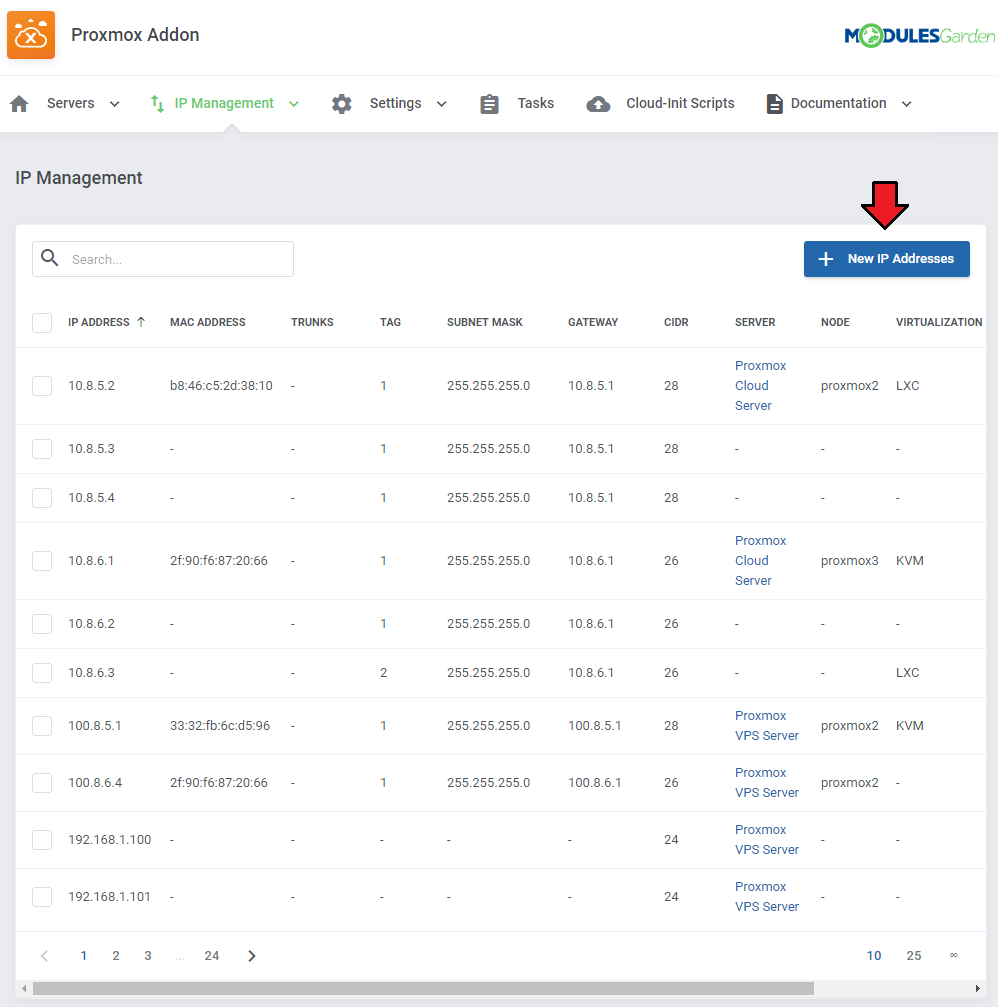
|
| 31. Start by typing a desired IP address and mask into 'IP Pool'. Next, choose a server from the 'Server' dropdown menu and define which virtualization it should be applied to through selecting it from the 'Virtualization' dropdown menu. |
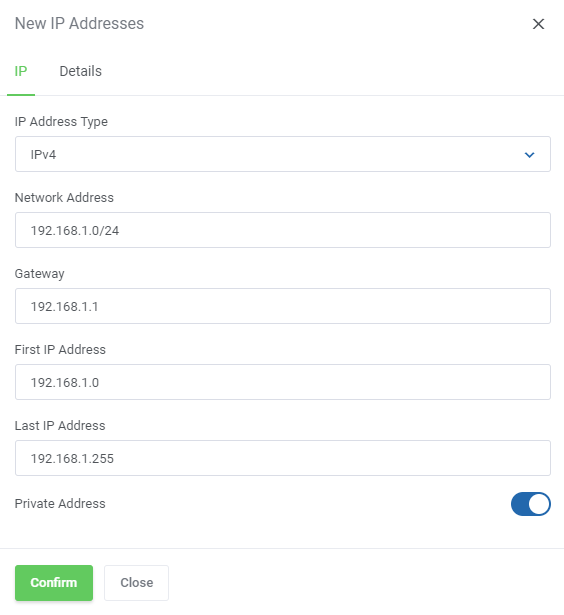
|
| 32. You are now able to create new virtual machines at the product. The client area of a successfully created product should look similar to the one presented on the screen below. |
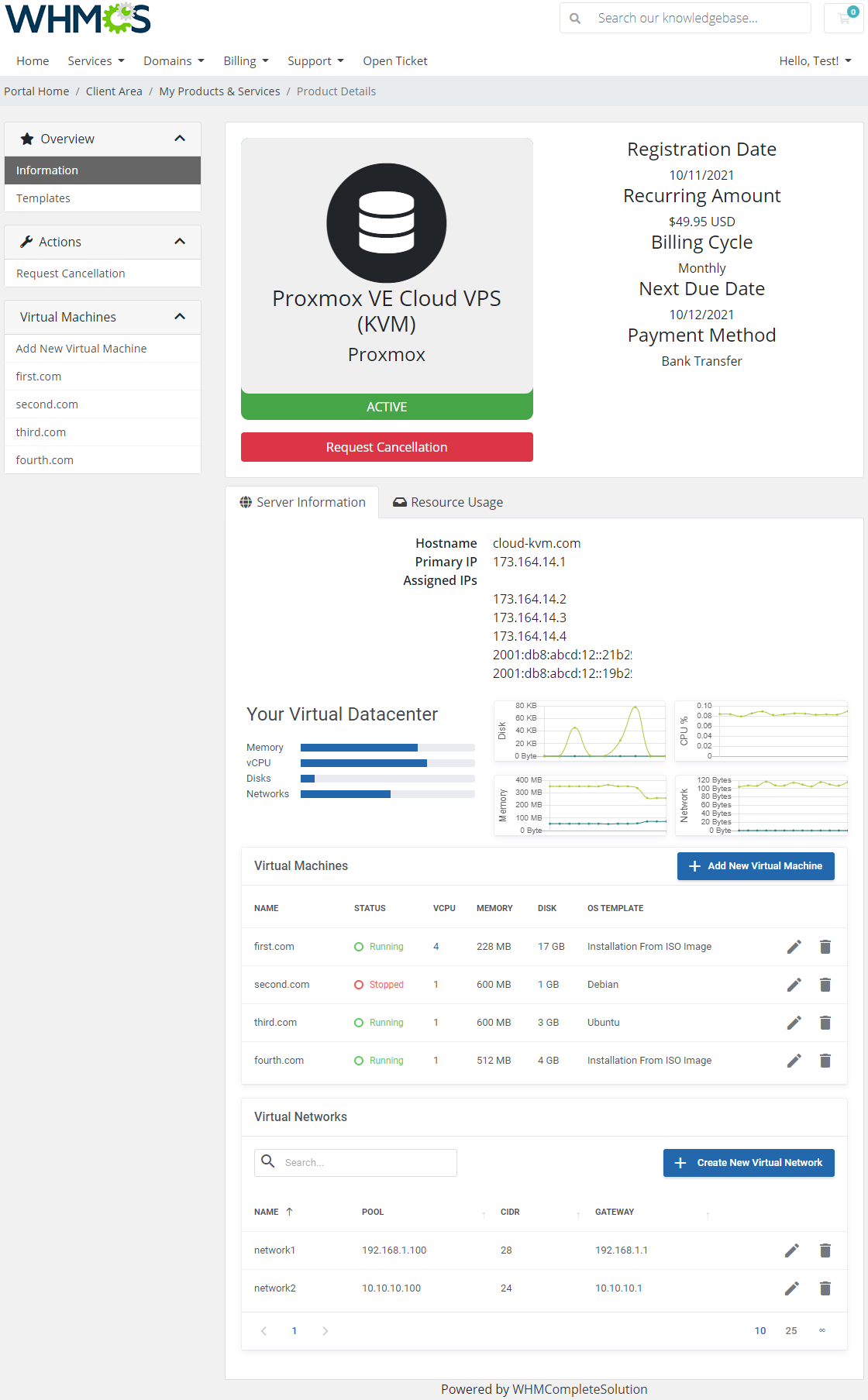
|
Cloud-Init (KVM)
| Use Cloud-Init to configure the system during installation, first-boot and package change. Cloud-Init was initially developed to provide early initialization of cloud instances. Click here to learn more about Cloud-Init configuration. Note: Cloud-Init functionality is supported for the KVM virtualization only. |
Custom Configuration In Addon
Cloud-Init Scripts
| The Cloud-Init Scripts section allows adding ready scripts that will be available to choose from in the products' configuration page. The selected there script will be used while crating the virtual machine. Press 'Add New' to manually add your script. |
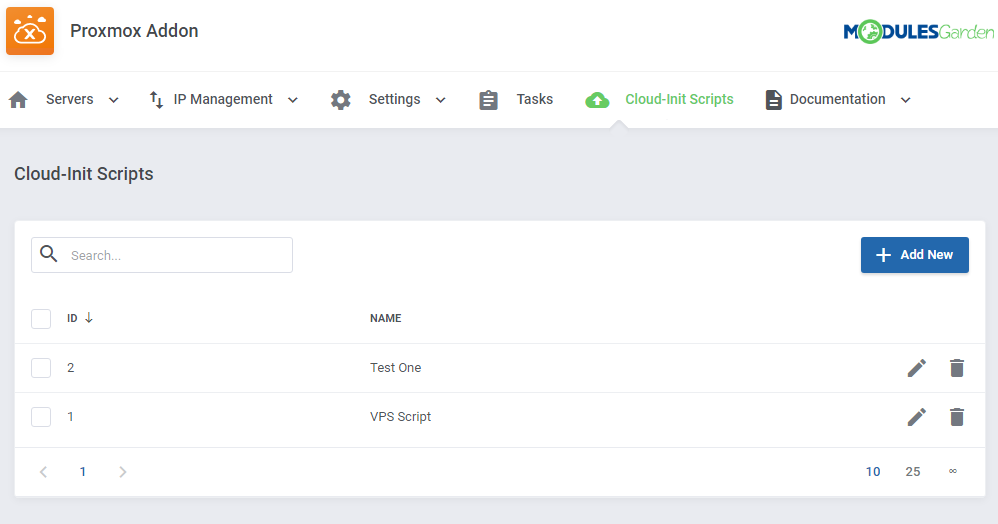
|
Name your new Cloud-Init script and type in or paste a ready configuration. The configuration must include:
Here is an exemplary configuration of a Cloud-Init script. You may alter it to fit your settings and paste into the 'Script' ' field: #cloud-config
hostname: {$domain}
manage_etc_hosts: true
fqdn: {$domain}
user: {$username}
password: {$passwordHash}
chpasswd:
expire: False
users:
- default
package_upgrade: true
|
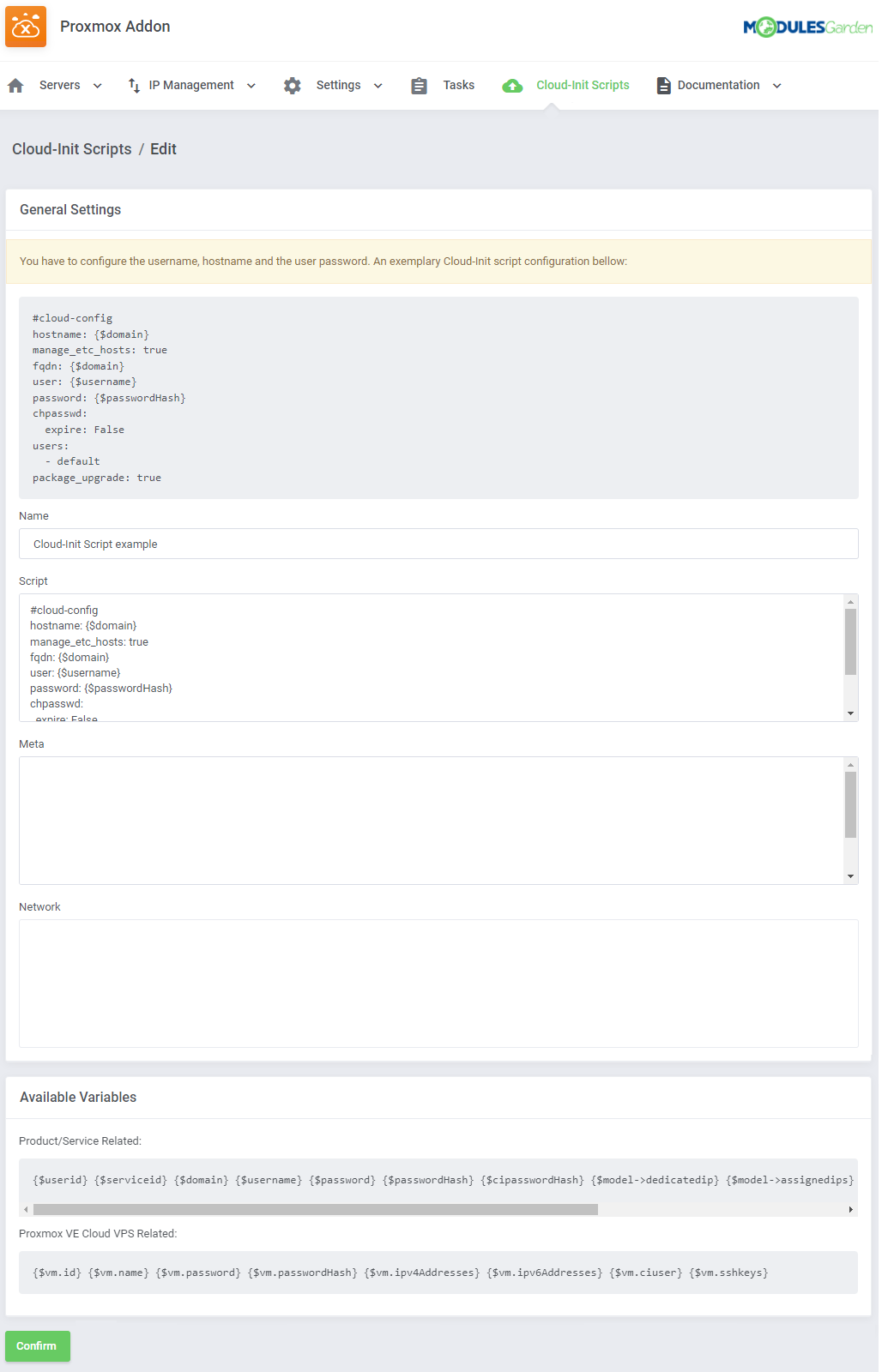
|
A full list of available variables related to a Proxmox Cloud VPS type of the product/service:
{$vm.id} {$vm.name} {$vm.password} {$vm.passwordHash} {$vm.ipv4Addresses} {$vm.ipv6Addresses} {$vm.ciuser} {$vm.sshkeys}
|
| Manage created Cloud-Init scripts, edit/delete singe scripts or use mass action to delete numerous scripts. |
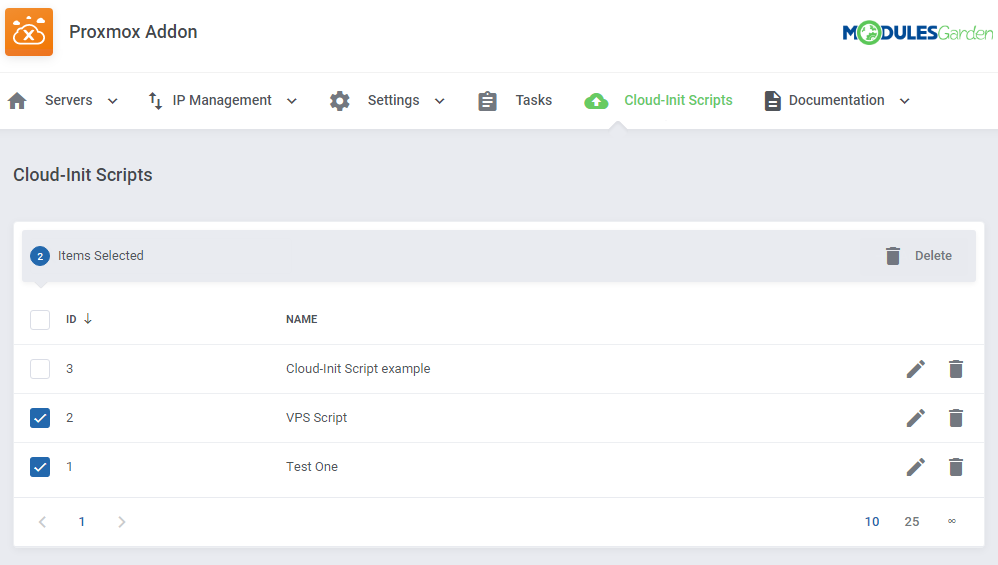
|
Server Details
| In order to use the Cloud-Init successfully, you need to also provide SSH details to let the script send the IP addresses to the Proxmox server. Move to Servers → Servers List → Details → Settings, there you will find fields that are responsible for the correct SSH connection.
You also have to select the 'Snippet Storage' to locate the Cloud-Init script in the correct catalog. |
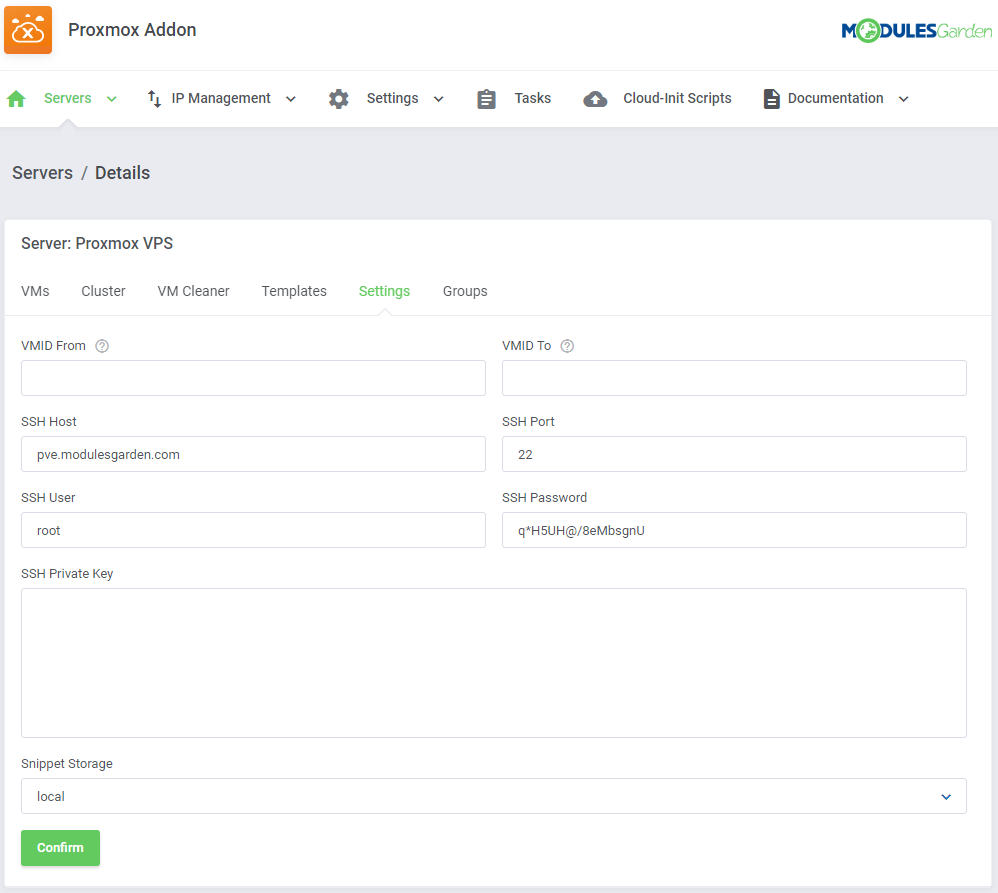
|
Configuration Of Product
| To to allow you clients to use cloud-init you need to enable it in the Proxmox product configuration. Before you start we recommend learning the details about cloud-init configuration on your Proxmox server - click here for more details.
|
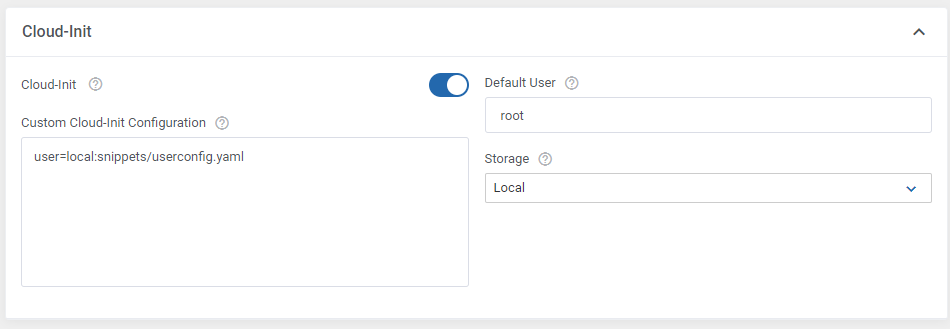
|
| Among other client area features, find 'Cloud-Init Script' and select the scripts that your clinets will be allowed to choose from when creating a new virtual machine. |
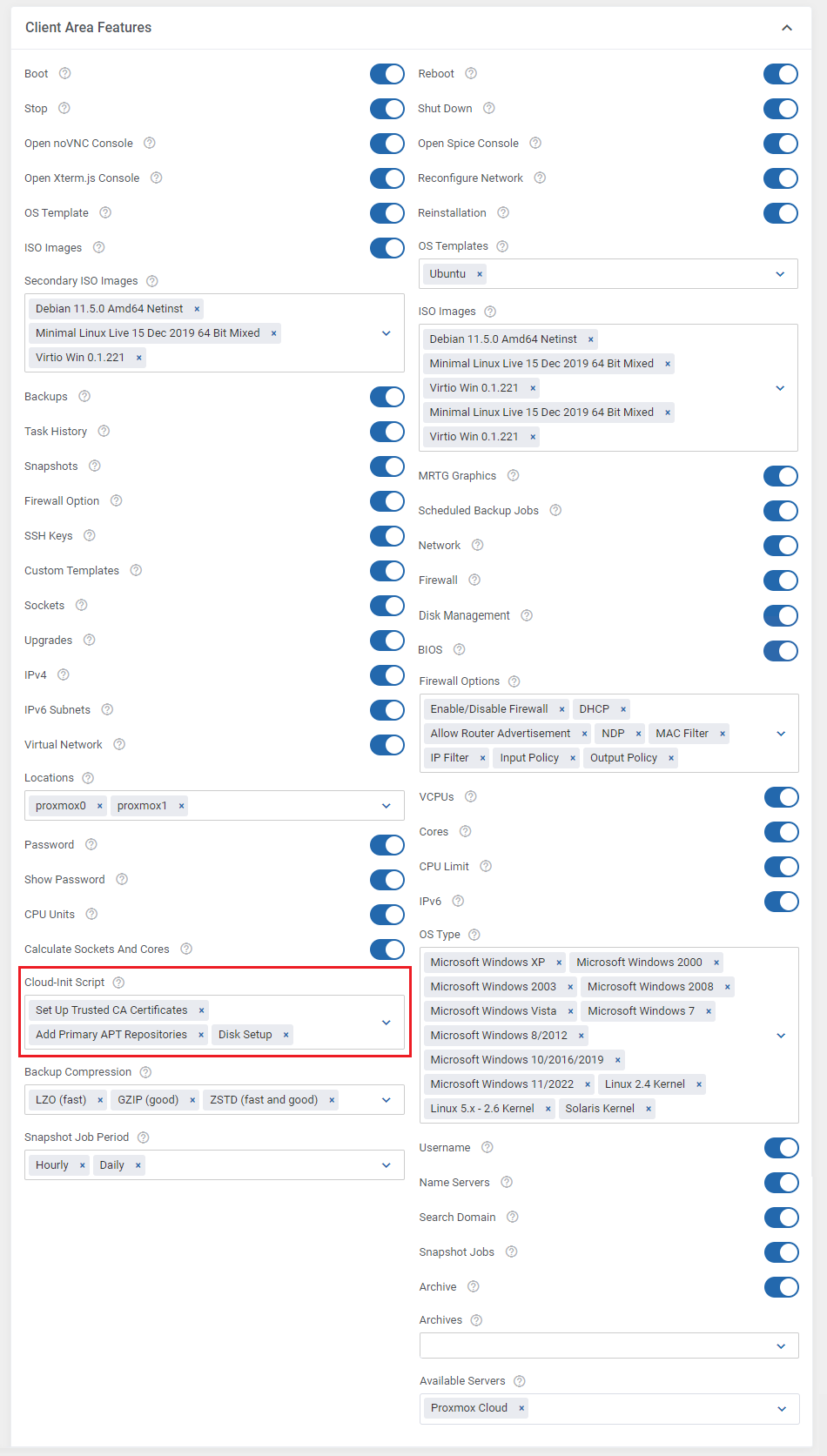
|
Configuration Of Proxmox Server
| The process of setting up Cloud-Init on the Proxmox server is described here. Additionally, you can use the following commands that can be useful for debugging.
rm -rf /var/lib/cloud/sem/* /var/lib/cloud/instance /var/lib/cloud/instances/* && cloud-init init && cloud-init modules -m final
cat /var/log/cloud-init.log cat /var/log/cloud-init-output.log |
Management
| Proxmox Cloud VPS For WHMCS allows your customers to manage their PVE servers in the WHMCS client area. At the same time, you can monitor and handle each product from your WHMCS admin area.
|
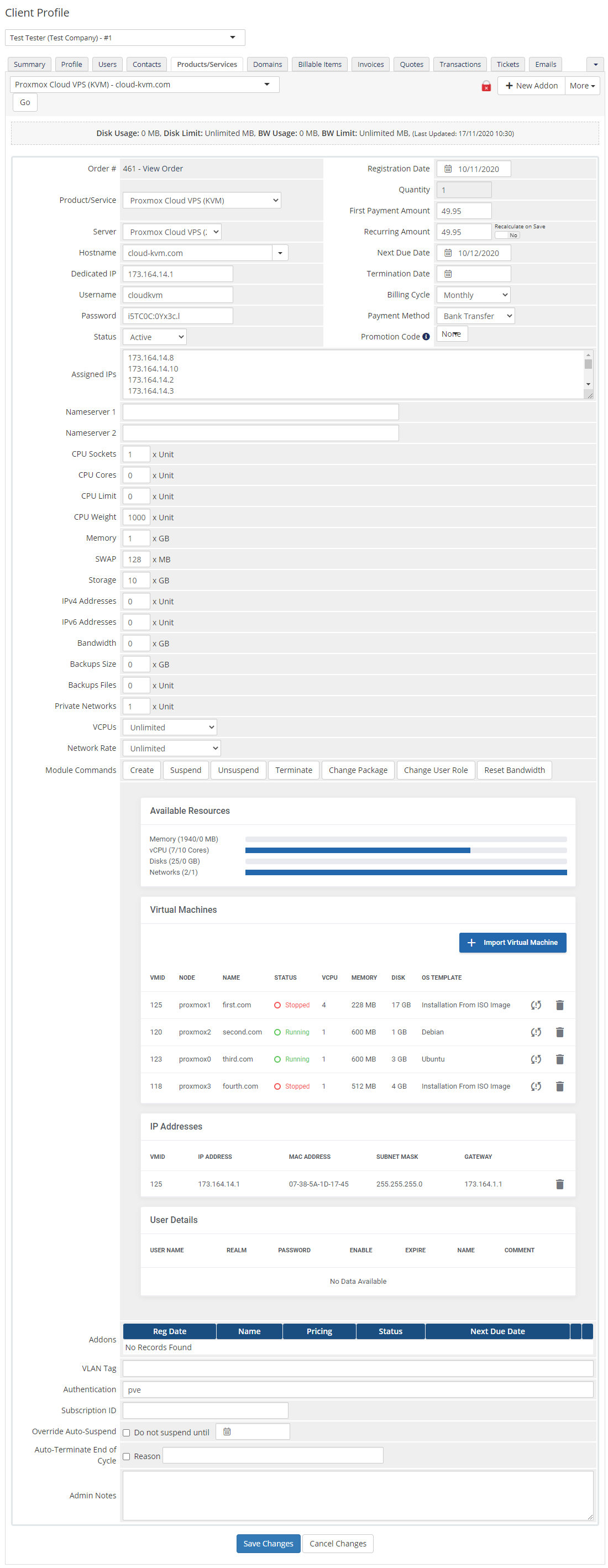
|
Management of Addon
Servers Management
Servers List
| In 'Addons' → 'Proxmox Addon' → 'Servers' → 'Servers List' you can find the configured Proxmox servers. RAM details:
Suspended - number of suspended accounts per size in MB E.g.: (1/500 MB) when there is only one suspended account (occupying 500MB of that account) assigned to Proxmox VPS server. |
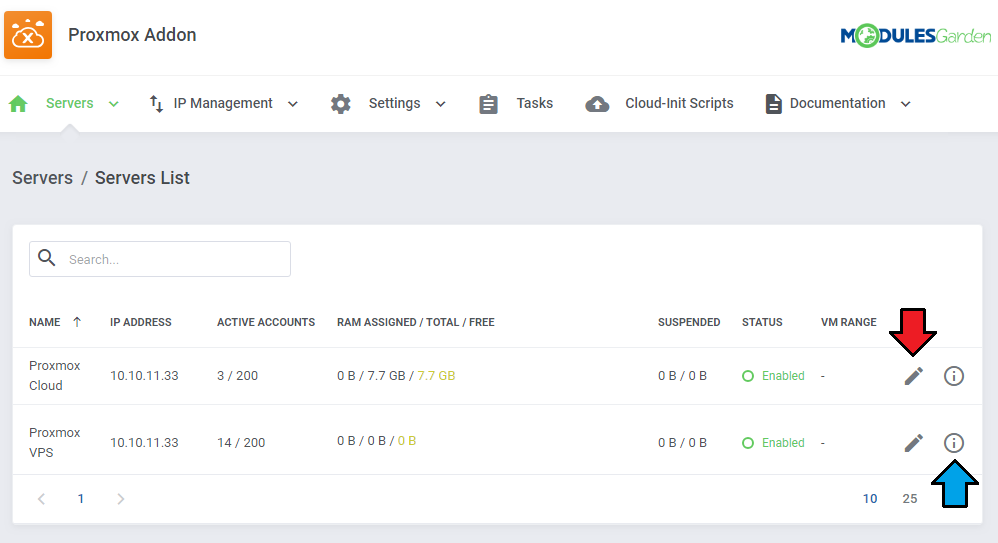
|
| Through pressing 'Edit' icon you will be moved to the server edit page - see point number 10 of Server Configuration. Press 'More Details' icon and you will get extended information on the selected server. See below for more details. |
VMs
| The 'VMs' tab includes a list of created virtual machines on this server. Take a quick look at information on domain, status, bandwidth and IP addresses. To view information about a VM, simply press the more info icon. |
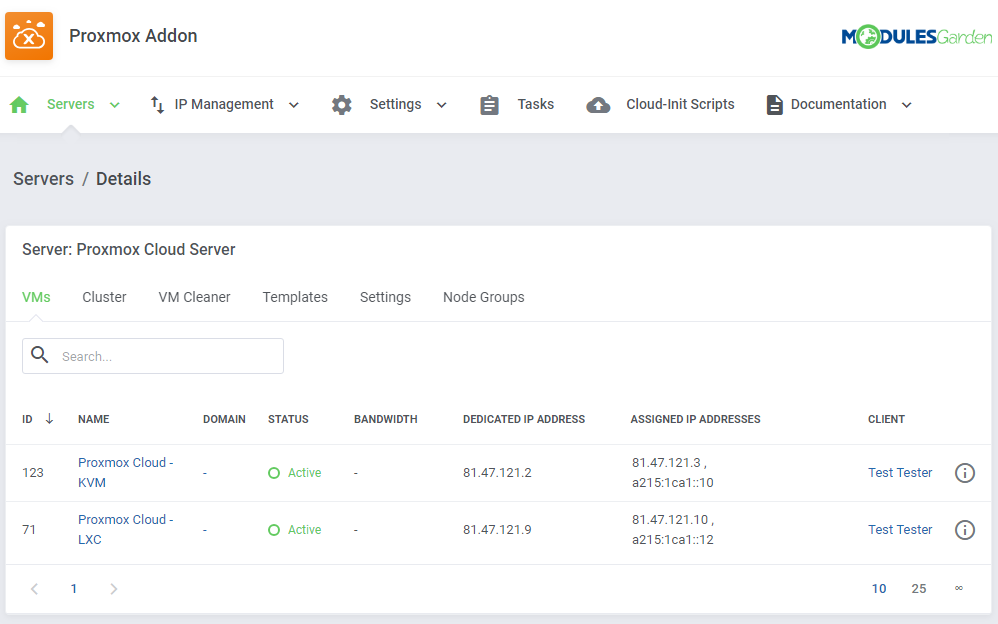
|
| Check the node and VMID: |
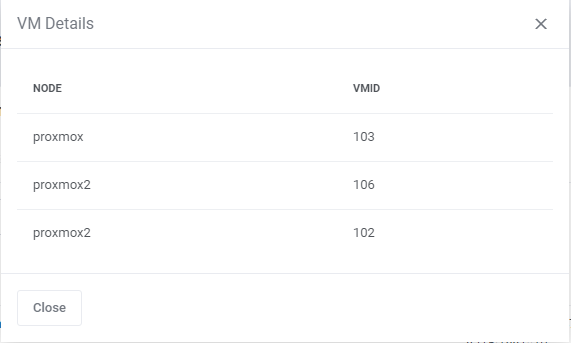
|
Clusters
| The next tab contains the list of clusters with information on uptime, CPU as well as CPU, SWAP, memory and disk usage data. |
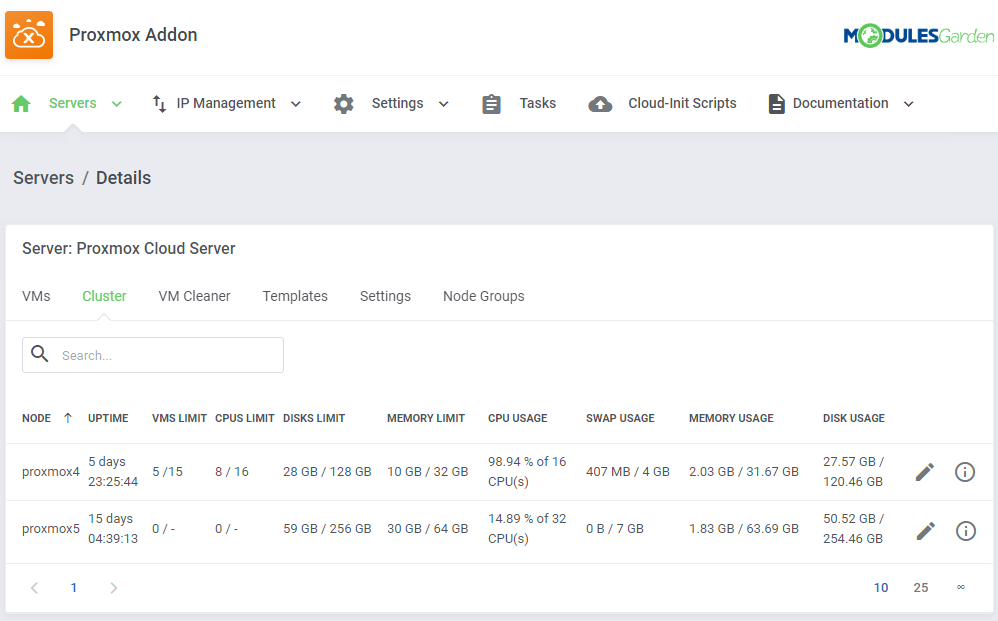
|
| Press the Edit icon to manage the node: |
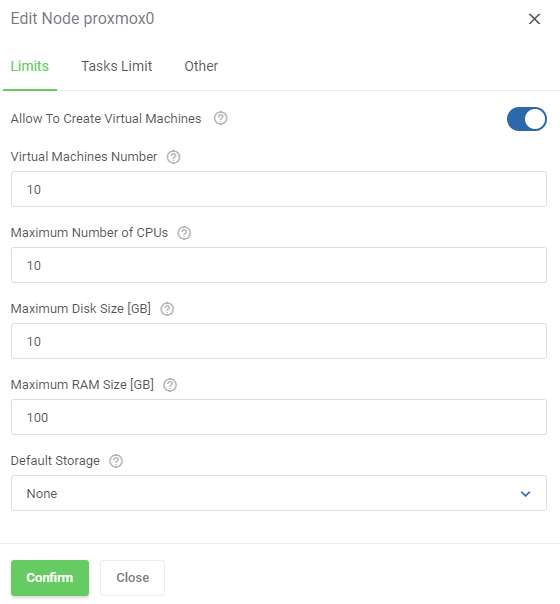
|
| Press 'Node Details' and you will get all the summary and usage graphs: |
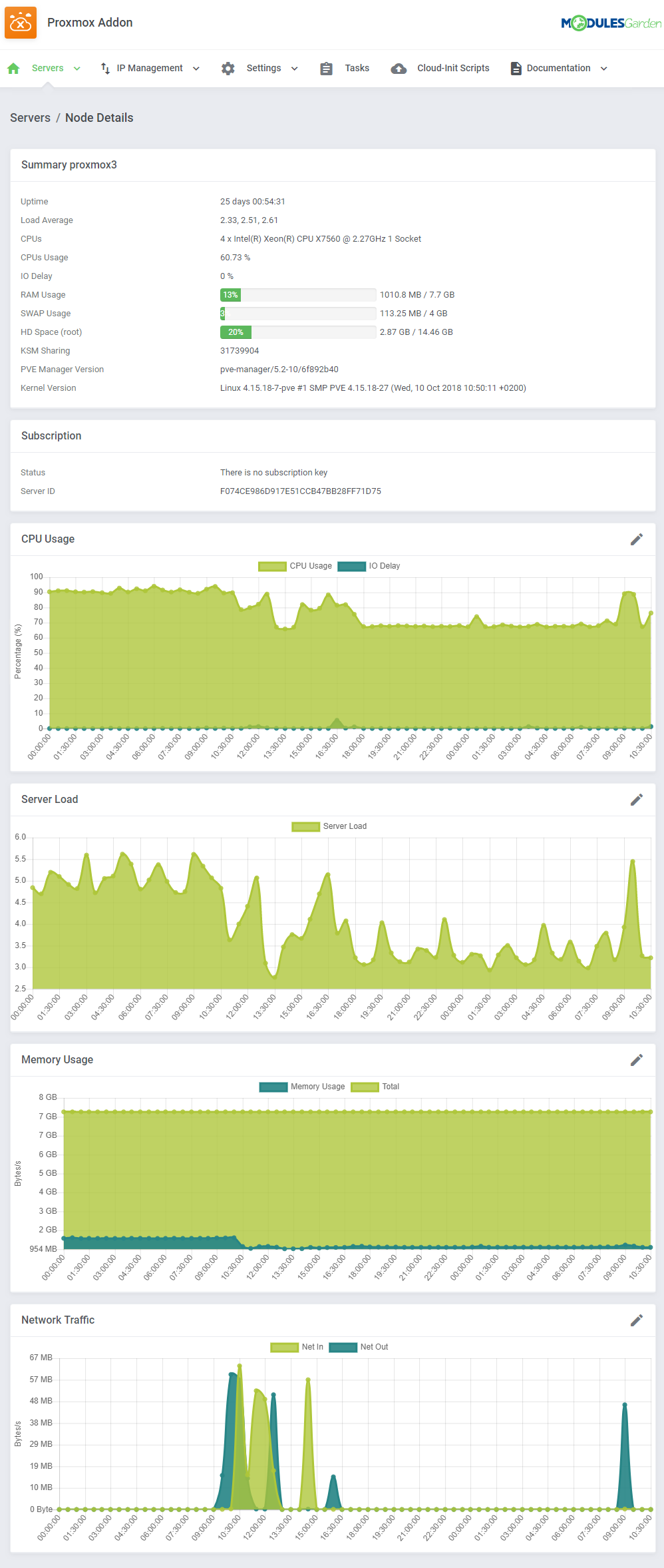
|
VM Cleaner
| VM Cleaner allows you to track VMs existing only on your Proxmox server and that are not visible in your WHMCS. Consequently, you are allowed to sort and delete only those VMs that cannot be managed from your WHMCS. |
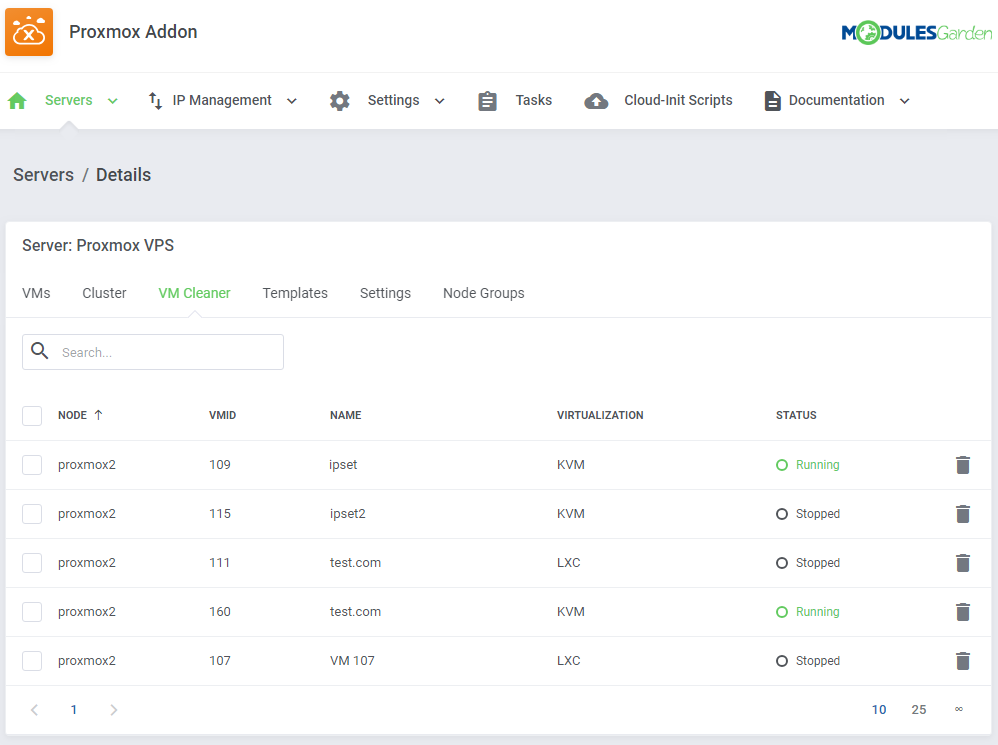
|
Templates
| Under this page you can view the list of templates. You can easily convert any KVM VM on your server to a template. In order to convert a VM, press 'Create Template' button. |
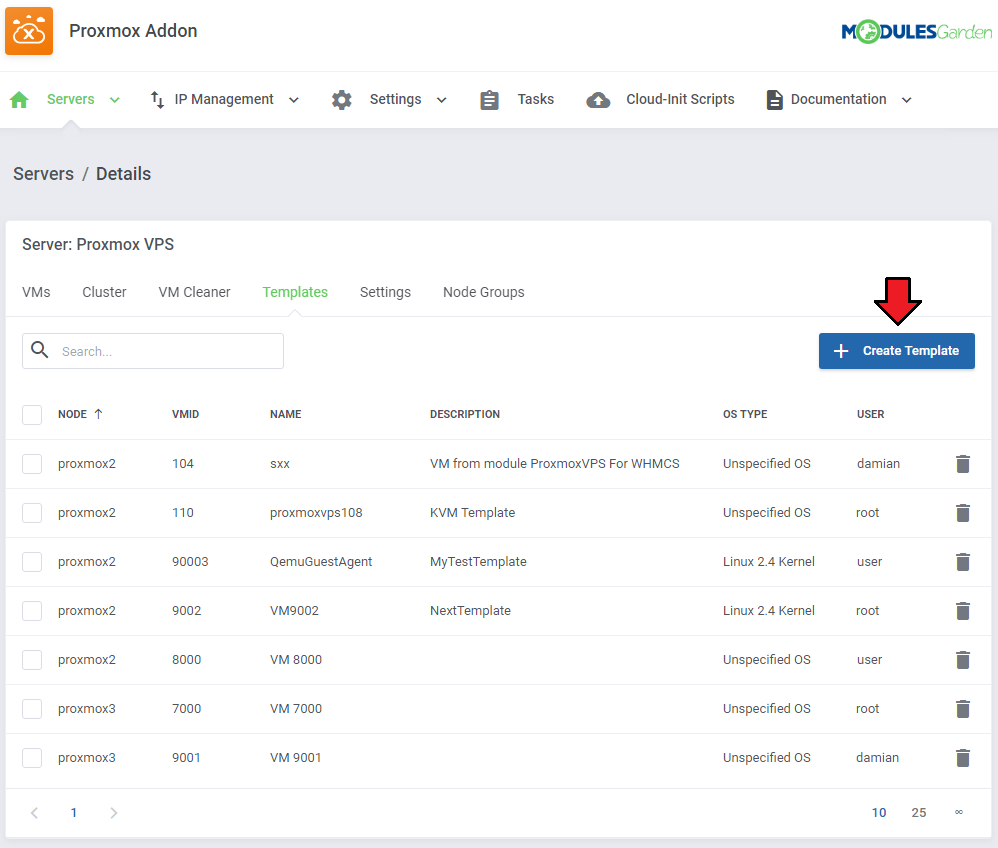
|
| Next, choose a VM to convert. Fill out 'Description' field and press 'confirm'. |
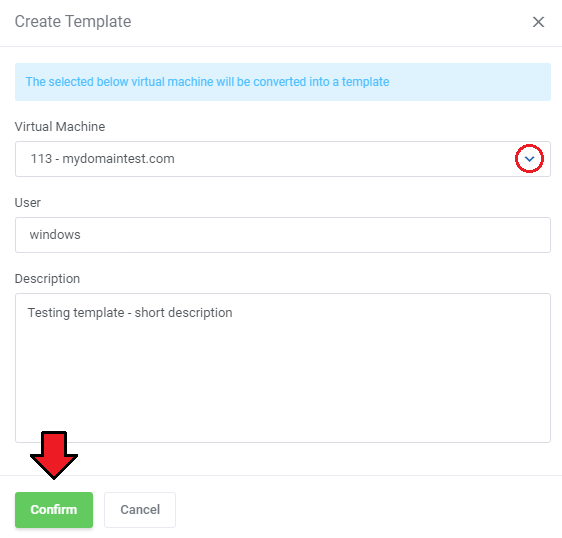
|
| You may also delete unused templates here. Delete single templates or use the mass action to delete templates in bulk. |
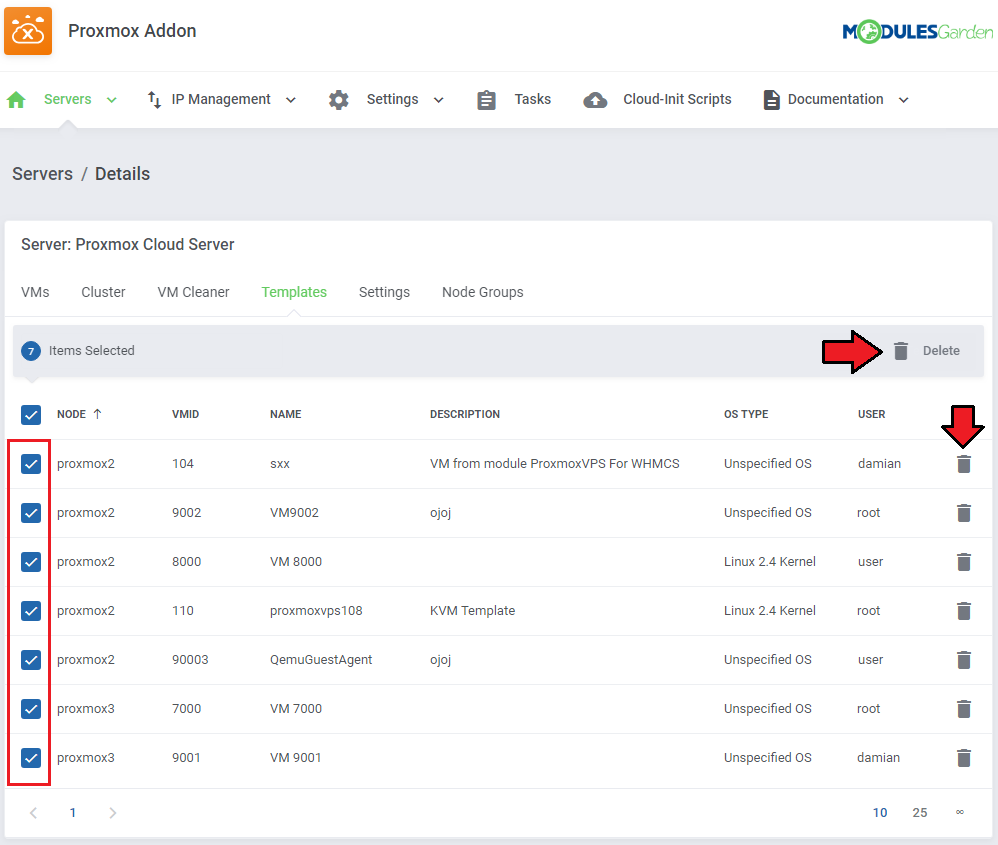
|
Settings
| Here you can define the VM IDs range that will be used for newly created VMs on this server. Please note that to use this feature, you also need to enable the "Use VM Ranges" setting in the product configuration. Define ID range and save changes. Note: VM ID range allows you to sort created VMs depending on the server they were created on. |
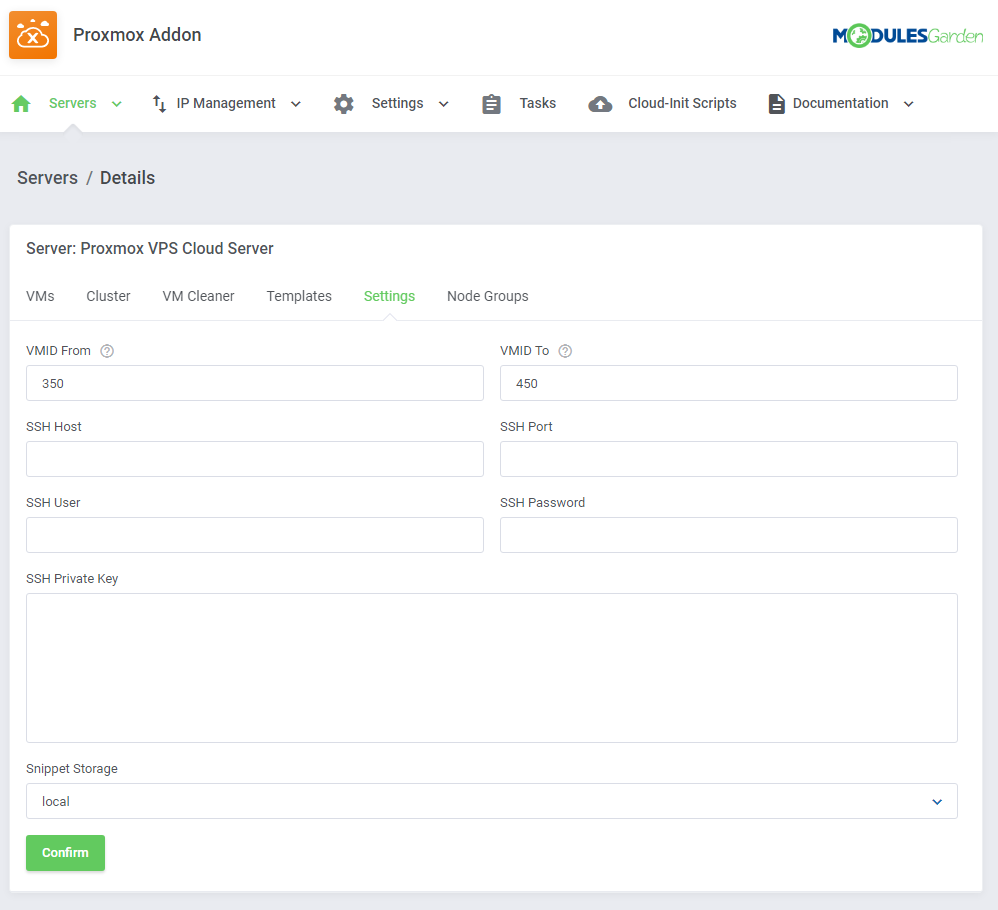
|
Node Groups
| Under the 'Node Groups' subsection, you can create new groups and assign nodes to them. |
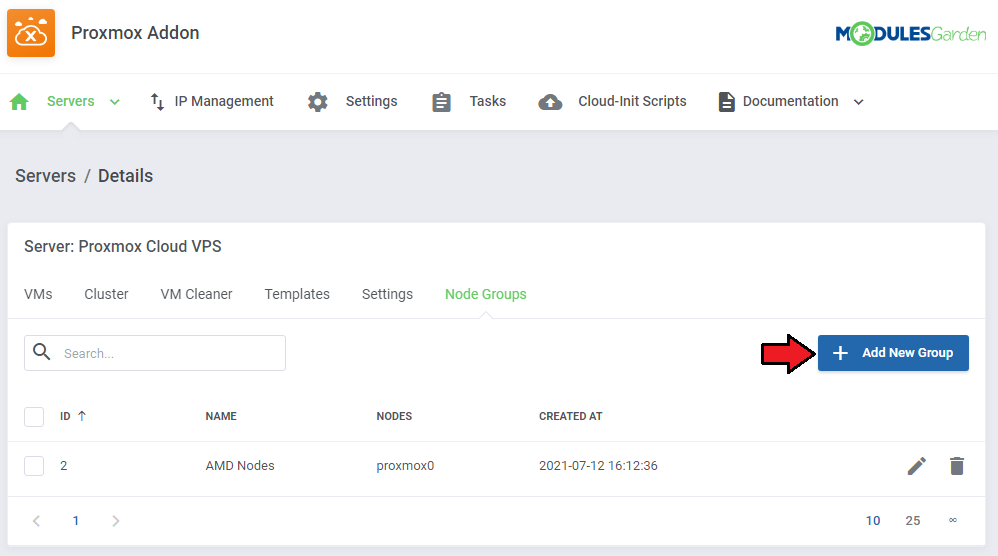
|
| Provide a name of your group and allot preferred nodes from the dropdown menu. |
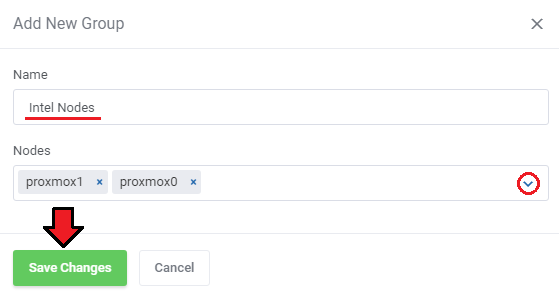
|
| Now, navigate to the 'Module Settings' of your product and find the 'Load Balancer' section. Here you can select one or more of the previously created groups. |

|
VMs List
| In 'Addons' → 'Proxmox Addon' → 'Servers' → 'VMs List' you can find details of any Proxmox product. |
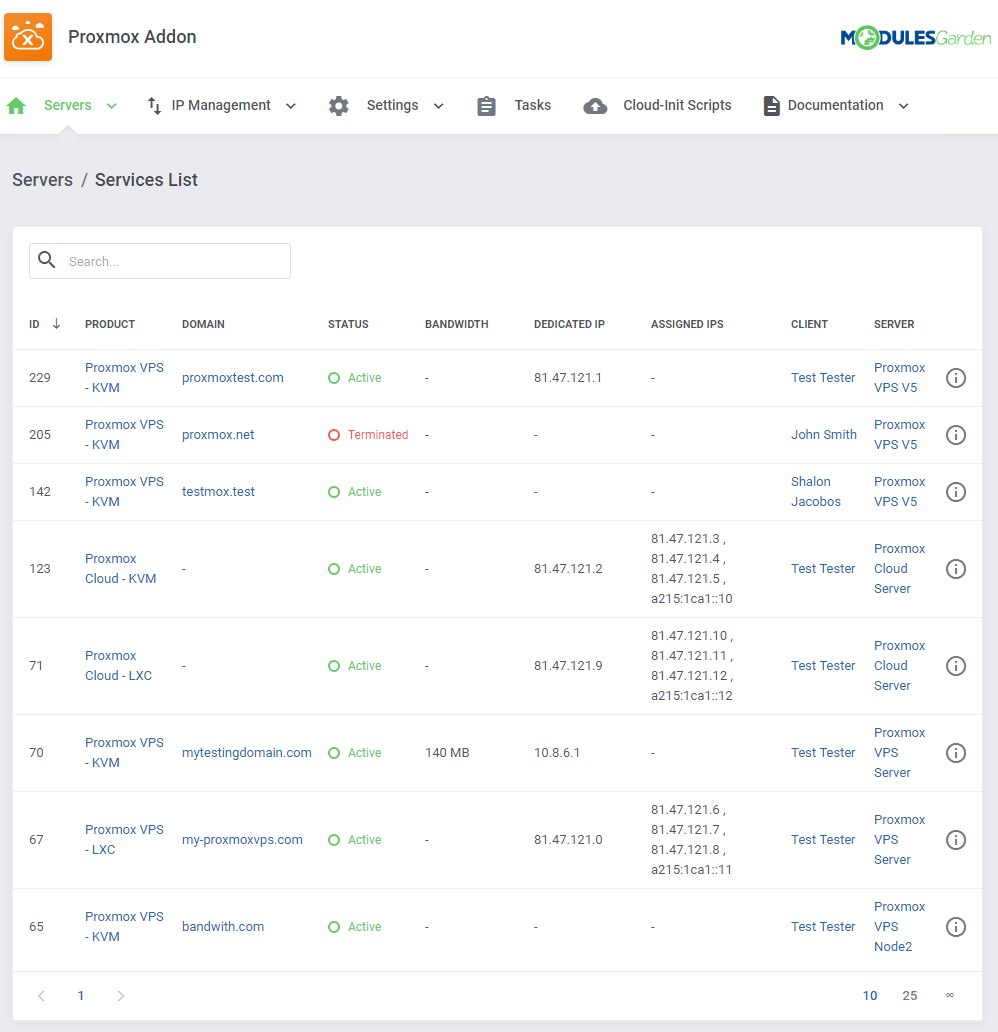
|
| Press 'More Details' button to get the node and VMID information. |

|
Recovery VM Lists
| In 'Addons' → 'Proxmox Addon' → 'Servers' → 'Recovery VM List' you can details on the created VM. Run the 'VM recovery synchronization' cron job to create and store full backups of VMs configuration, you can find it at point no 26 of the configuration instructions. |
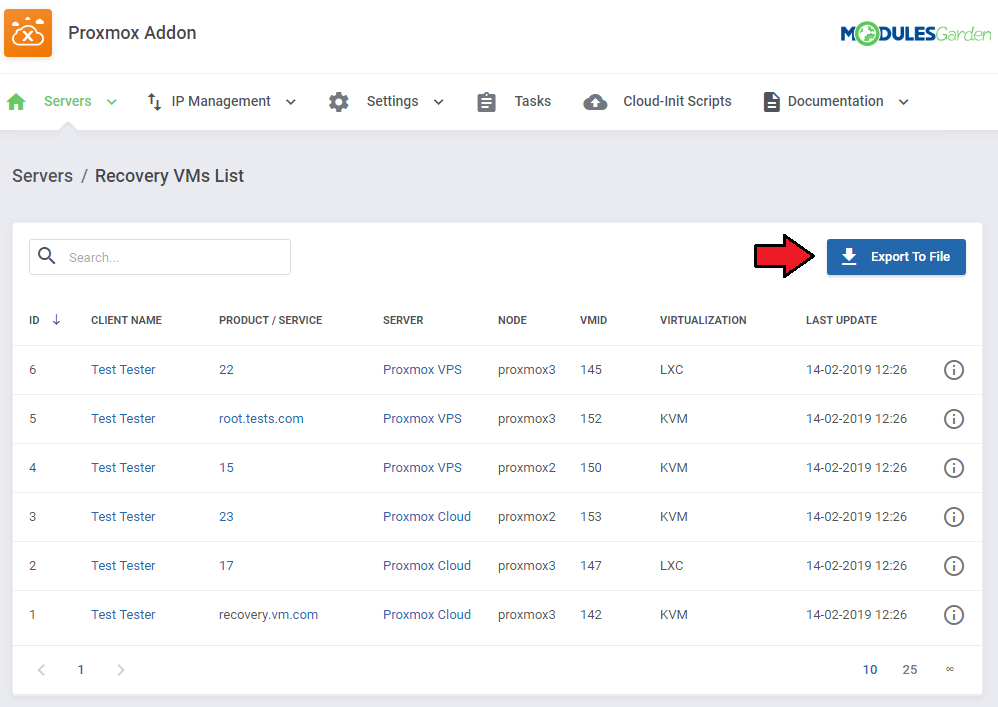
|
| On pressing the 'Details' icon, you will get any information on Configuration, Status and DNS: |
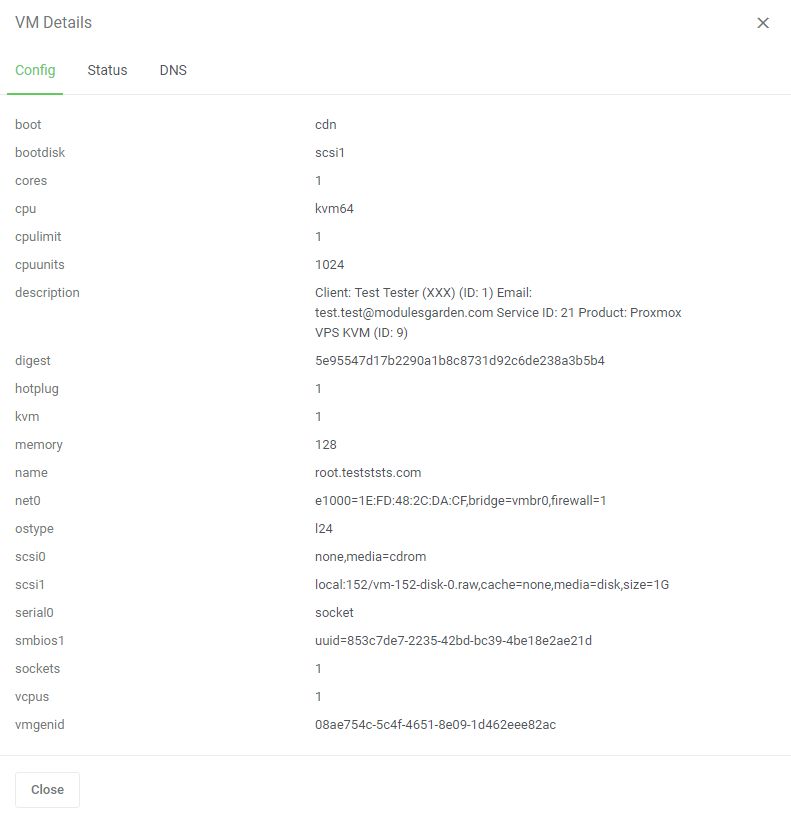
|
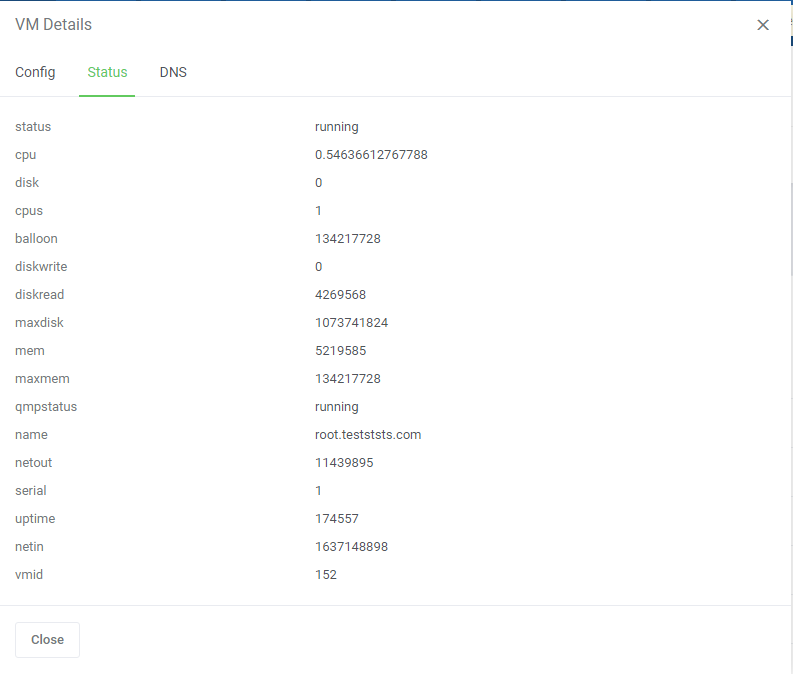
|

|
Tasks History
| Tasks History includes a list o all module tasks with the most crucial details on them. You may delete single tasks or use mass action button to remove them in bulk. Run the 'Tasks synchronization' cron job to synchronize the tasks and view all tasks from the server, you can find it at point no 26 of the configuration instructions. |
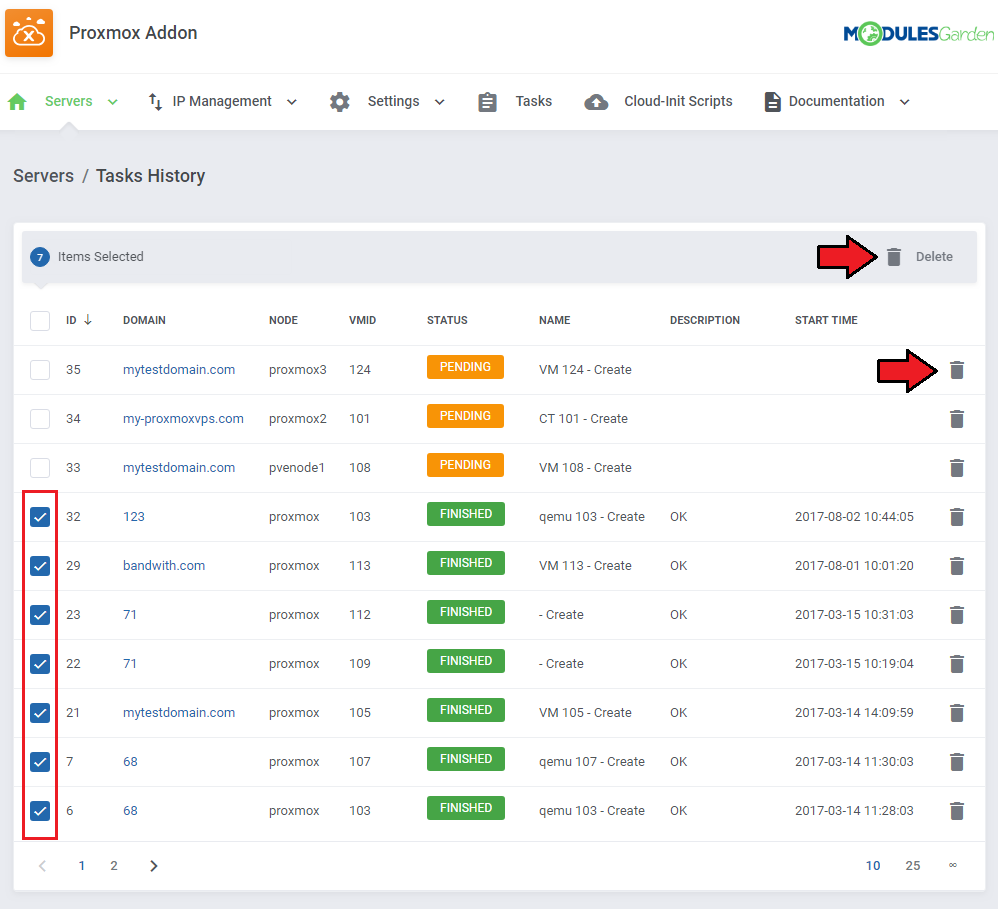
|
IP Management
| In the 'IP Management' tab you can manage the IP addresses of Proxmox products. You can create both single IP addresses and IP pools which then can be assigned to created VMs. |
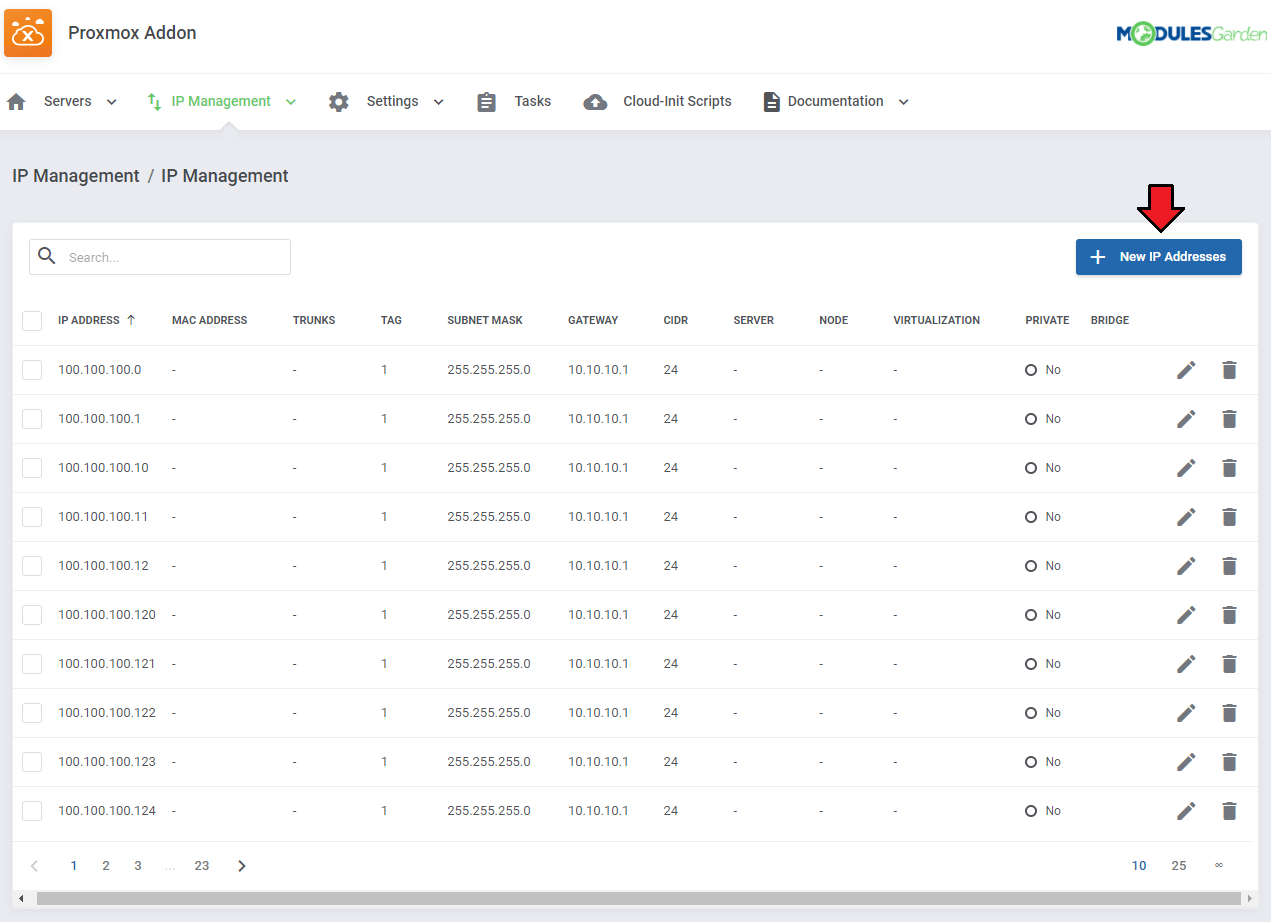
|
When you are creating a new IP address or a pool, you may define:
|
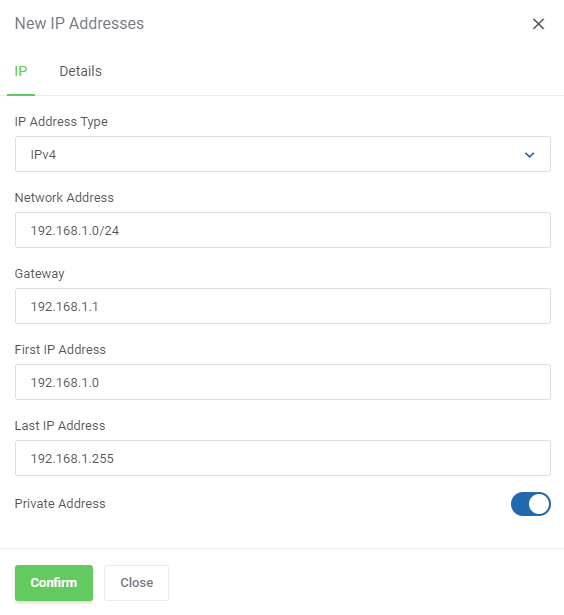
|
IP Manager Integration
| Owing to the integration with IP Manager For WHMCS, you are able to easily create subnets with IP addresses and assign them to the desired products. By activating the IP Manager submodule, settings concerning IP addresses such as 'Configurable Options' and 'Default Options' will be ignored by Proxmox VPS. |
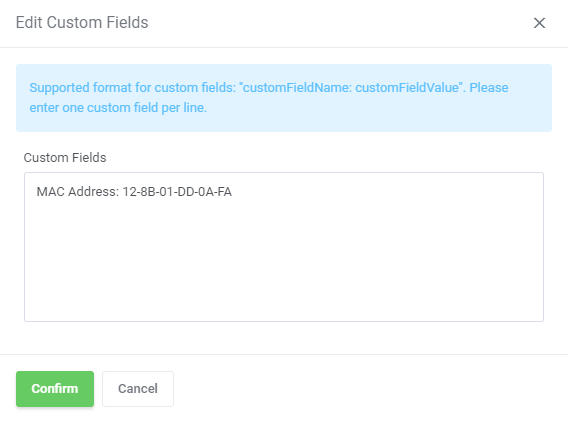
|
| 3. Afterward, create a new configuration and assign the previously created subnet to it. Note: Multiple IP addresses subnets can be assigned to a single configuration. |
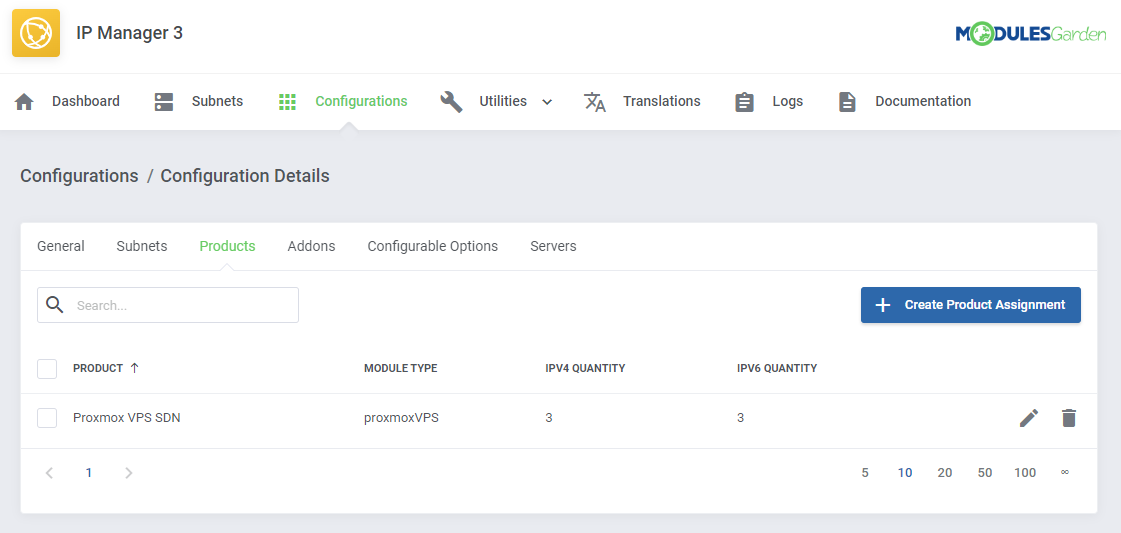
|
| 5. Now, enable the integration by proceeding to the '3rd Party Integration' tab. Press 'Activate' next to the 'proxmoxVPS' module type as shown on the following screen. |
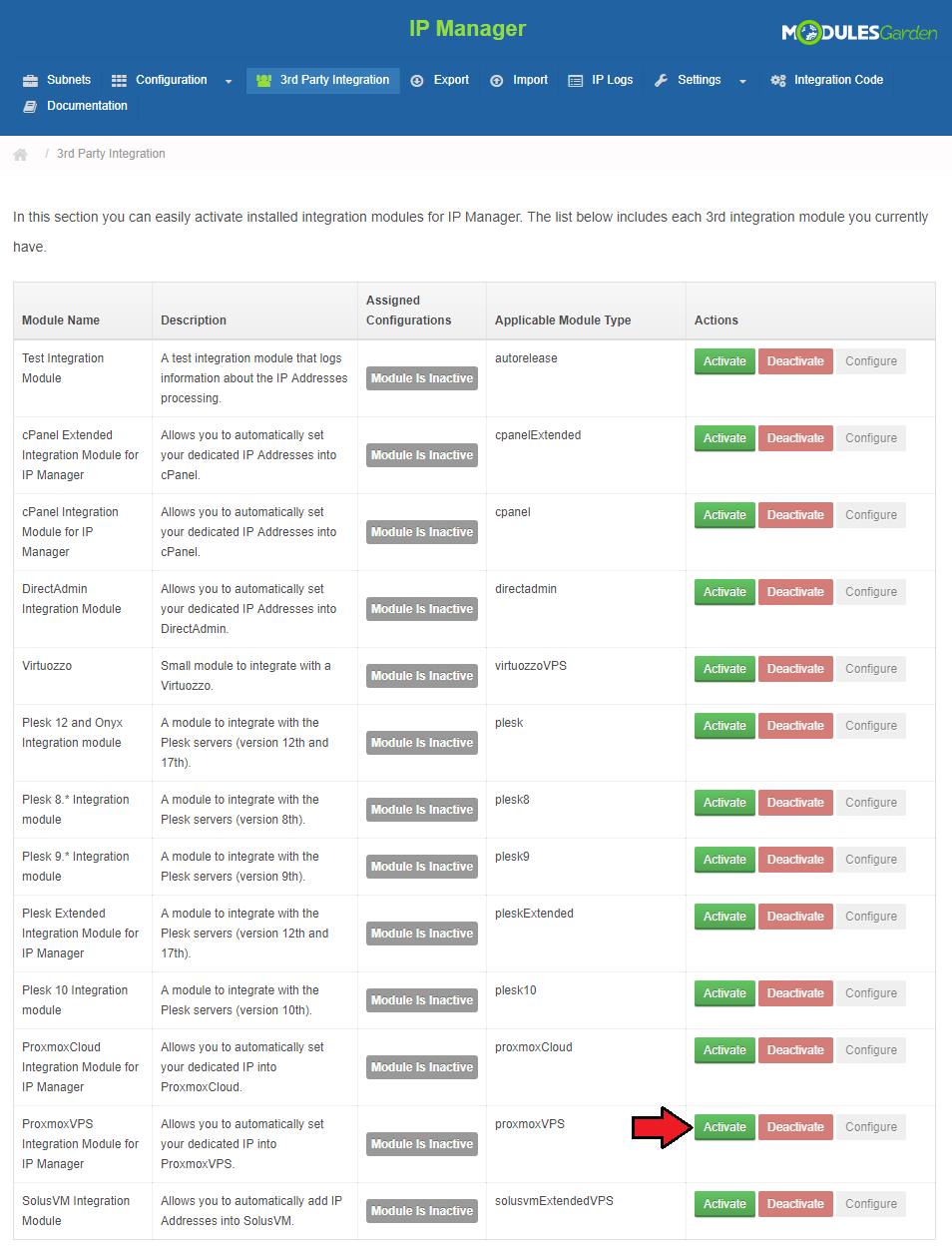
|
| 6. Next, assign the previously created configuration to the submodule. Press 'Configure' , choose a configuration and press 'Save Changes'. |
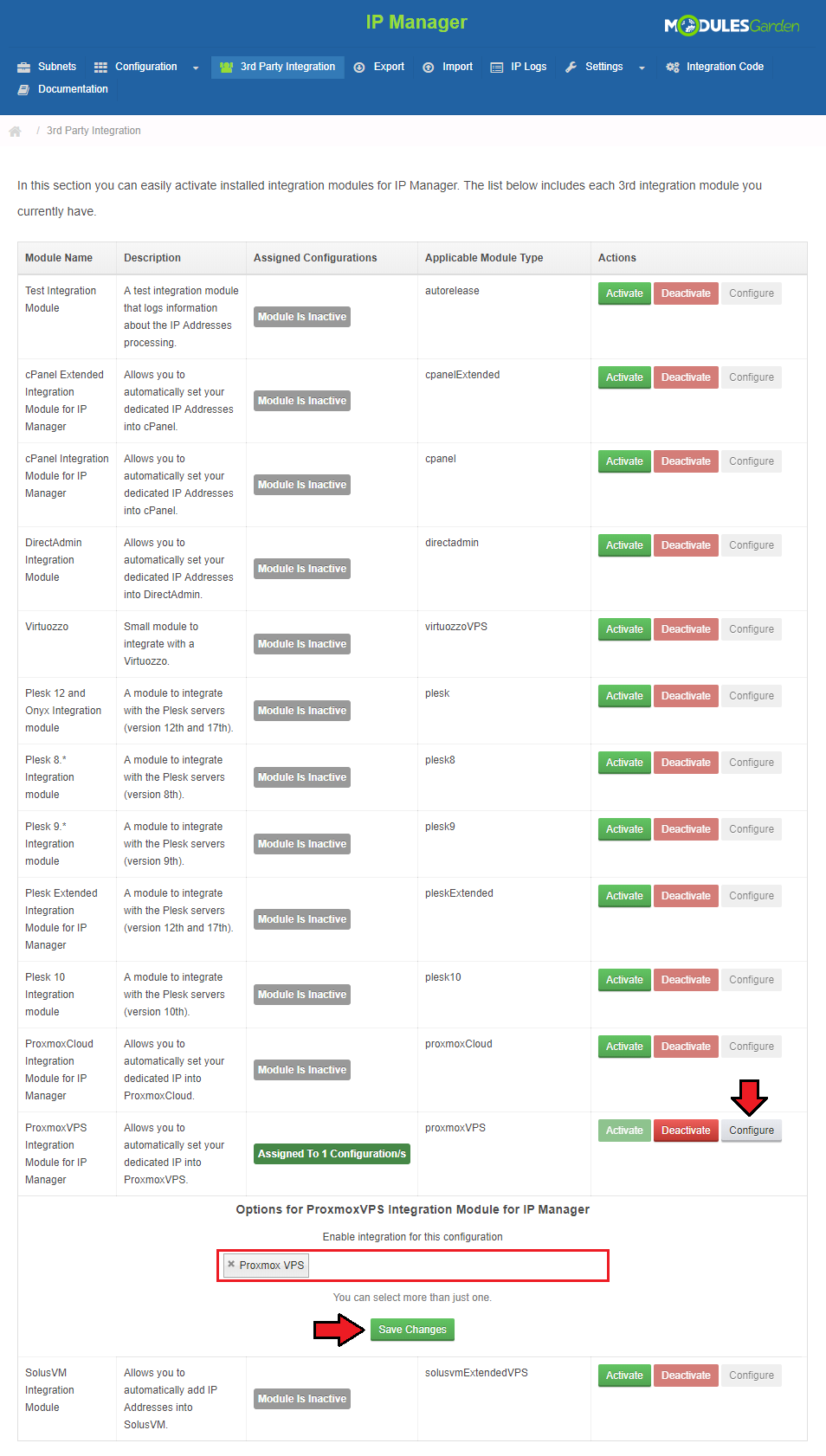
|
| If you encounter an error like the one on the below screen while integrating the two products, probably the function 'mb_strlen' is not enabled by default. Please read the manual here for installation instructions. |

|
| It is possible to add a VLAN Tag Custom Filed in the very same way as the MAC Address field. Look above for the detailed instruction on how to proceed, follow steps 1-6 to create the new custom field. |
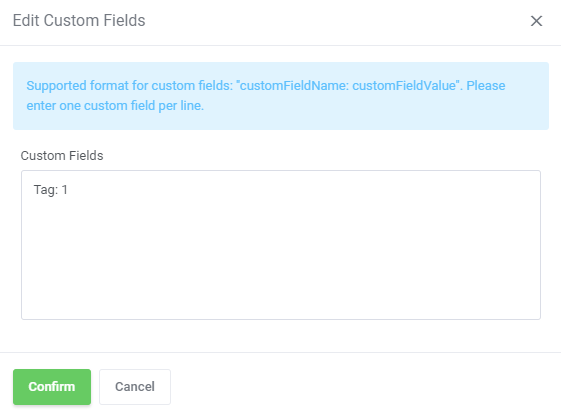
|
Settings
Load Balancer
| Load Balancer is an advanced tool that allows smooth rotation between nodes to find the most preferable one and create virtual machine on it. Set the weight of the resource that will prioritize its selection when sorting the Nodes according to the free resources. |
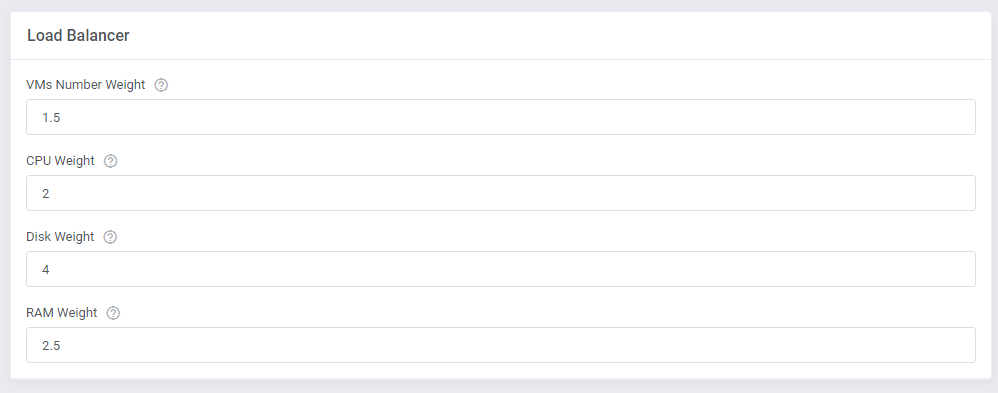
|
| In order to use Load Balancer you must previously enable it in the product's configuration: Define the behavior of the tool:
|

|
Node Prioritization Method
| Let us take a look at how the sorting process works and the rules that it obeys. Let's take exemplary weights for each resource just like presented on the screen above. VMs Number Weight: 1,5 Disk Weight with the highest weight which means it has the highest priority and VMs Number Weight as the least crucial factor on a given node.
Node A (Free Ram: 60%, Free CPU: 20%, Free Disk Space: 50%, Number of VMs: 5) The next step is sorting the nodes according to each resource, by assigning them corresponding priorities from 1 to 4. |
| Priority | Free Ram | Free CPU | Free Disk Space | Number of VMs |
|---|---|---|---|---|
| 4 | Node C | Node B | Node D | Node A |
| 3 | Node D | Node D | Node A | Node B |
| 2 | Node A | Node C | Node B | Node D |
| 1 | Node B | Node A | Node C | Node C |
| Now, the final calculation to sort nodes according to free resources, taking into account previously defined weights, is performed Sorting nodes is based on the following calculation method: Final Node Priority = (RAM Priority x RAM Weight) + (CPU Priority x CPU Weight) + (Free Disk Priority x Disk Weight) + (No. VMs Priority x VMs Weight) The results for nodes A, B, C and D (with weights and sorting priority) are following: Node A: (2 x 2,5) + ( 1 x 2 ) + ( 3 x 4 ) + ( 4 x 1,5 ) = 25 Node B: (1 x 2,5) + ( 4 x 2 ) + ( 2 x 4 ) + ( 3 x 1,5 ) = 23 Node C: (4 x 2,5) + ( 2 x 2 ) + ( 1 x 4 ) + ( 1 x 1,5 ) = 19,5 Node D: (3 x 2,5) + ( 3 x 2 ) + ( 4 x 4 ) + ( 2 x 1,5 ) = 32,5 As you can see, Node D has got the highest priority value with a result: 32,5. The above described calculations are performed every time, a 'Create' or 'Upgrade' actions are executed based on the current usage of resources on available nodes. Important: In case a given client already has an existing VM on a node, this very node will NOT be taken into account during the prioritization of resources process. If you decide to use the 'Load Balancer' tool, define the resource weights to adjust their prioritization of nodes according to your needs. |
Tasks
| Under the 'Tasks' tab, you can check a list of performed tasks along with their status. Moreover, you are granted the possibility to check 'Info' for a particular task, run the task again by clicking the 'Run Task' button, or delete it. |
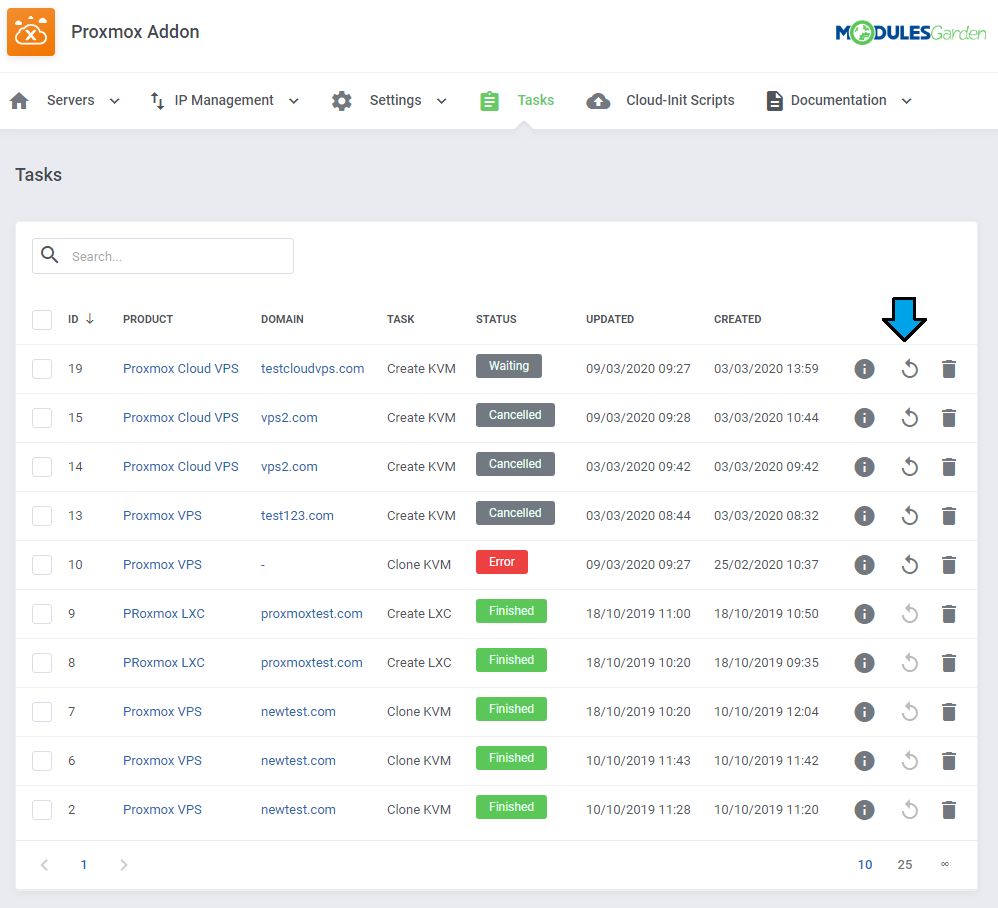
|
Client Area
| Client area interface of Proxmox Cloud VPS For WHMCS allows your clients to create their own virtual servers. They can also view resources used and manage existing virtual machines. |

|
New Virtual Machine
| In order to add a new virtual machine, press the 'Add New Virtual Machine' button. |

|
| Now, provide a name of your new virtual machine and choose a proper type from the dropdown menu. Moreover, you can add 'New Virtual Network' and 'New Additional Disk' here.
Confirm creation through pressing 'Save Changes'. |
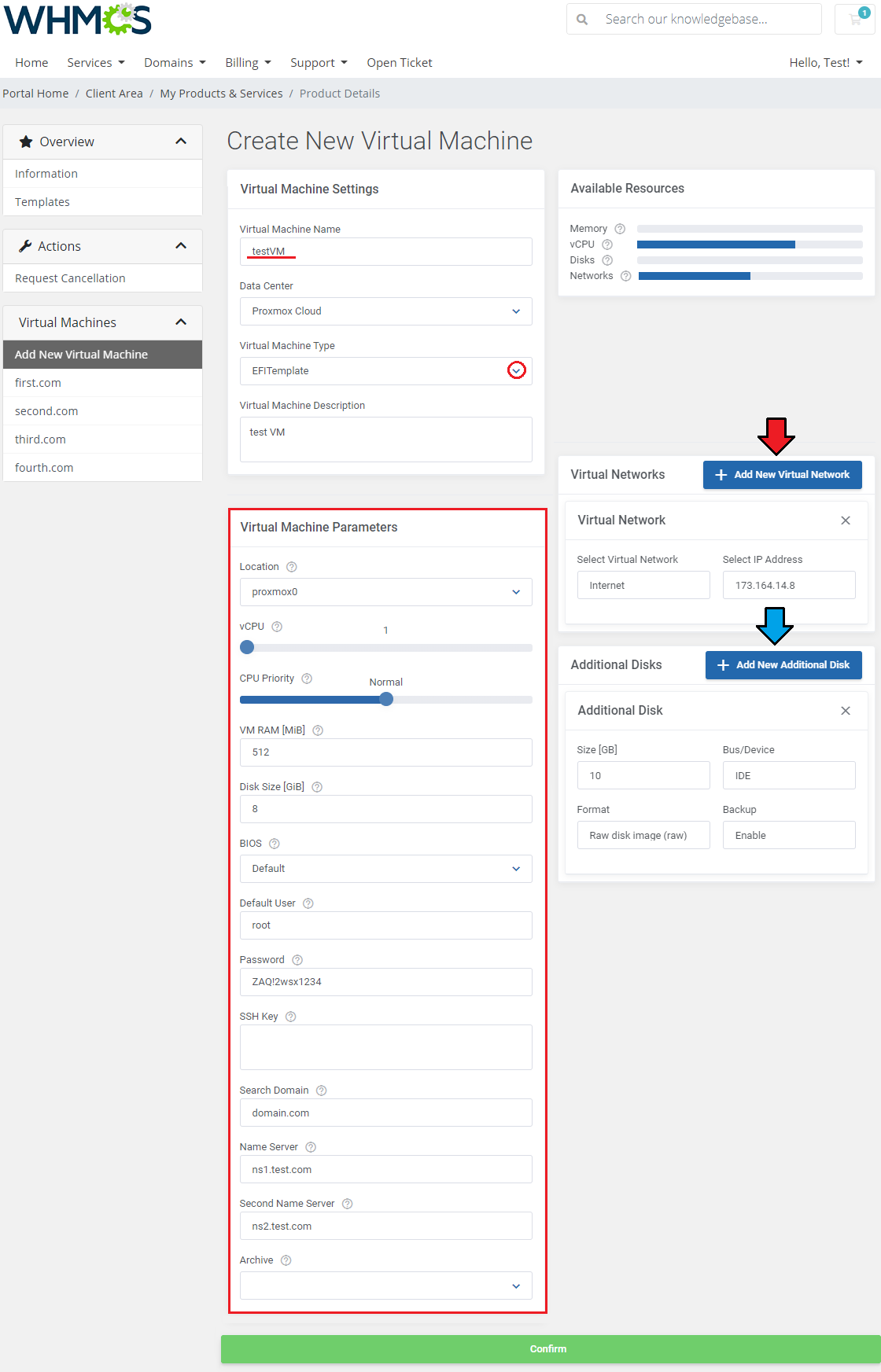
|
| You can now easily 'Edit' (1) or 'Delete' (2) your virtual machine.
You can find information about managing your virtual servers in next section. |

|
Virtual Network Management
| Move to 'Virtual Networks' section to add, delete and edit your virtual networks. Please keep in mind that this option must be enabled by administrator in your product's 'Module Settings' previously and a private IP address must be added in the Proxmox Addon. |
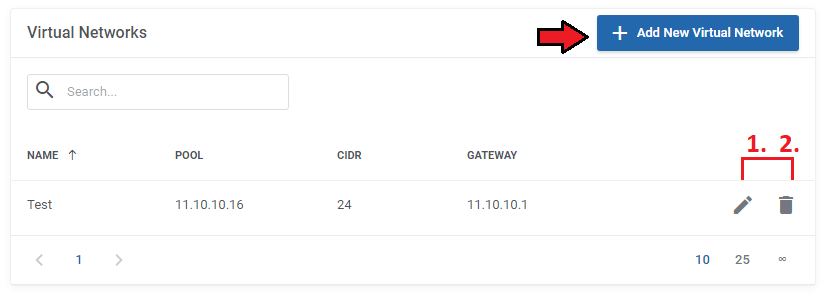
|
Templates Management (KVM Only)
| Once you press 'Templates', you will be redirected to a site where you will find the list of currently created templates along with their details and access to basic actions. |
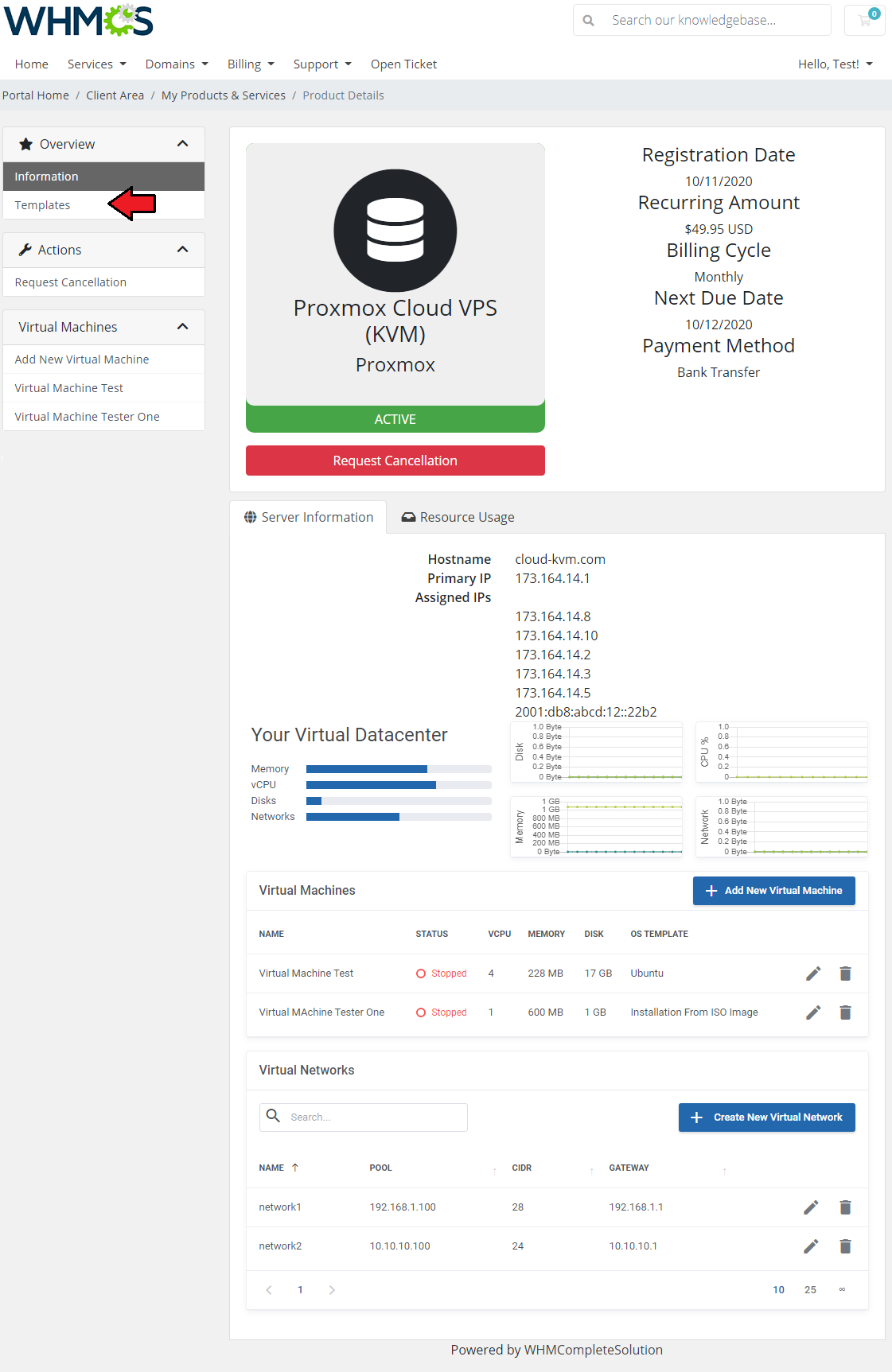
|
| You may edit or delete existing templates. To add a new one, simply press 'Add Template' button. OS templates do not consume any resources such as CPU sockets, memory etc. |
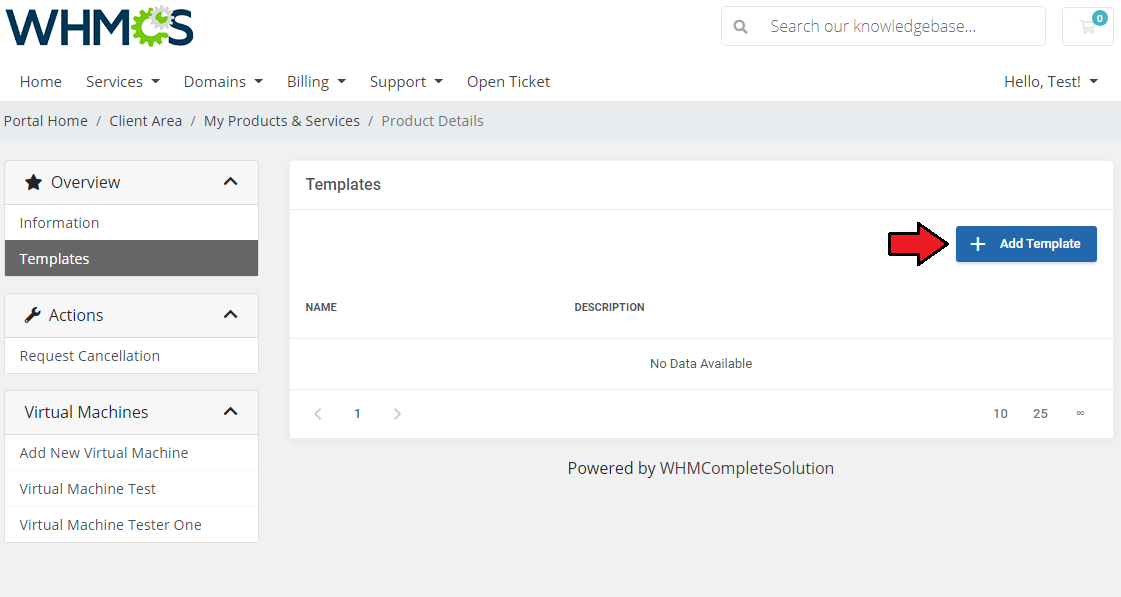
|
| Select server from dropdown menu and type in its short description. Save changes when ready. |
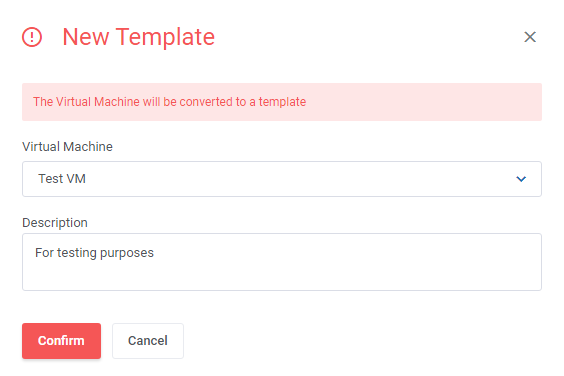
|
Client Area - VM Management
| The client area interface of your virtual machine should look like the one on the screen below. As you can see, the control panel contains useful options needed for managing VPS. |
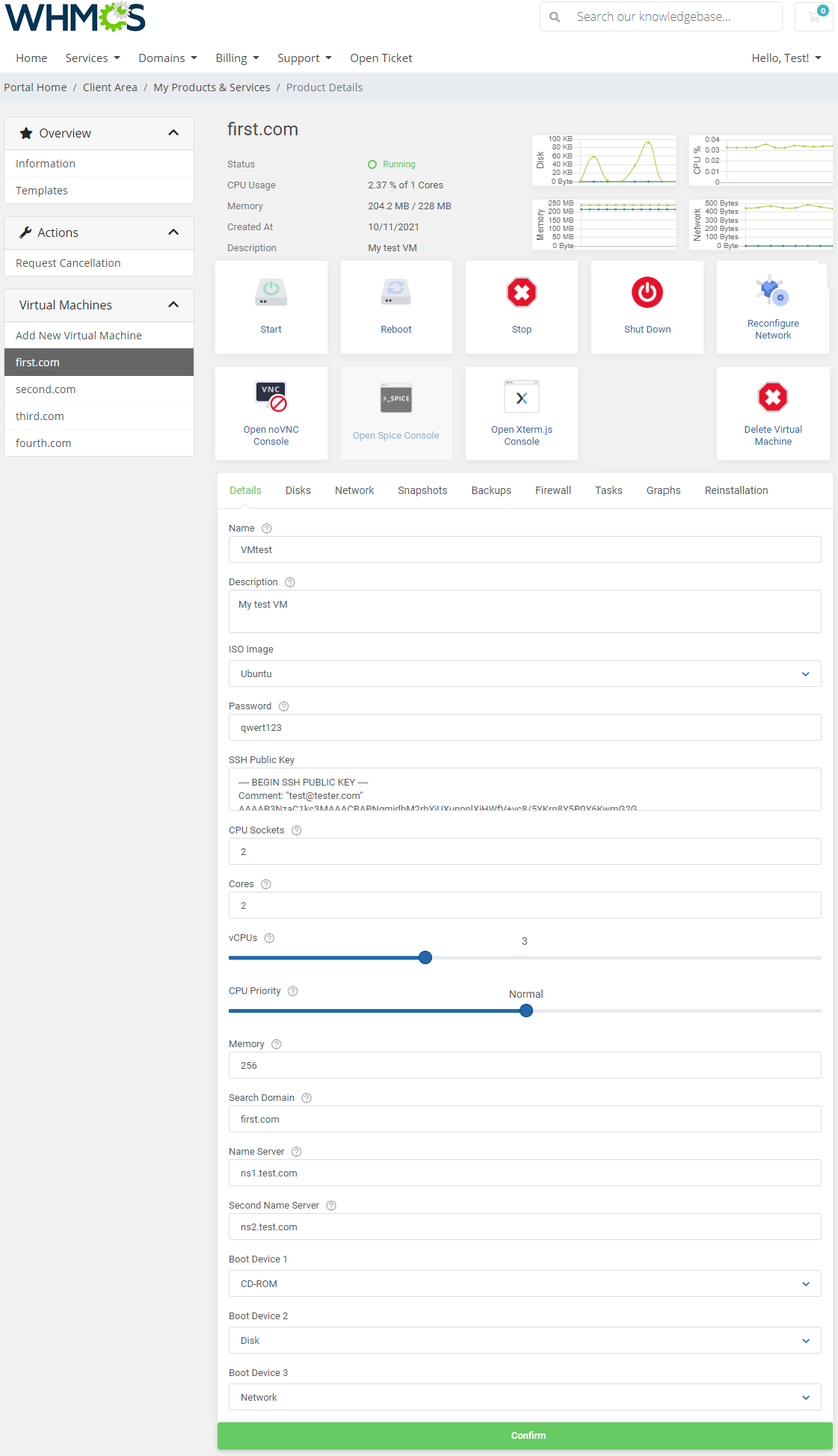
|
noVNC Console
| noVNC console allows your clients to connect with their server in the easiest possible way. |
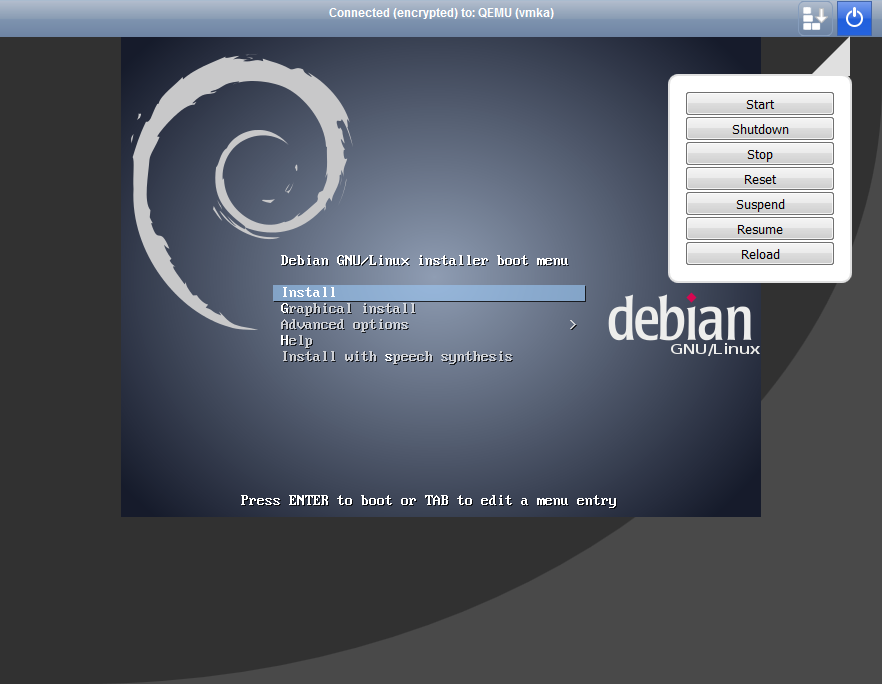
|
SPICE Console
| Spice console enables you to connect with virtual machine using SPICE. Note: Your client needs to download and install client side SPICE application in order to connect with VM. |
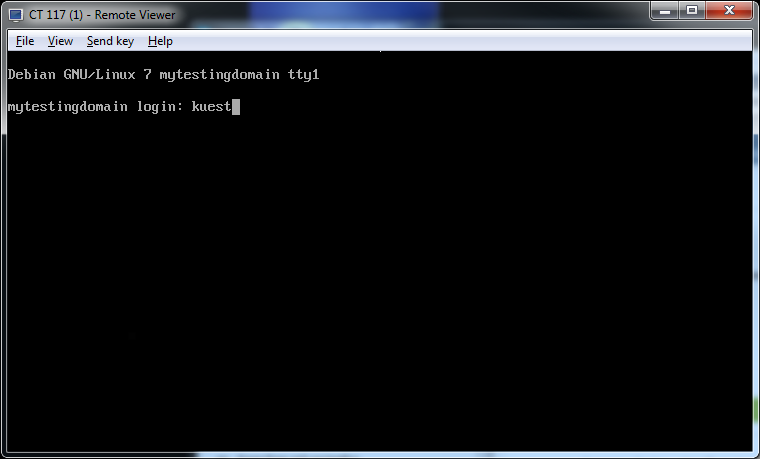
|
Xterm.js Console
| Xterm.js console enables you to connect to virtual machine using Xterm.js. You must update the scripts on Proxmox v2.6.0. To do so open folder: UploadOnProxmoxServer/5.2-10 and upload content on all your proxmox servers. |
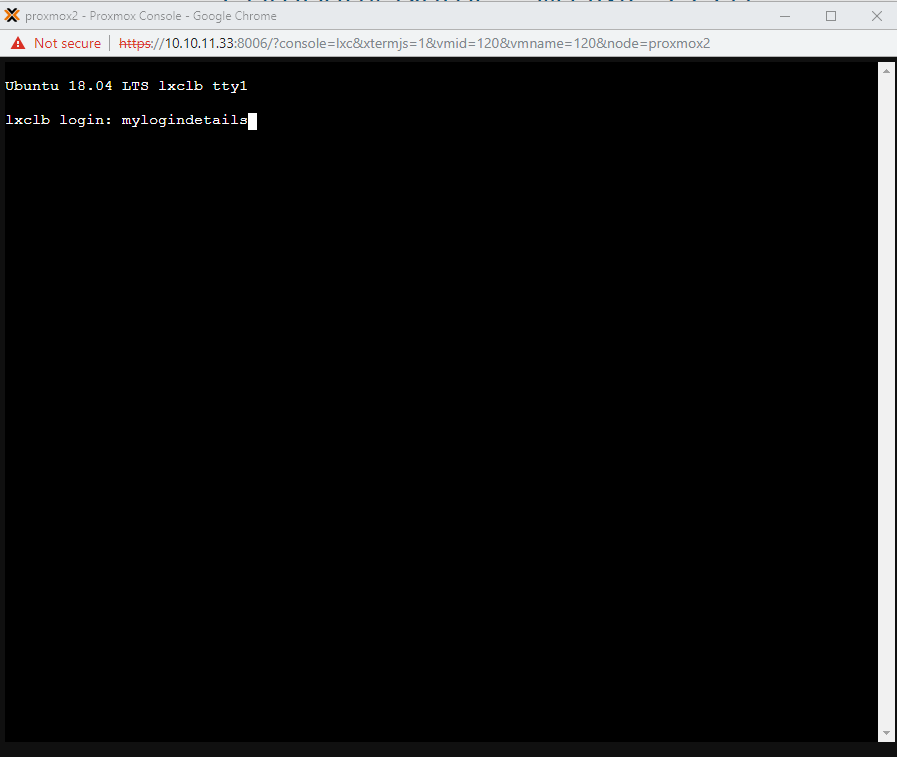
|
Client Area - Additional Tools
Reinstall
| The 'Reinstall' section is divided into two parts. There are 'OS Template' and 'ISO Images' subsections. Note: The ISO images can only be used for the KVM virtualization type, while VM templates can be used either for KVM or LXC. |
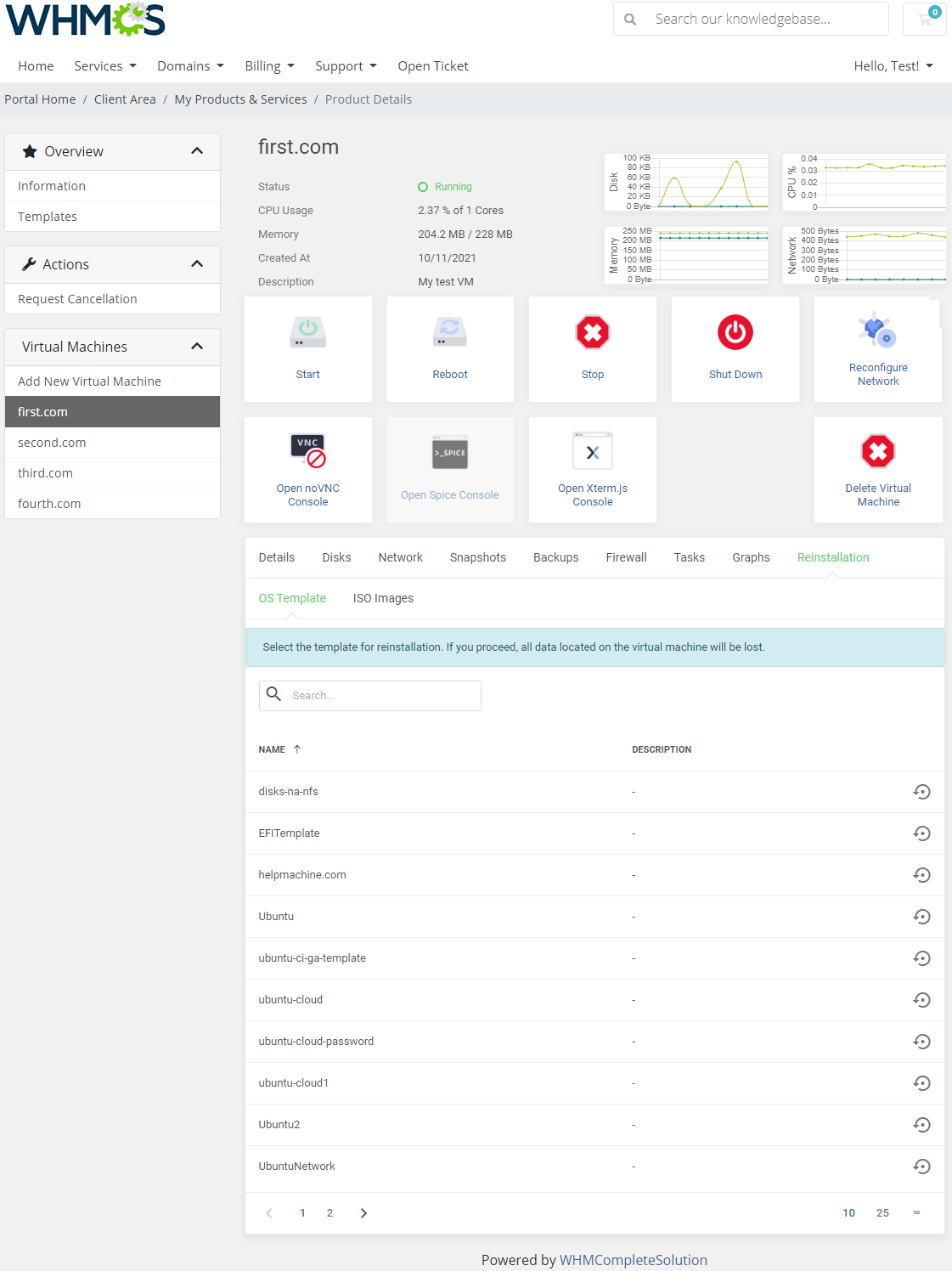
|
| Remember to gain your clients access to selected reinstallation types in the 'Client Area Features' of the product's configuration. |
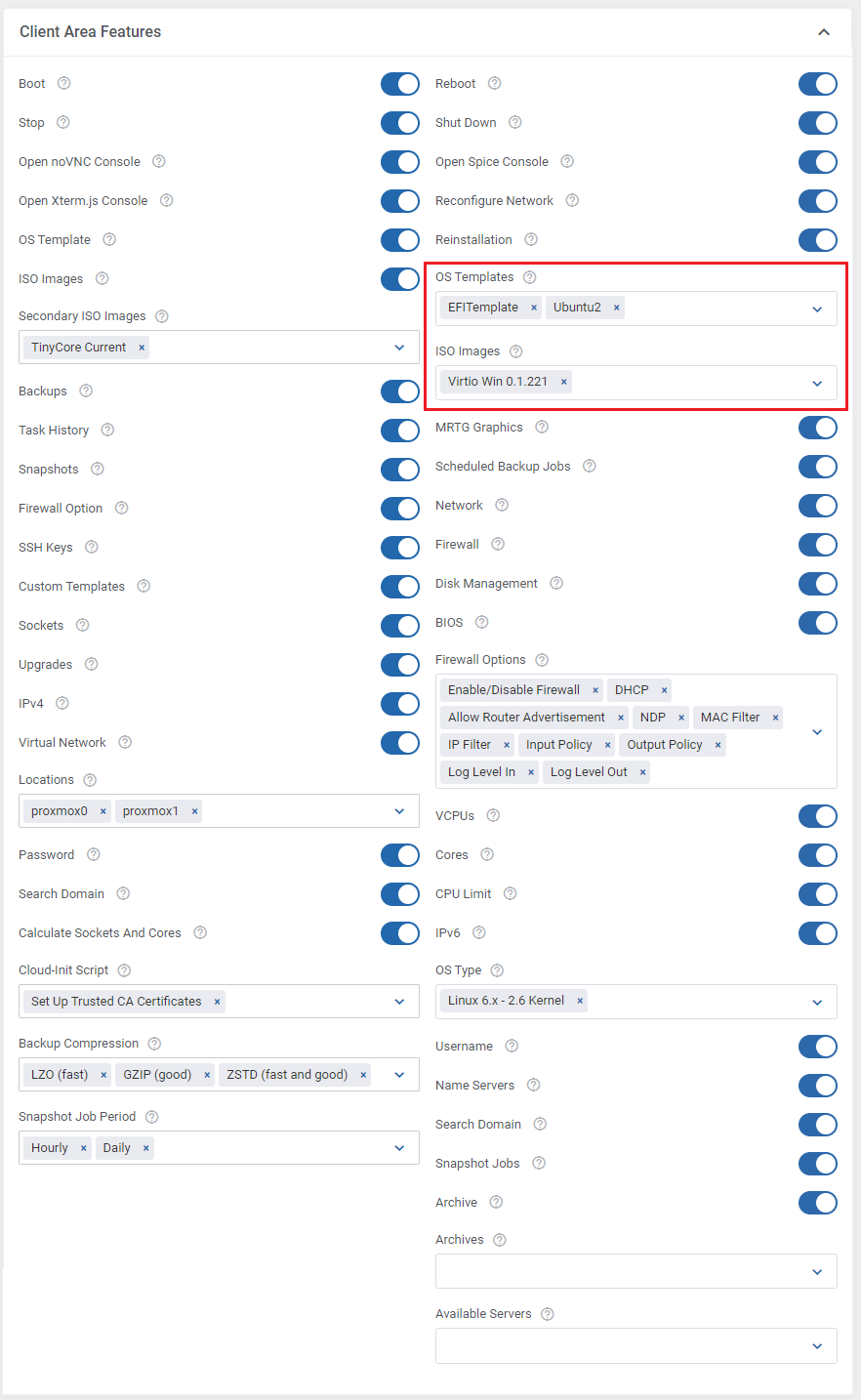
|
Backups
Backups List
| To create a single backup, proceed to 'Backups List' section and click 'Create Backup' . |
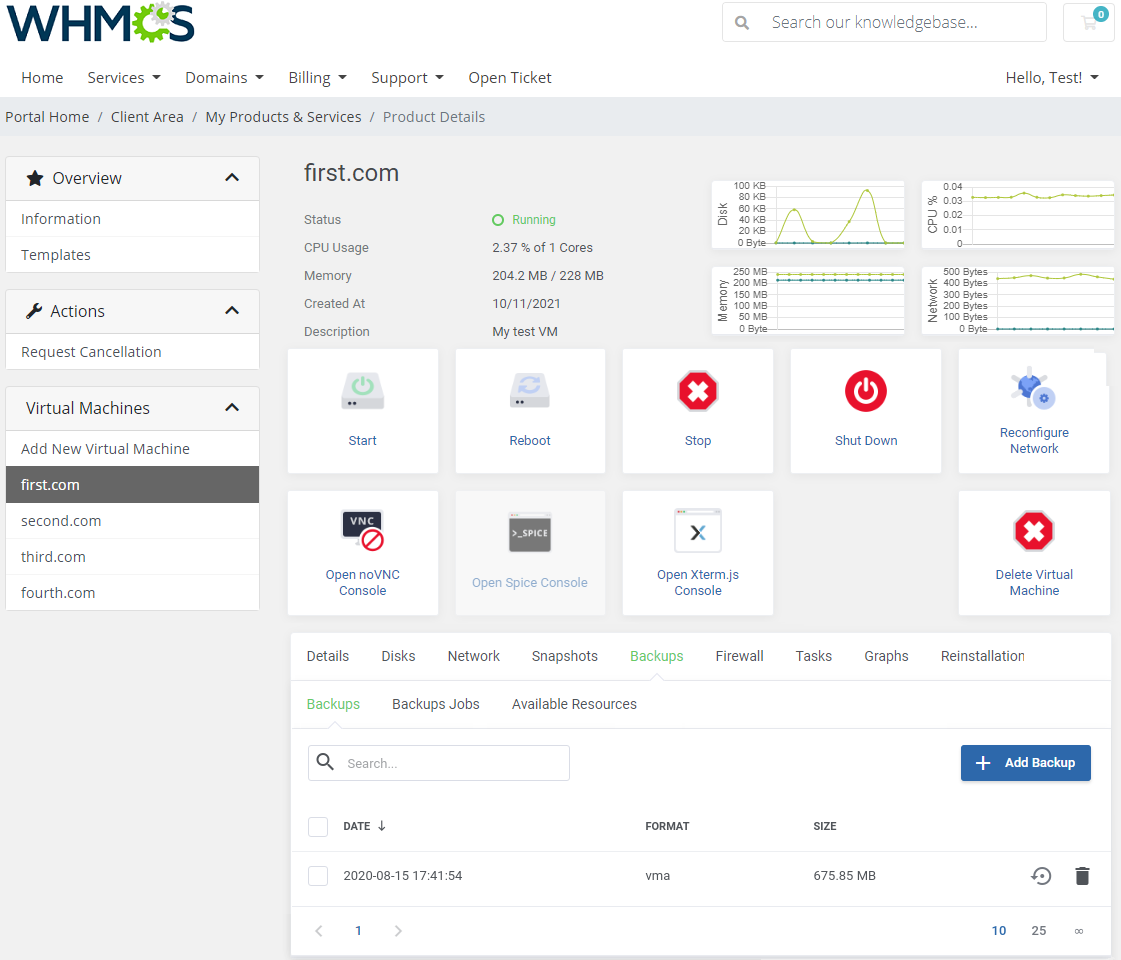
|
| Now choose 'Compress' and 'Mode' from dropdown menus. Afterwards, press 'Add' button. |
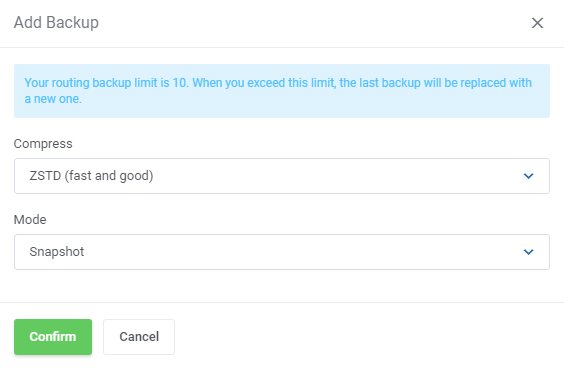
|
| To restore VM from a backup simply press 'Restore' and then click 'OK' button in a popup window to confirm. |
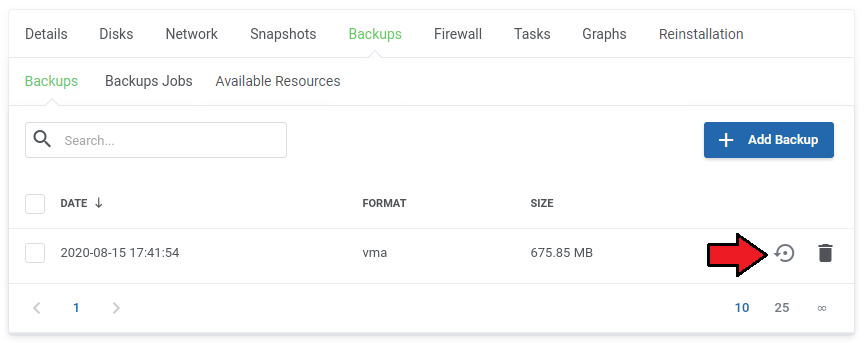
|
Backup Jobs
| By pressing 'Backup Jobs' in the client area, you will be carried to a backup jobs management page. To add a new backup job press 'Create Backup Job' . |
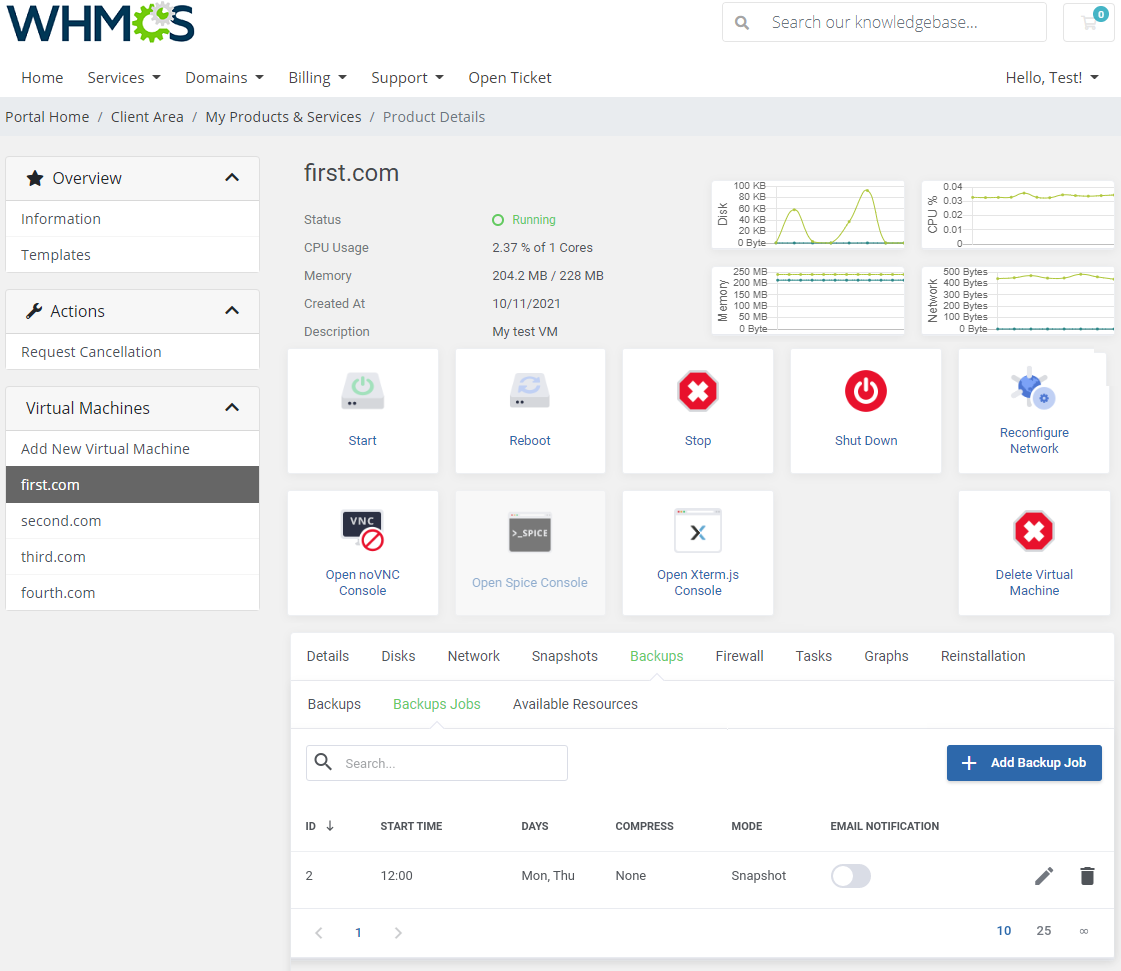
|
| Now, define backup time, mark days to run it and choose 'Compression' and 'Mode' from dropdown menus. Next, press 'Add' button. You may also enable email notifications here. |
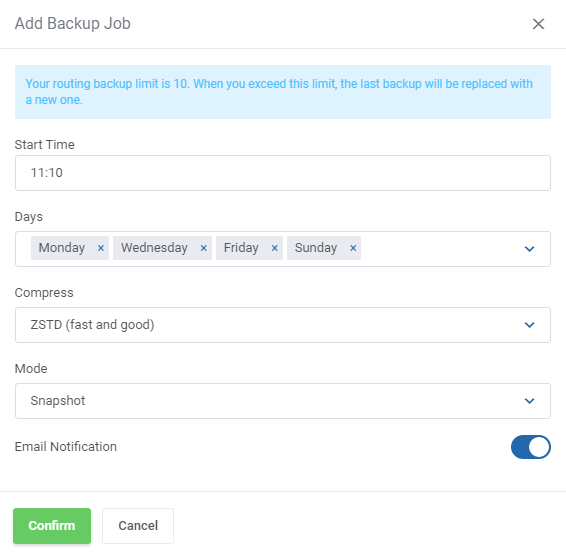
|
Graphs
| Under 'Graphs' page, a client can find graph with CPU usage, memory usage, network traffic and disc I/O. They can also switch the timeline of the graphs by choosing it from a dropdown menu pointed on the following screen. |
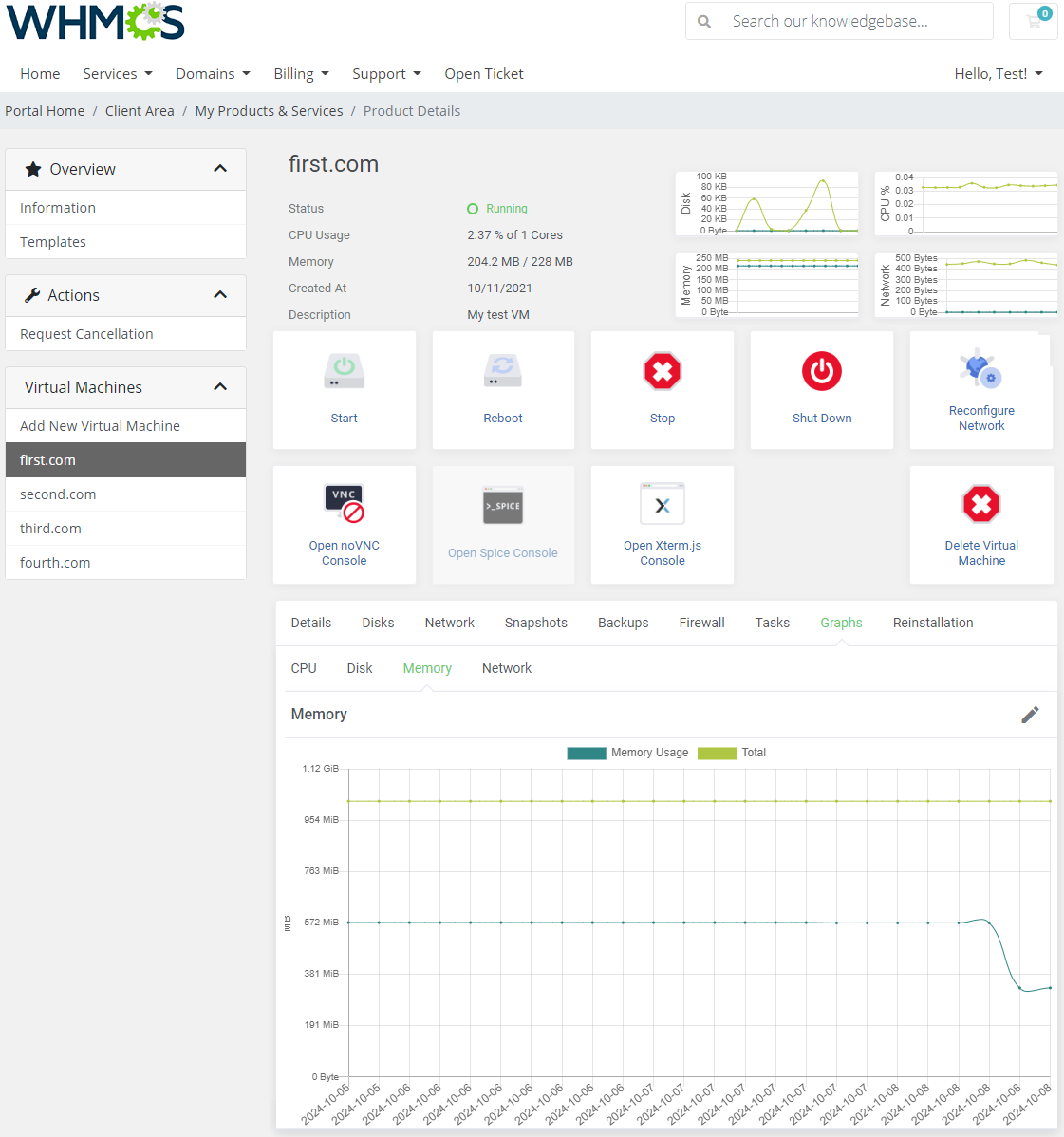
|
Tasks
| All changes of VM status are listed in the 'Tasks' section. Additionally, each access to the VM through SPICE console is shown here. |
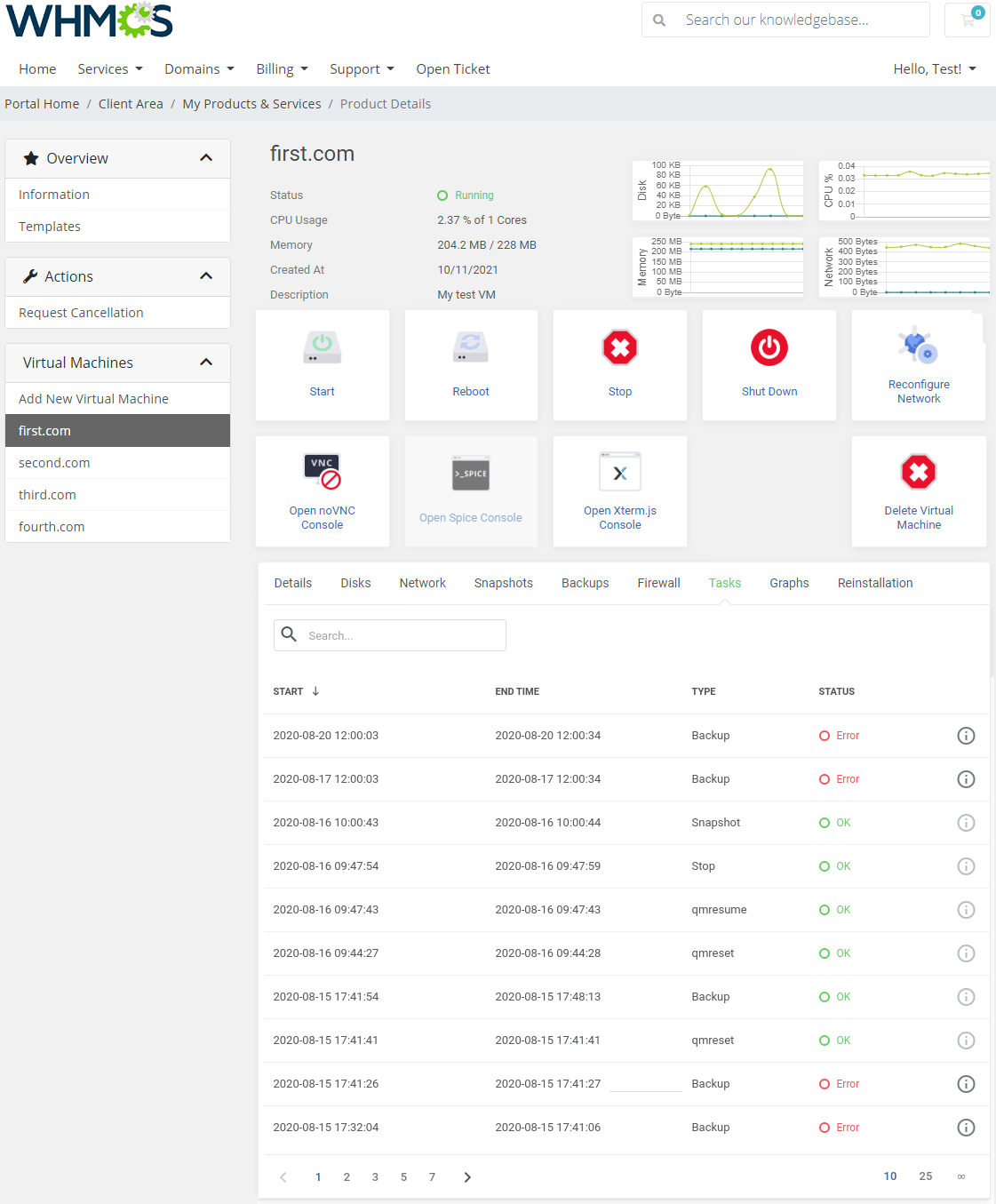
|
Network
| Under the 'Network' section, you will find 'Public IP' , 'Virtual Network' , as well as 'Interfaces' subsections. Depending on the settings of the product (private network is used), they can also create/remove them. This feature is optional. |
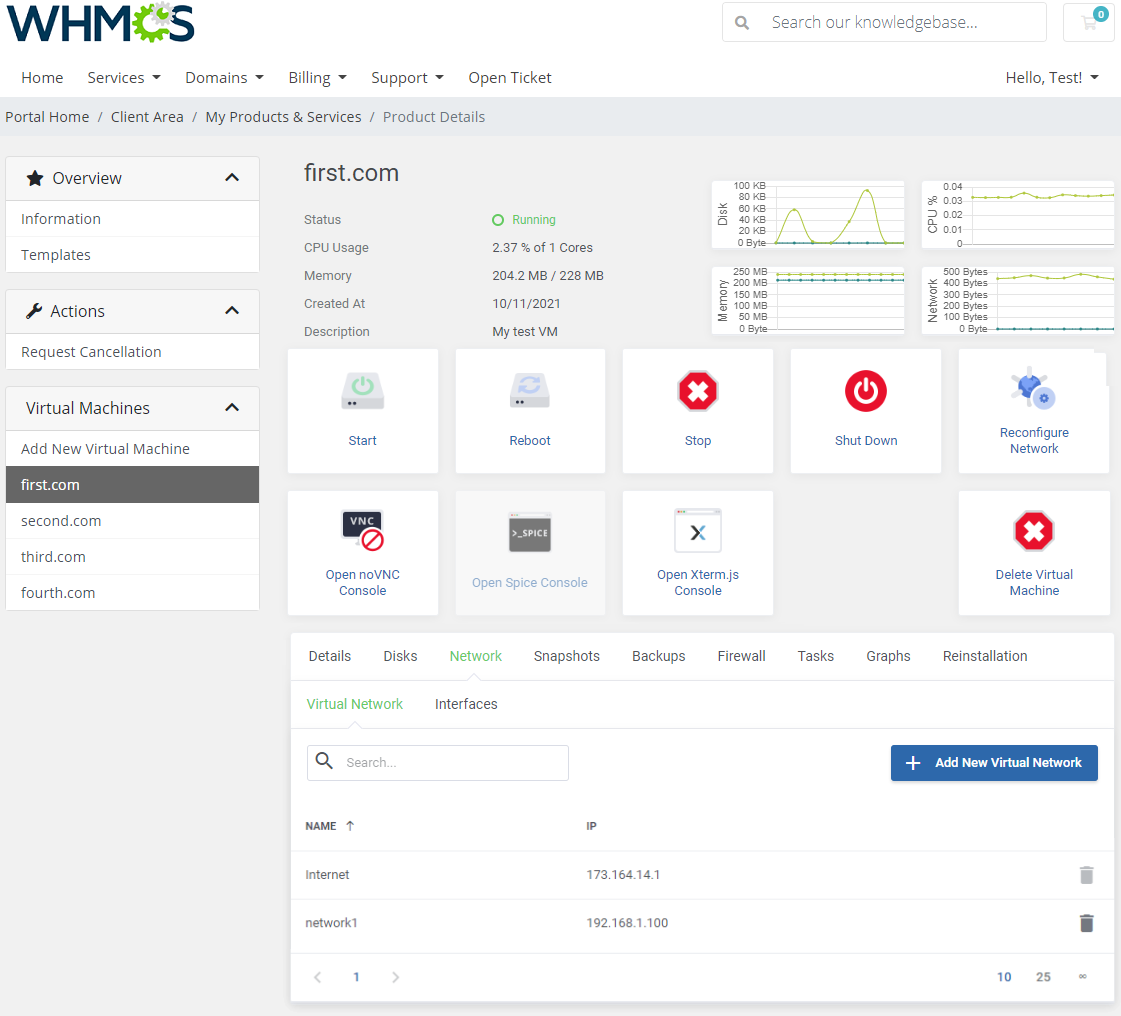
|
Snapshots
| Use snapshots to remember the contents of virtual machine memory current state. You may use them later to restore the VM settings. |
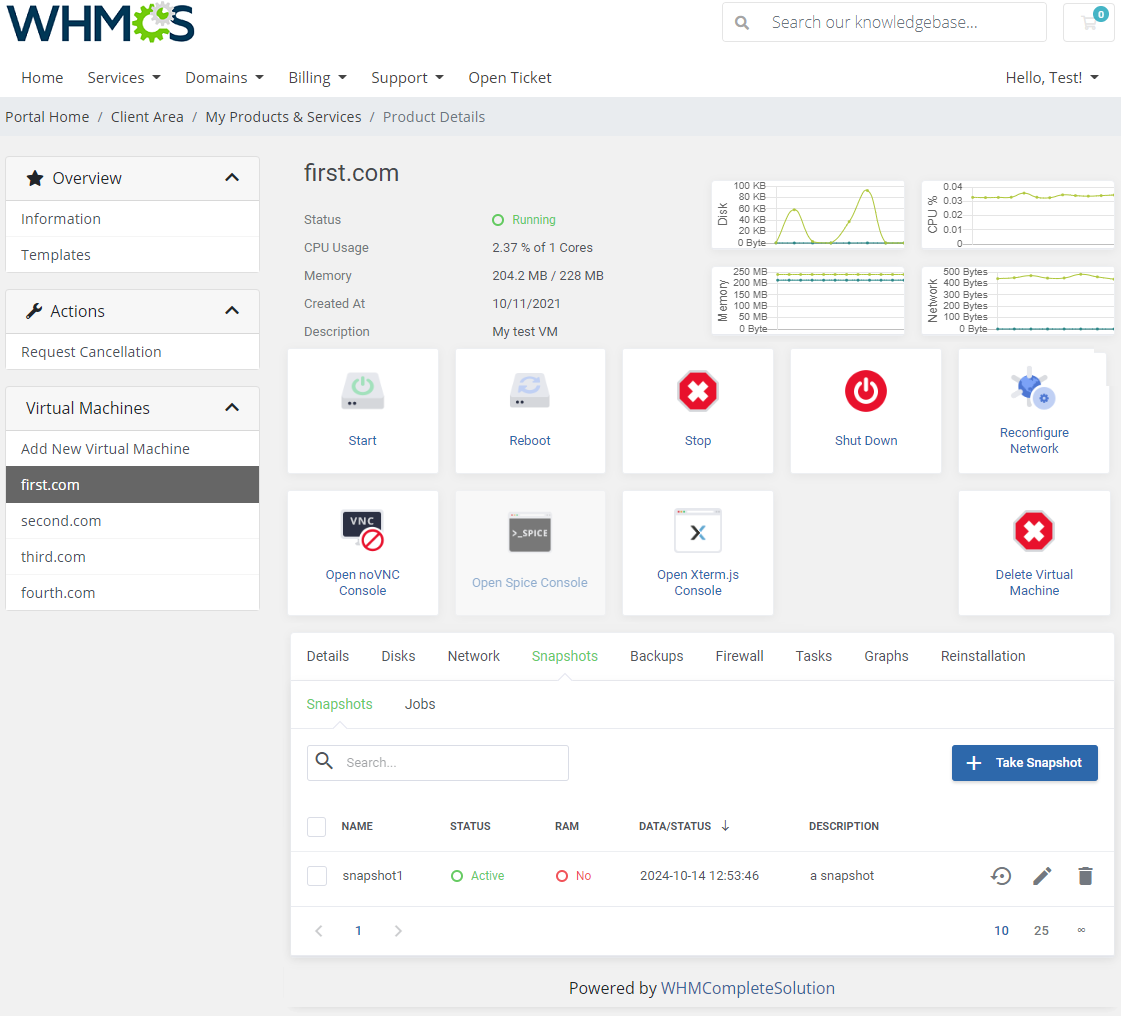
|
Firewall
Firewall Rules
| Owing to 'Firewall' page, your clients can set up firewall rules and enable security group for theirs servers from your WHMCS client area. As you can see, you can easily modify and remove previously added rules and security groups. |
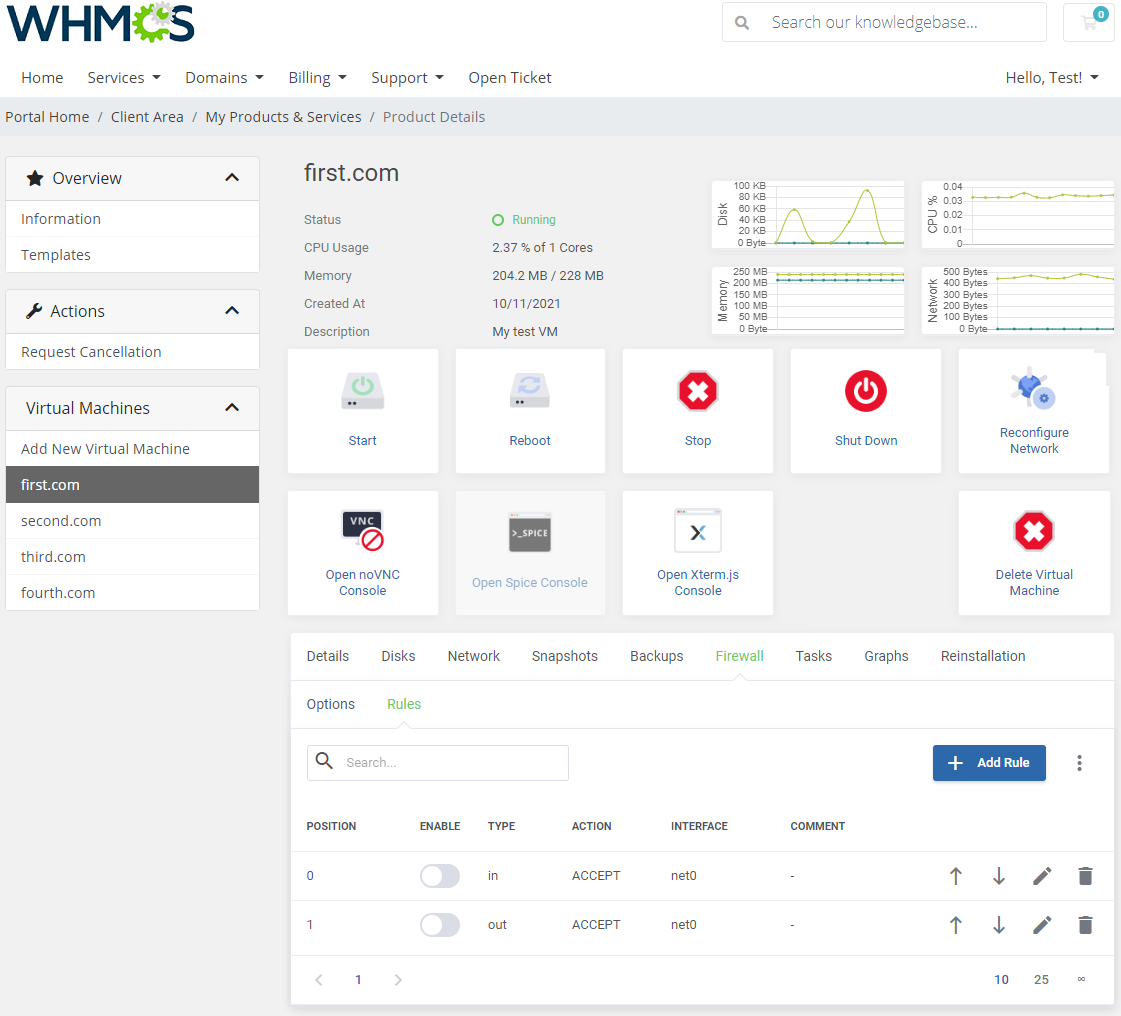
|
| You can add a firewall rule in two ways. Both of them require choosing direction, action, interface, source and destination. The first way (red) is by choosing macro from a 'Macro' dropdown field. |
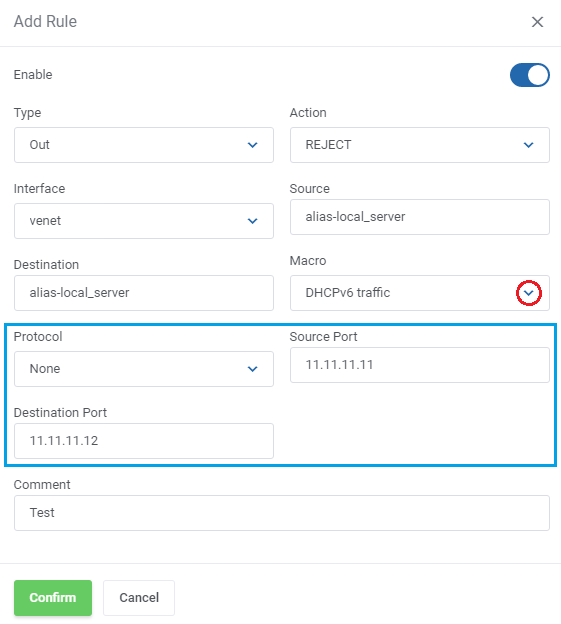
|
| Inserting a security group consists of choosing security group and interface on which group has to be used. Additionally, you can enable security group and add a comment to it. |
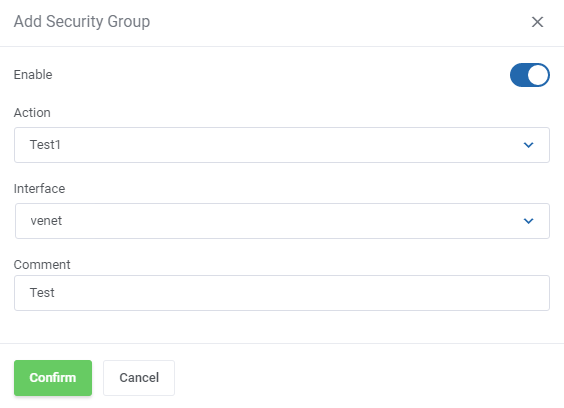
|
Firewall Options
| Under this subsection, you can easily view and edit firewall options. |
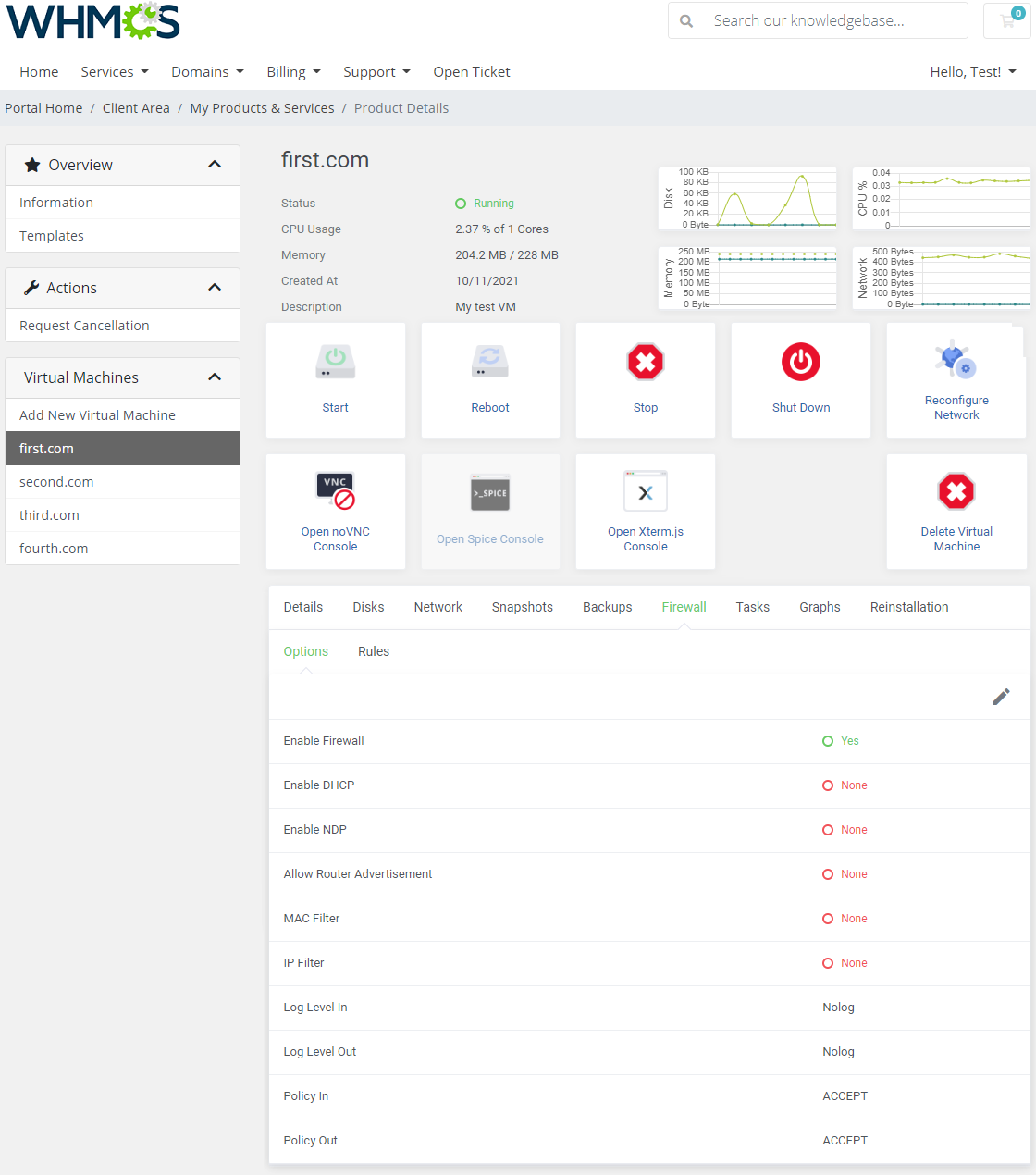
|
Disks (KVM only)
| View and manage hard disk within defined limits, add new one or remove additional disks if you wish. |
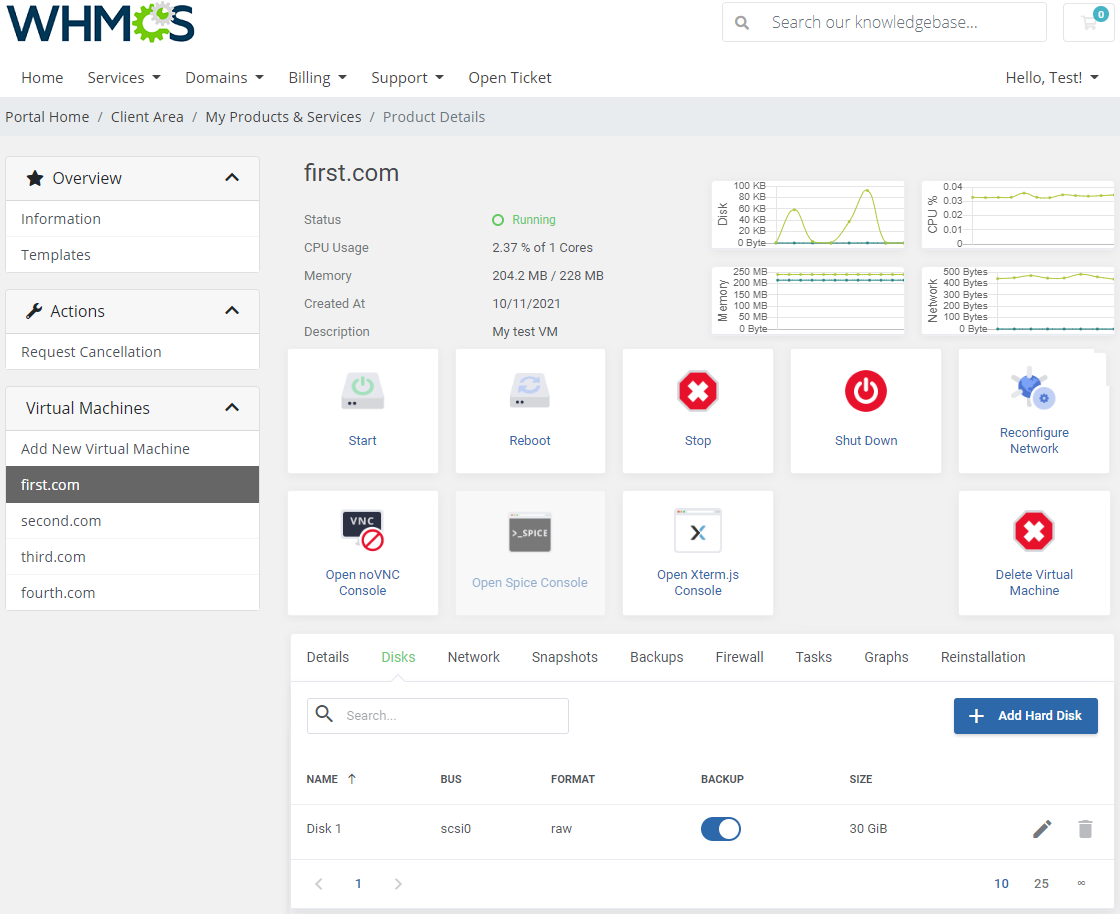
|
IP Manager Integration
| Owing to integration with IP Manager For WHMCS you are able to easily create IP addresses subnets and assign them to desired products. Note: This integration works for both LXC and KVM virtualization types.
|

|
| 3. Afterwards, create a new configuration and assign a previously created subnet to it. Note: Multiple IP addresses subnets can be assigned to a single configuration. |

|
| 5. Now, enable integration by proceeding to '3rd Party Integration' tab. Press 'Activate' next to 'ProxmoxCloudVps' module type as shown on the following screen. |
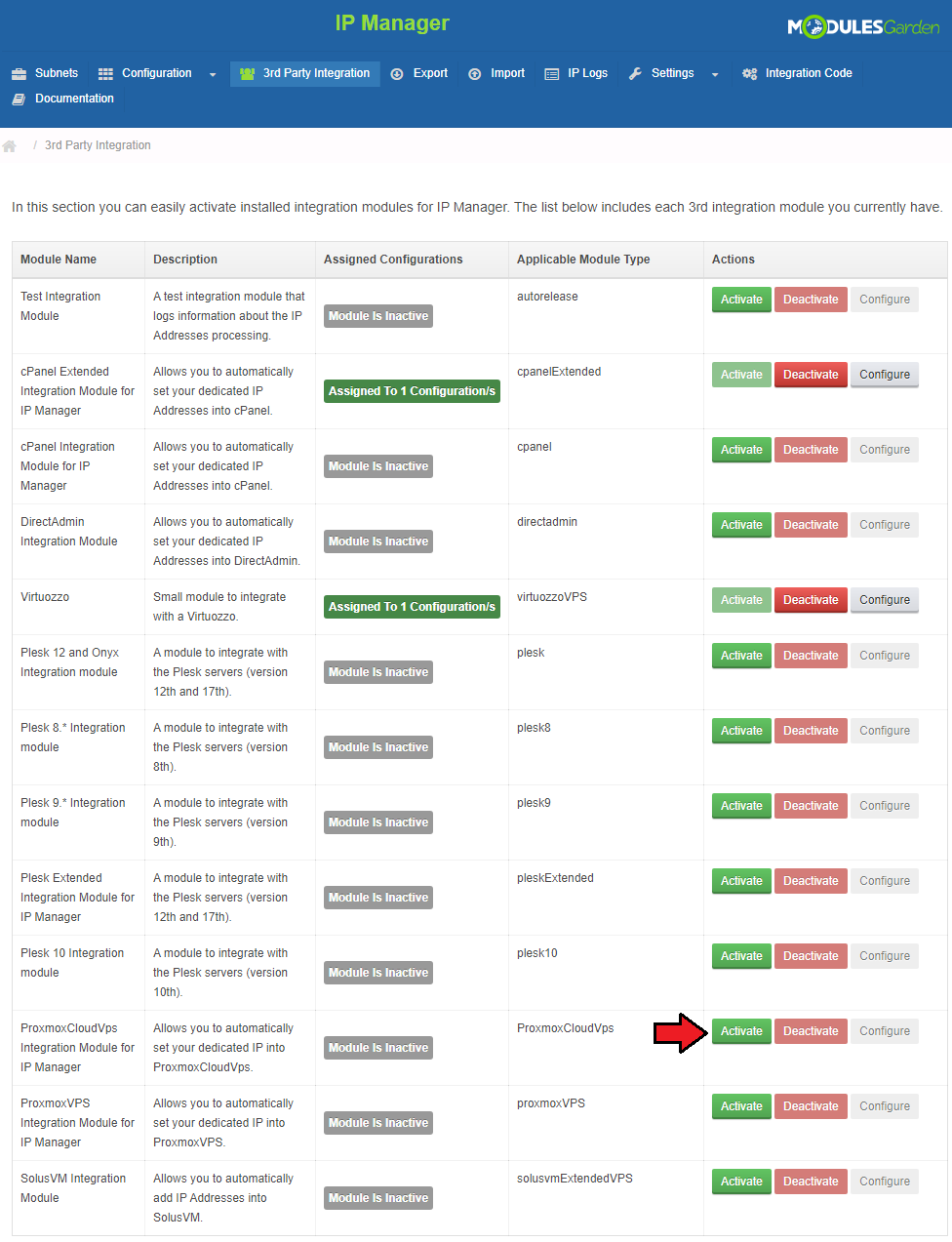
|
| 6. Next, assign a previously created configuration to the submodule. Press 'Configure', choose the configuration and press 'Save Changes'. |
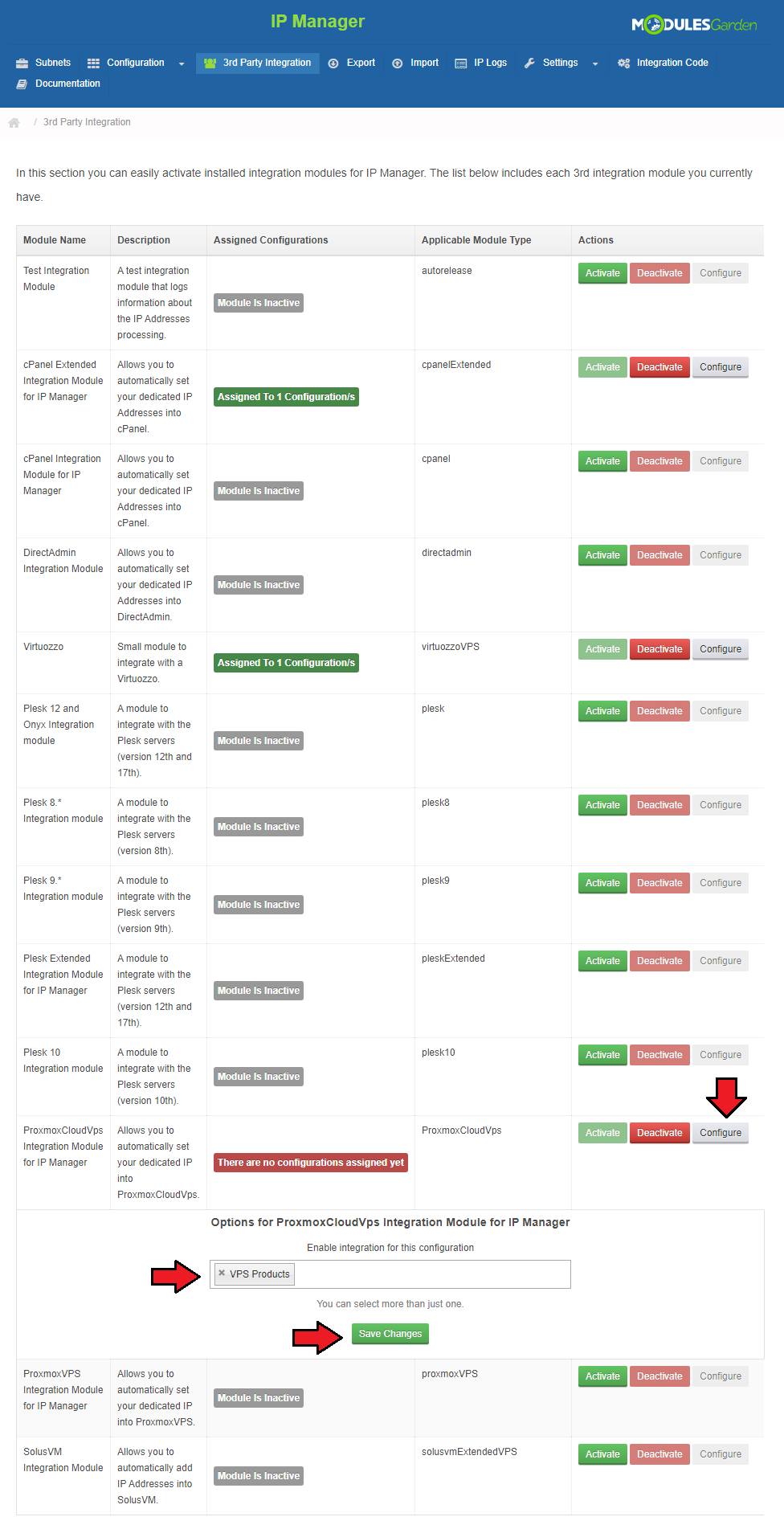
|
Importing VM
| Our module allows you to easily import VM into your cloud product. To do so, press 'Import Virtual Machine' as shown on the following screen. |
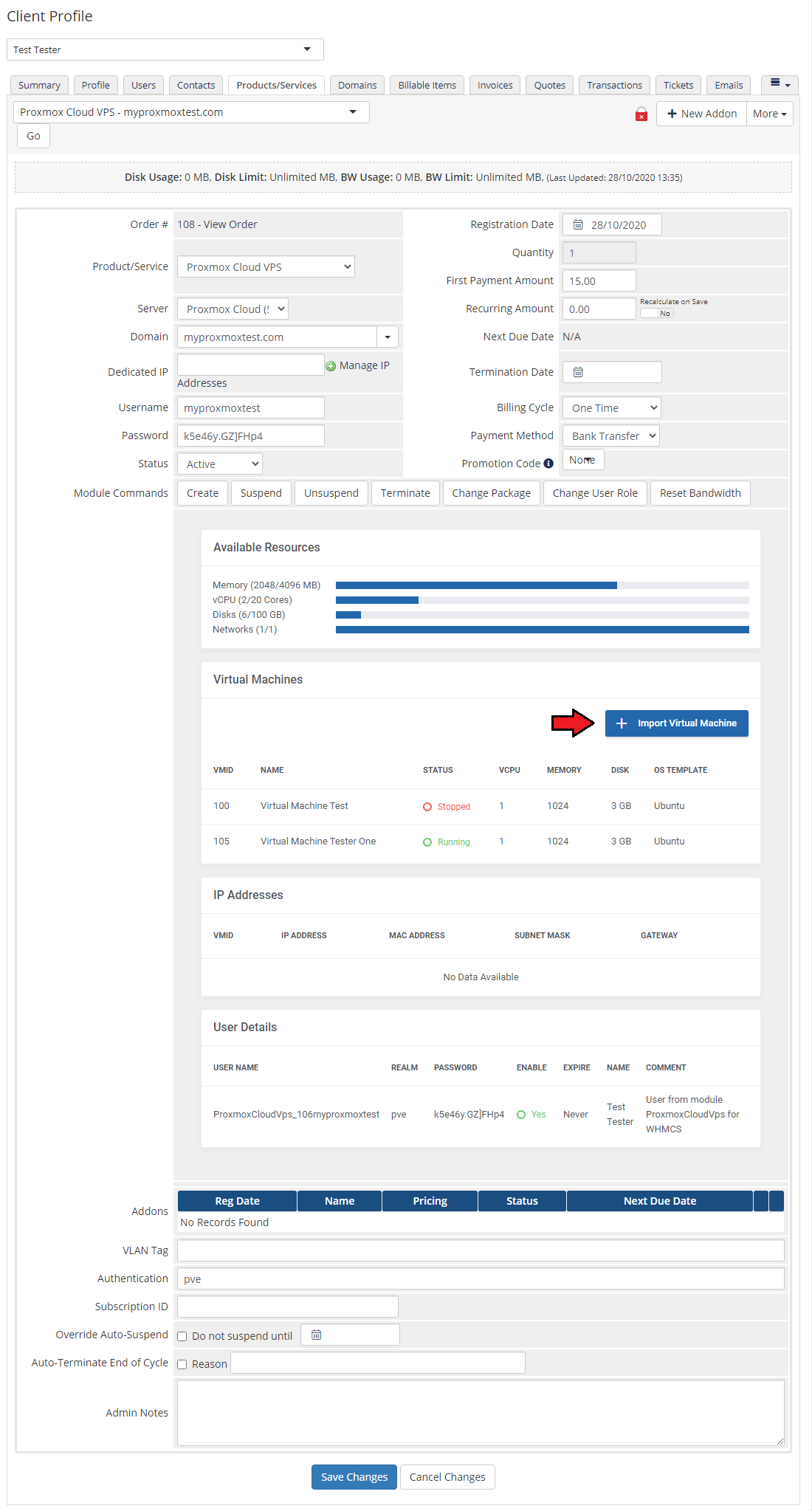
|
| Afterwards, choose the preferred virtual machine from the dropdown menu and complete the 'Password' field.. Confirm importing through pressing 'Save Changes' button. |
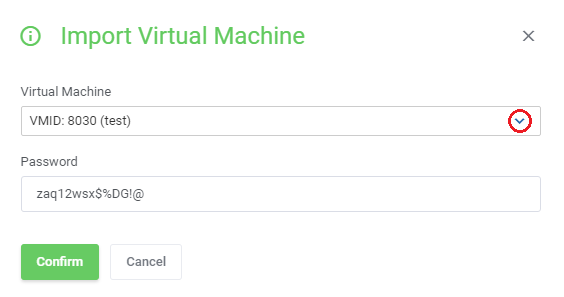
|
Configurable Options
| When you successfully set up a product, your clients can order it by choosing from the default configurable options. Note! If automatically generated configurable options do not seem to fulfill your clients needs, you can edit them using this guide. |
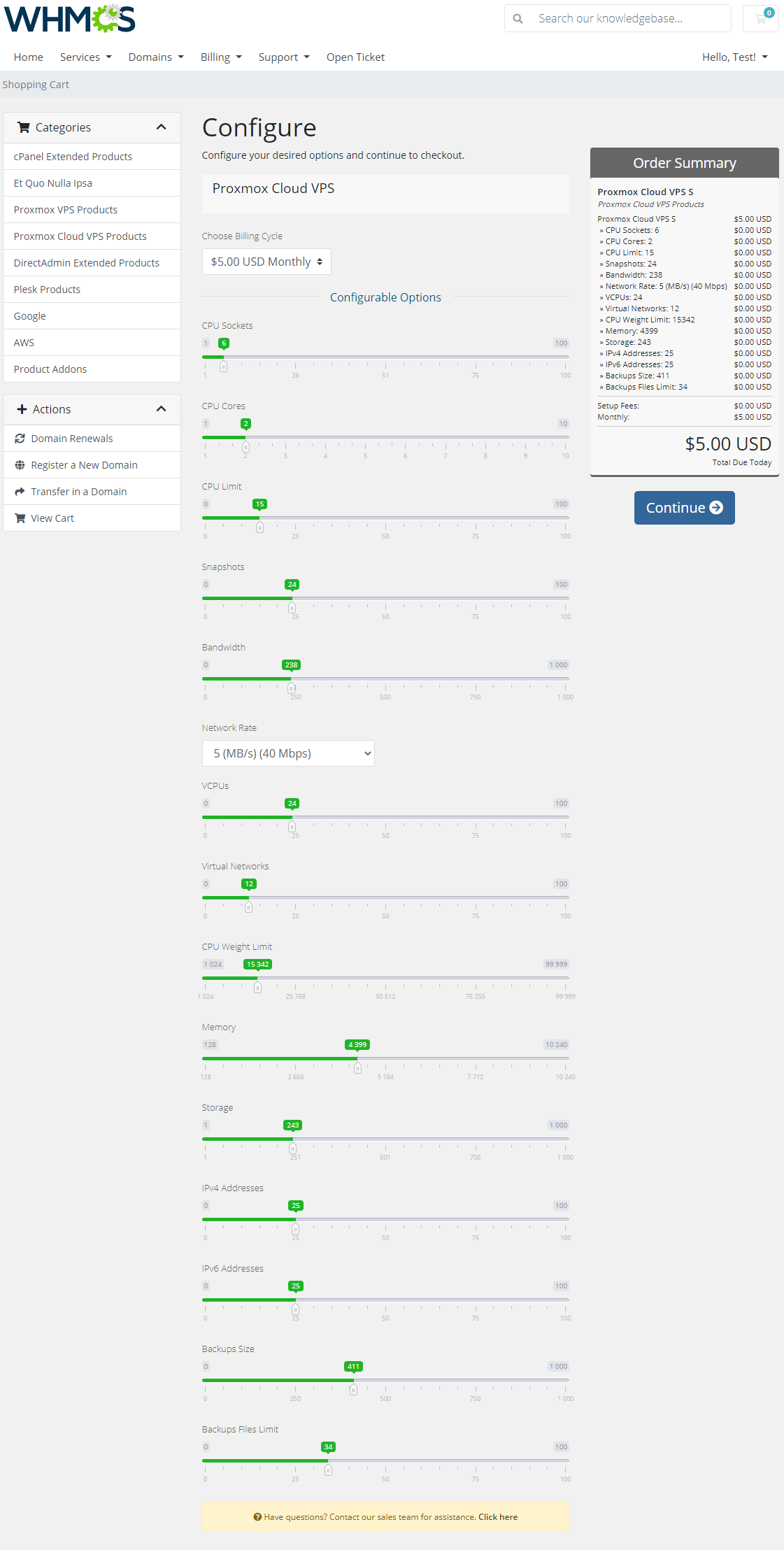
|
Management of Billing
| When you combine Proxmox Cloud VPS For WHMCS with Advanced Billing For WHMCS, you will be able to set up additional billing options. Module allows you to charge your customers basing on the server resources used by them. |
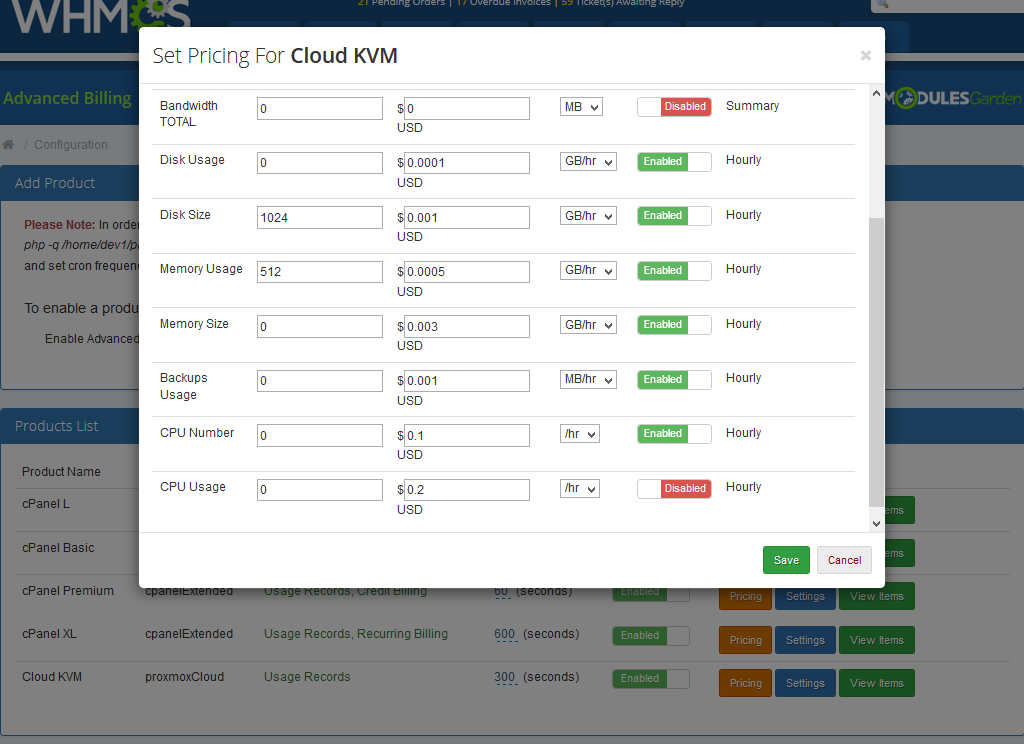
|
| With Advanced Billing For WHMCS module, you can also display your customers current server resource usage and their cost. |
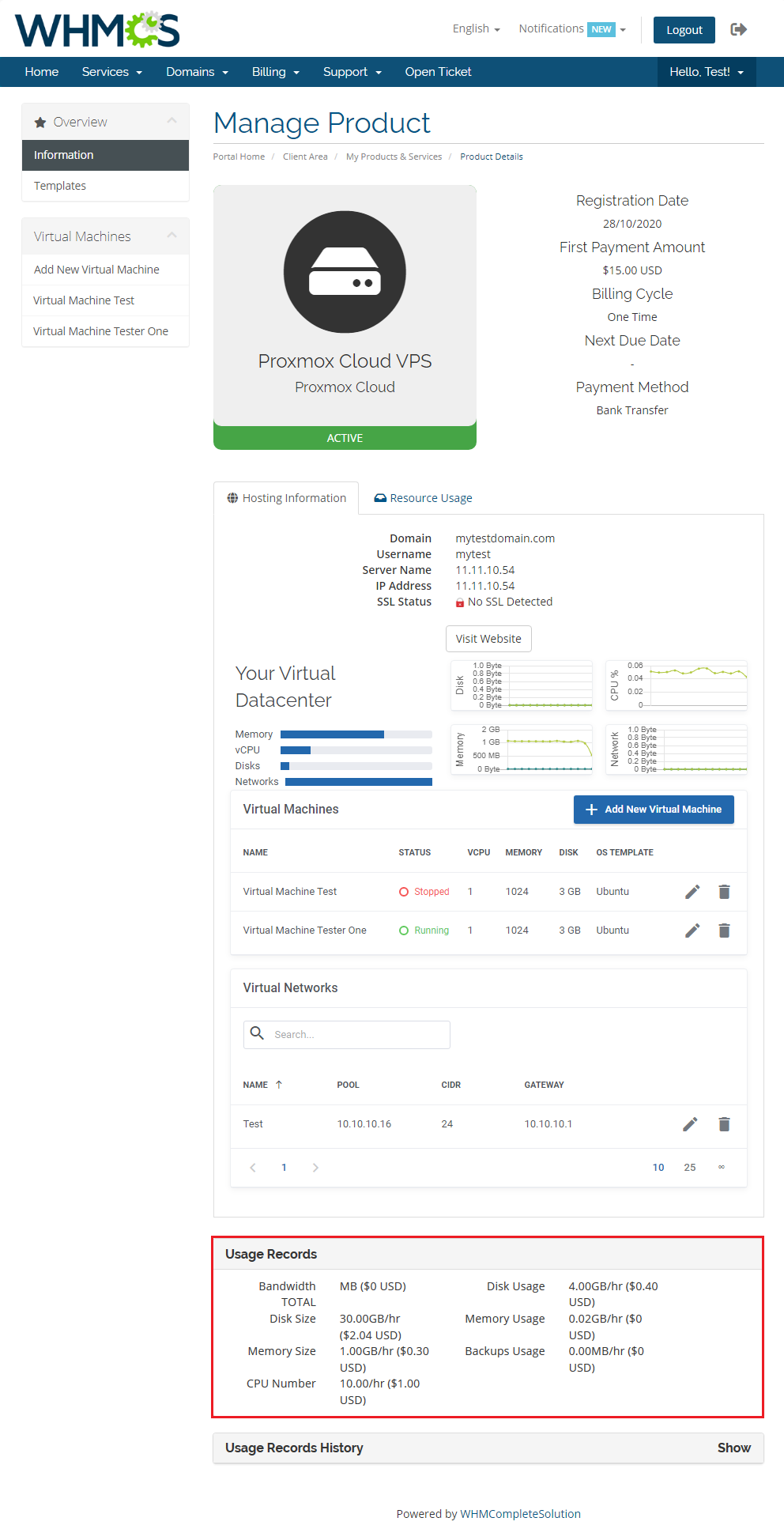
|
Products Autoscaling
| If you want to meet the needs of your clients then give them the possibility to scale provisioned servers according to their current load automatically. To achieve that you need our Proxmox Cloud Autoscaling extension with Advanced Billing For WHMCS product. |
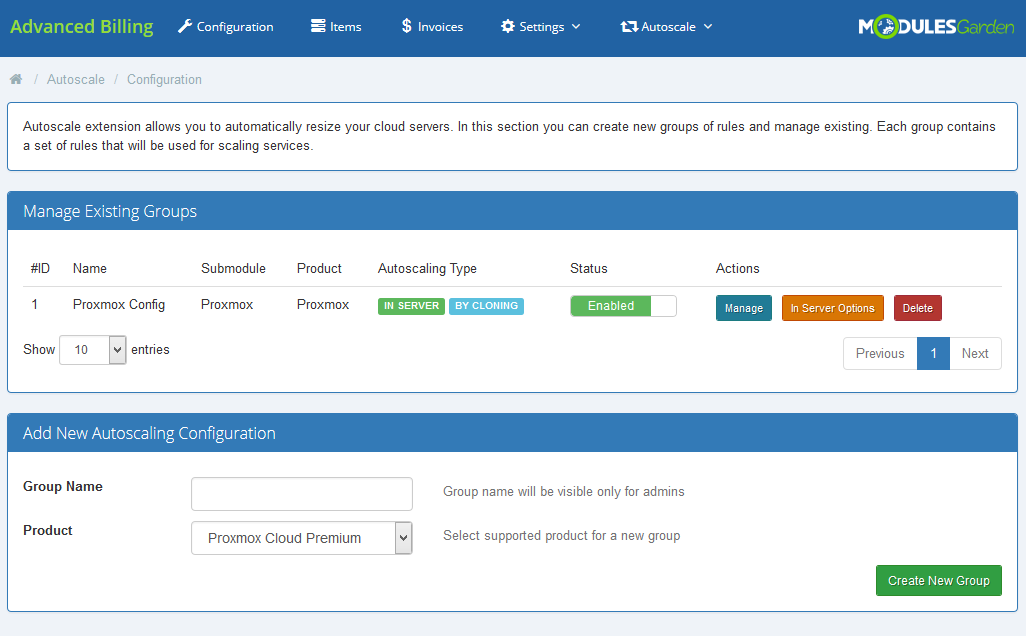
|
| With the combination of these three items, you will be able to formulate a set of rules basing on which specified servers will be modified at the right time. Advanced Billing For WHMCS will bill your clients for the currently used servers and its extension, Proxmox Cloud Autoscaling, will adjust the size of Cloud product to the current needs. |
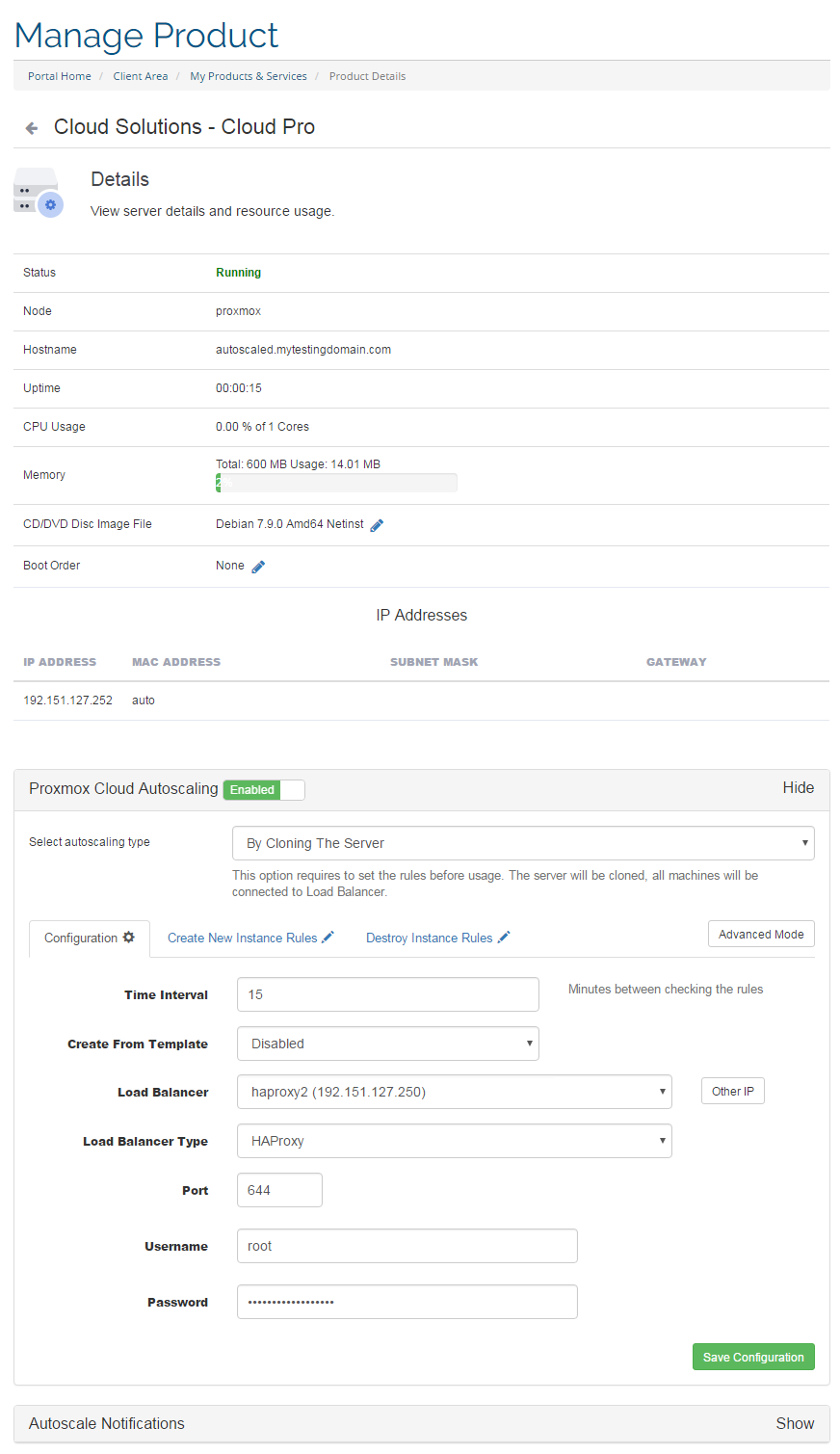
|
Tips
| 1. Operations performed on the virtual servers are not executed immediately. Give your Proxmox Virtual Environment some time for processing the request and execution of operation. |
| 2. Multiple physical Proxmox servers can be joined into one cluster. When they are joined into one cluster, you can access all of them by connecting to any of them. |
| 3. OS Templates are not automatically downloaded while configuring a product. For each virtualization type, templates are downloaded from the Proxmox server depending on which one of them they are generated for. |
4. To name the location accordingly to your needs, within the module change the lang into:
$_LANG['node_X']='Your friendly name for node_X'; |
| 5. When PAM authentication is used it is necessary to create a client first in order to change the password correctly. Read more about it here. |
| 6. As this module supports templates system, any changes made in the module's templates files will be saved after the upgrade process. |
| 7. If you currently use the module in the 2.3.2 version or previous, and would like to migrate to Proxmox VE V5.X, you need to update the files on your Proxmox server to the new version from the 'UploadOnProxmoxServer' folder. |
| 8. You can use the 'IPSet IP Filter' option for firewall to prevent IP spoofing. Click here to read more about IP Sets. |
| 9. 'Minimum Network Rate Limit' option allows you to change the previously entered 'Network Rate Limit' value to a new one if the current 'Bandwidth Limit' is already exceeded. Note that the 'Bandwidth Limit' can also be used for WHMCS overage billing calculation as described here. |
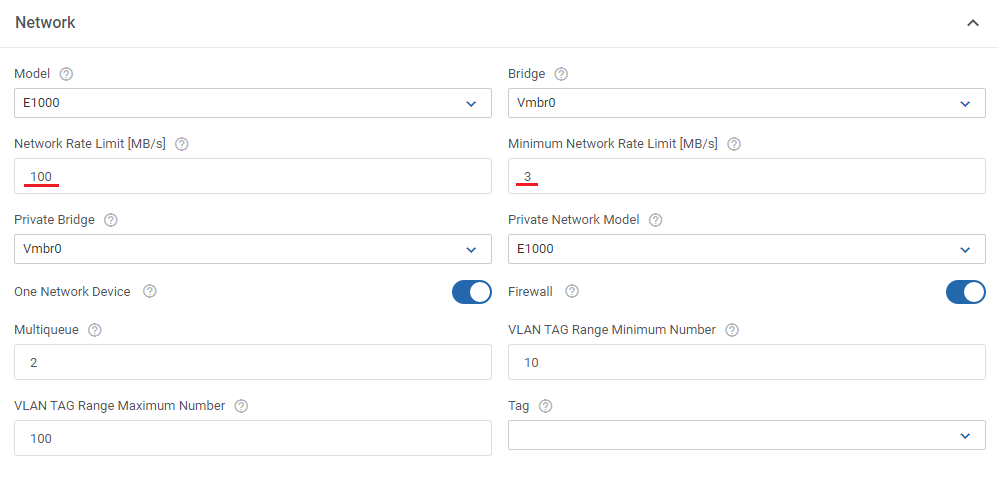
|
Update Instructions
| 1. Essential guidance through the process of updating the module is offered here. Keep in mind there is a quick and easy option in our client area that will let you upgrade the license of your module to an open source version at any time - and at a lower price! |
2. To upgrade the module from Proxmox Cloud For WHMCS to Proxmox Cloud VPS For WHMCS correctly, you need to follow these steps:
your_whmcs/modules/servers/proxmoxCloud
your_whmcs/modules/servers/proxmoxCloud/cron/cron.php
5-minute interval suggested for: php -q your_whmcs/modules/addons/proxmoxAddon/cron/cron.php queue php -q your_whmcs/modules/addons/proxmoxAddon/cron/cron.php update-server-usage 1-hour interval suggested for: php -q your_whmcs/modules/addons/proxmoxAddon/cron/cron.php rrddata
Important! Please remember to reissue the licence in the client area after uploading new files to the main WHMCS directory.
|
Common Problems
| 1. When you have problems with connection, check whether your SELinux or firewall does not block ports. |
| 2. Error 'Could not create PVE2_API object' during connecting via noVNC console. Reason: User account does not have permission to access noVNC console. |
| 3. Error 'This connection is untrusted' during connecting via noVNC console. Reason: Your certificate is not valid. |
| 4. Blank page during connecting via noVNC console. Reason: You have not uploaded the additional files on the Proxmox server. |
| 5. Error 'Function "ssh2_connect" does not exist. Please Install SSH2 PECL before you start using the script.' Reason: You have not updated php.ini file |
| 6. After you have updated your Proxmox Cloud For WHMCS to Proxmox Cloud For WHMCS V2.0.0, it is always required to save your product configuration in module settings again. |
| 7. If you see an error: 'Invalid VLAN TAG Range' configuration or other when trying to add a new private network, please make sure you have completed all required options in Module Settings. These are: 'Network Device' → 'Private Bridge', 'VLAN TAG Range From' and 'VLAN TAG Range To'. |
| 8. 'OS Architecture Type ' option for LXC virtualization type is currently not supported as it not implemented in Proxmox itself. We are sorry for inconvenience. |
| 9. Error: "Only root can set 'serial0' config". Solution: Turn off the Xterms.js console in the product configuration. |
| 10. Error "Parameter verification failed. ([maxfiles] - Only root may set this option.)" Reason: User is other than "root" or server authentication is set to Proxmox VE |